Make an Enquiry

- Yacht Sales
- Destinations
- About Ahoy Club

The Anatomy of a Yacht | Superyacht Terminology
Whether cruising with family and friends or enjoying an adventurous sailing trip, yachts can offer everything you need for the perfect holiday. Before stepping board, it can be useful to familarise yourself with the parts of a yacht to understand the language and terminology used by the crew onboard, and to appreciate how these impressive vessels work. From the keel to the sails, it's important to understand the anatomy of any vessel before setting out on a chartering journey.
The Parts of a Yacht - An Overview
Understanding the parts of a yacht not only improves your sailing experience but will also increase your appreciation of these powerful vessels. A standard yacht has several key parts, including a stern, hull, and bow. The stern, or aft, refers to the back the yacht, sometimes accompanied by a swim platform. On the other end of the vessel, the bow refers to the front of the yacht. The part of the yacht that floats in the water is referred to as the hull. Most traditional yachts have one hull, however catamarans are typically ‘multi-hull' having two points of contact with the sea.
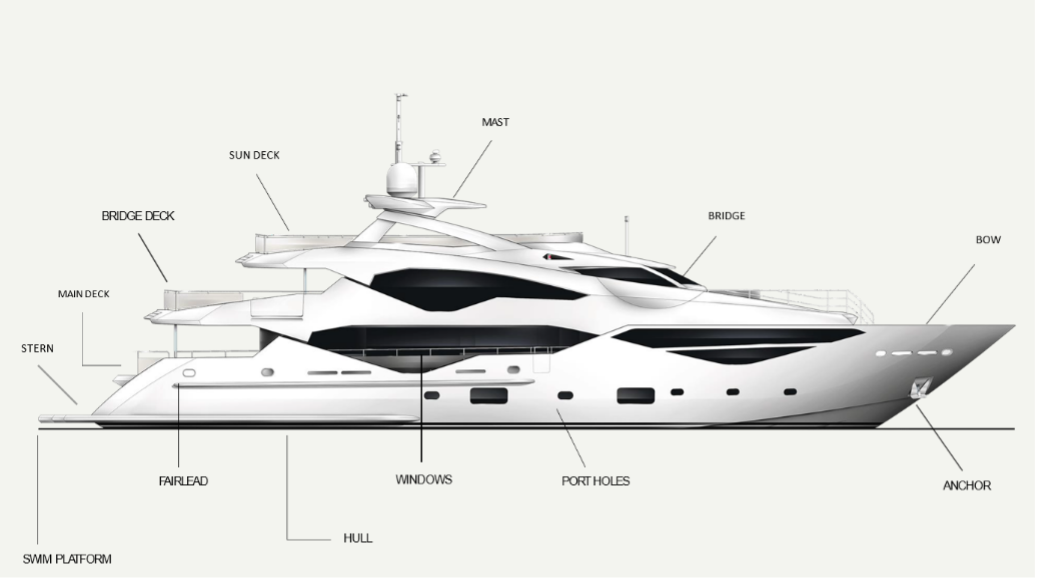
Mischief superyacht was designed with an iconic French navy hull and white boot stipe.
Hulls – Materials and Design
As hulls are one of the largest components of a yacht, it is important that the design is intentional to withstand the elements on the ocean. The material that is it constructed of varies depending on the vessels size and intended use; it is common to see hulls made from wood, steel, or composite materials. Hulls play a crucial role is ensuring stability on board and a smooth journey as conditions on the ocean can vary.
Bridge & Bridge Deck
Port side & starboard side.
These terms refer to the left and right sides of a yacht; Port side refers to the left side, while starboard side is the right. A helpful tip is to remember the saying “there is a little bit of port left in the bottle.” This terminology is often used by crew in order to effectively communicate with their team in order to avoid accidents and safely navigate the seas, so you will likely hear these terms onboard your stay.

Lady Pamela’s large swim platform ideal for fishing or setting off paddleboarding.
Yacht Main Salon and Swim Platform
There is plenty of fun to be had in these two areas of a yacht. The main salon refers to the main living room onboard and is a space where yacht designers can showcase their personality in the design. Often featuring plush seating, stylish decor and high-end entertaining systems, guests can comfortably enjoy downtime relaxing and socialising in this area. The swim platform is exactly what it sounds like; it offers a convenient way to jump in to cool off and enjoy the water. When you feel it’s time to take a dip, the swim platform is the perfect spot to soak up the sun, enjoy the available watertoys , dip your feet in the ocean, or take a refreshing dive or snorkel in the sea.
All of these elements are thoughtfully designed by experts across the world to construct the magnificent yachts that we know and love. We encourage you to experience our favourite vessels for yourself through luxury yacht hire to appreciate the impressive design and craftsmanship. Our team is here to help you plan your dream holiday on board today.
You May Also Like

mischief superyacht

sirenuse superyacht

Luxury Yachts | Choosing the Right Yacht for You
Make an enquiry.

- Find A School
- Certifications
- North U Sail Trim
- Inside Sailing with Peter Isler
- Docking Made Easy
- Study Quizzes
- Bite-sized Lessons
- Fun Quizzes
- Sailing Challenge

The Anatomy of a Boat
By: Zeke Quezada, ASA Equipment , Learn To Sail , Sailboats
Do You Know the Parts of a Boat
Learning to sail is not just about feeling the wind in your sails. You also become familiar with the vessel that will be part of your new lifelong adventure. A sailboat can seem daunting with all its moving parts, but it is quite simple.
I recently learned the term Keel Hauling, and I was a bit shocked at not knowing the reference. When you sail, you take on an entirely new language of words, sayings, and jargon. A few of us sailors even embrace the same Jimmy Buffet songs as part of our perennial sailing playlist. (that is another story for a different time)
My wife, who has sailed for over 20 years, is competent under most conditions at sail and knows her way around our vessel, but I was surprised that she didn’t know some of the simple terms that we sailors use daily. There are some fundamental terms that all sailors learn as they begin their sailing career and the rest of the information follows along as you spend more time on the water.
When you embark on a sailing education in ASA 101 Basic Keelboat Sailing, you learn about the anatomy of a boat. These are part of the fundamentals of sailing. While these few terms are interchangeable among boats, they certainly are not the only terms you’ll learn, but they are the beginning of a new language when you become an ASA certified sailor.

This is a keelboat. It is different from a dinghy in that it is larger than 20 feet and has a keel. Keelboats start at around 20 feet with no upper limit in length. A 200-foot megayacht is considered a keelboat.
Sailboat Terminology

Dinghy – A small sailboat usually under 20 feet long and open for most of its length.

Keel – A fixed appendage on the bottom of the hull that provides sideways resistance needed to counter the force of the wind on the sails. The keel also carries ballast , usually iron or lead, the weight of which counteracts the force of the wind that causes a sailboat to heel , or lean over.
Hull – The watertight structural shell of a boat.
Bow – The forward part of a boat
Stern – The aft part of the boat.
Transom – The more or less flat surface that closes the hull at the stern
Rudder – The sailboat is steered by a fin-shaped appendage attached beneath the boat toward the stern which can be rotated to change the angle at which the water strikes it. Water must flow past the rudder in order fo rit to work so it will not turn the boat while at rest.
The rudder is controlled by a wheel or a tiller at the helm of the boat. The person steering the boat is the helmsman .
Cockpit – The area of the boat, usually recessed into the deck , from which the boat is steered and sailed.
Deck – The generally horizontal surface that encloses the top of the hull.
Companionway – The entrance from the cockpit or deck to the cabin.
Stanchion – A metal post that supports lifelines .
Lifeline – A wire supported on stanchions around the perimeter of the deck to prevent crew from falling overboard.
Pulpit – A guardrail at the bow or stern of a boat to which (usually) the lifelines are connected.
Learning to Sail
- ASA 101: What You’ll Learn ASA 101 is your introduction to Basic Keelboat Sailboat and is your key to a lifetime of sailing.
- How To Sail Sailing a boat is part art and part skill but few activities offer such a variety of pleasures as sailing. Something special occurs when you cast off the lines and leave your cares at the dock.
- 7 Tips For The Beginning Sailor There are the obvious things you need when you go sailing, sunscreen, a hat, a windbreaker, non-skid shoes, and wind. However, what do you really need to be ready to head out on the water?
- How To Learn To Sail You won’t have to buy a boat or learn a new language or buy a new wardrobe to get a taste for sailing. You can dictate how much you want to experience.
- Learning To Sail Is Just The Beginning Sailing means different things to different people. At ASA we understand that learning to sail is just the beginning of a relationship with a lifestyle that is infectious. Where will sailing take you? We have a few ideas but how you view sailing is the most important.
- What Is Your Role on a Boat? What type of sailor are you and what role do you take on the boat? Your ASA sailing education will prepare you to be a skipper on a sailing vessel and with that comes the responsibility of keeping your crew safe and ensuring the safety of the vessel you are sailing.
Related Posts:

- Learn To Sail
- Mobile Apps
- Online Courses
- Upcoming Courses
- Sailor Resources
- ASA Log Book
- Bite Sized Lessons
- Knots Made Easy
- Catamaran Challenge
- Sailing Vacations
- Sailing Cruises
- Charter Resources
- International Proficiency Certificate
- Find A Charter
- All Articles
- Sailing Tips
- Sailing Terms
- Destinations
- Environmental
- Initiatives
- Instructor Resources
- Become An Instructor
- Become An ASA School
- Member / Instructor Login
- Affiliate Login

- Charter a Yacht
- Yachting News & Stories
Home » The Essential Guide to Yacht Parts: Exploring the Key Components
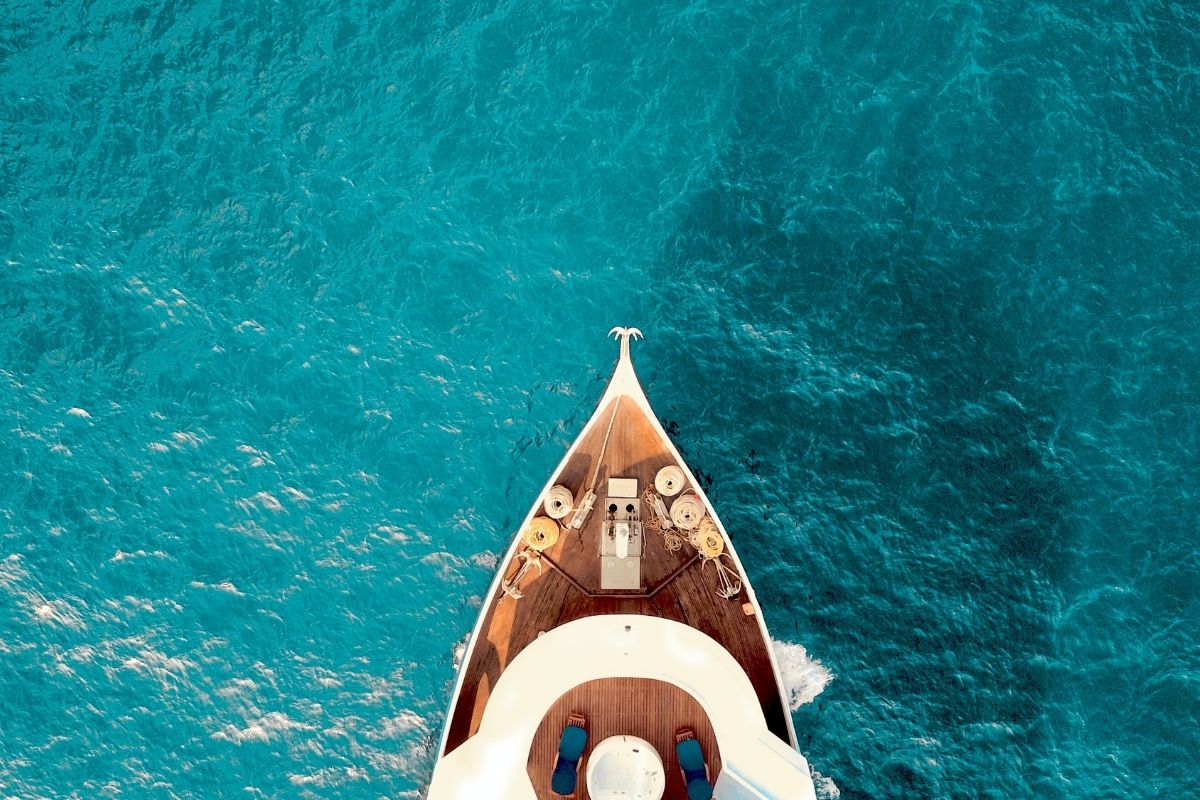
The Essential Guide to Yacht Parts: Exploring the Key Components
Whether you’re a seasoned sailor or a budding yacht enthusiast, understanding the various parts that make up a yacht is crucial. From the bow to the stern, every component plays a vital role in ensuring a smooth and safe sailing experience. In this comprehensive guide, we will explore the essential yacht parts, their functions, and why they matter.
1. The Hull: The Foundation of Your Yacht
The hull is the main body of the yacht and serves as its foundation. Typically made of fiberglass, steel, or aluminum, it provides buoyancy and keeps the vessel afloat. Its design and shape impact the yacht’s stability, maneuverability, and speed. The hull is divided into sections, including the bow (front) and the stern (rear), each having specific functionalities.
2. Propulsion System: Powering Your Yacht
The propulsion system is responsible for moving your yacht through the water. It consists of several key components, including the engine, propellers, shafts, and rudders. Yachts may have either an inboard or outboard engine, with inboards being more common in larger vessels. The propellers, attached to the shafts, create the necessary thrust, while the rudders steer the yacht in the desired direction.
3. Deck and Superstructure: Above the Waterline
The deck and superstructure comprise the uppermost part of the yacht above the waterline. The deck provides a surface for walking and relaxing, while also housing various features like seating areas, sun decks, and swimming platforms. The superstructure, typically made of fiberglass or aluminum, includes the cabin, bridge, and other enclosed spaces on the yacht.
4. Navigation and Electronics: Charting Your Course
To ensure a safe and efficient voyage, yachts are equipped with advanced navigation and electronics systems. These include GPS (Global Positioning System), radar, chart plotters, depth sounders, and autopilots. These systems help the captain navigate, track the yacht’s position, and avoid hazards, ensuring a smooth and secure journey.
5. Rigging and Sails: Harnessing the Wind’s Power
For sailing yachts, the rigging and sails are critical components that harness the wind’s power to propel the vessel forward. The rigging consists of various masts, booms, and ropes, which support and control the sails. The sails capture the wind, creating lift and generating the force needed to move the yacht through the water. The design and configuration of the rigging and sails depend on the type of yacht and its intended use.
6. Electrical and Plumbing Systems: Convenience and Comfort
Modern yachts are equipped with electrical and plumbing systems to ensure convenience and comfort while onboard. Electrical systems power lighting, appliances, air conditioning, and navigation instruments. Plumbing systems provide fresh water for drinking and washing, as well as manage waste disposal. These systems make yacht living more enjoyable, especially during longer trips or extended stays on the water.
7. Safety Equipment: Ensuring Peace of Mind
Safety is paramount when out on the open water, and every yacht should be equipped with vital safety equipment. This includes life rafts, fire extinguishers, life jackets, distress signaling devices, and emergency communication systems. These measures ensure the well-being of everyone on board and aid in rapid response during unforeseen emergencies.
From the hull to the safety equipment, understanding the various components of a yacht is essential for any enthusiast or sailor. Each part serves a specific purpose to ensure a smooth, enjoyable, and safe sailing experience. By familiarizing yourself with these essential yacht parts, you’ll have a deeper appreciation for the intricate craftsmanship and engineering that goes into these magnificent vessels.
So, whether you’re dreaming of owning a yacht or simply fascinated by their complexity, this guide has provided an overview of the key components that make up a yacht. Embark on your yacht journey with confidence and knowledge, and enjoy the wonders of the open sea.
If you like this type of content, we recommend you to check our other blog posts about various yacht destinations around the world by clicking here!
Other Blog Posts
Afloat majesty: exploring the world's largest yacht.
In the world of luxury yachts, where opulence knows no bounds, one vessel stands head and shoulders above the rest—the world's largest yacht. With its..
Exploring Antarctica by Yacht: Is it Possible?
Antarctica, the frozen continent at the southernmost tip of the Earth, has long fascinated adventurers, scientists, and explorers. Its extreme environment, pristine landscapes, and unique..
Exploring the World of Yachts: A Guide to Different Types
Yachts, often associated with luxury, leisure, and a life of opulence on the open water, come in a fascinating array of types and sizes. Each..
The Best-Known Turkish Yacht - 'Dilbar’
In the world of luxury yachting, Turkey has earned a reputation for crafting some of the most exquisite and innovative vessels afloat. Among these magnificent..
No products in the cart.
Sailing Ellidah is supported by our readers. Buying through our links may earn us an affiliate commission at no extra cost to you.
The Different Parts Of A Sailboat Explained
A sailboat consists of hundreds of parts, each with its specific term and function. From stern to bow, keel to mast, each part and its equipment plays a vital role in making the vessel seaworthy and able to sail.
In this guide, I’ll show you most of the components so you can better understand what they are and their function. We’ll begin with the main components, move to the basic features, and finish with our interior and equipment.
The main parts of a sailboat
The main parts of a sailboat are the key components that make it a vessel able to sail. You’ll notice that the structure has several distinct differences from powerboats.
We can categorize the main parts into the following:
- Hull: The main structure, or “body” part of a boat.
- Keel: The heavy fin at the bottom allows stability under sail.
- Rudder: The fin sticking down at the stern, allowing us to steer the vessel.
- Mast: The “spars” or “poles” holding the sails.
- Rigging: The standing rig is the wires that supports the mast. The running rigging is all the lines that control the sails.
- Boom: The horizontal spar supporting the bottom of the mainsail.
- Sails: The canvas used to harness the energy of the wind.
Let’s dig a bit deeper into each of the components.
Hull – The main structure
A sailboat’s hull is the vessel’s main body or structure. The shape is vital to the boat’s performance and stability, and you have probably seen boats in many different forms. Older vessels are typically narrow, with a rounded underbody and a small stern. Modern designs have a flatter belly and broad stern supporting dual helm stations.
One of the hull’s primary functions is to displace water and provide buoyancy to keep the boat afloat. The hull is also the structure that holds the vessel’s living compartments and all its equipment. The main structure must be strong enough to withstand the forces of the water and any rough weather conditions that Mother Nature might throw at it.
Fiberglass (GRP), steel, aluminum, and wood are the most commonly used hull materials, each with pros and cons.
You can learn more about hull materials and their strengths in this article .
A monohull is a type of sailboat that has a single hull. Monohulls are classified into two categories based on weight and shape: planing and displacement hulls.
Sailboats with more than one hull are called multihulls. There are two types of multihulls: catamarans, which have two, and trimarans, which have three. These boats are typically designed with planing hulls.
Keel – The fin under the boat
The keel of a sailboat is a structural fin that extends downward from the bottom of the hull. There are several types of keels, each with unique characteristics and advantages. They all serve the same fundamental purpose of stabilizing the boat when we sail by adding lateral resistance in the water and weight at the vessel’s bottom.
Standard keel designs include:
- Lifting Keel
Some sailboats have a retractable centerboard functioning as their keel, allowing them to take the boat into shallower areas.
Rudder – To steer the boat
The rudder is a flat surface that sits perpendicular to the waterline. It is connected to the boat by a pivot point, allowing it to swivel left and right. When the steering wheel or tiller is turned, the rudder moves, creating drag in the water causing the boat to turn. The size and shape of the rudder can vary depending on the size and type of boat.
The most commonly seen rudder designs:
- Full skeg-supported
- Semi skeg-supported
Skeg-supported rudders are structurally one of the most reliable and robust constructions, but they are less efficient than a balanced rudder performance-wise. Balanced rudders pivot around their vertical center, giving less drag in the water and higher maneuverability at the cost of being a more vulnerable construction.
Twin rudders are often seen on modern performance sailboats with a wide stern. When the sailboat heel over , the leeward rudder gets better track through the water than a single rudder placed at the vessel’s center line. Contrary to some misconceptions, they can’t be controlled individually, even if the boat has two steering wheels.
Mast and Rigging – Supporting the sails
The mast is the long vertical spar that extends upward from the deck of a sailboat and holds the sails. It is the tallest part of the boat and is typically made of wood, aluminum, or carbon fiber. The mast is held in place by stays and shrouds, which form the sailboat’s standing rigging.
Depending on the rig the boat is manufactured with, there are several different types of masts. For example, a sloop-rigged sailboat will have only one main mast, while a ketch-rigged vessel will have a smaller additional mizzen mast placed further aft from the main mast.
There are two types of rigging:
- The Standing rigging consists of the stays and shrouds that keep the mast or masts in place.
- The Running rigging is the lines we use to hoist, lower, and control the sails.
Pro Tip: “S par” is a general term for a pole made of a solid material like wood, metal, or composite and is used to support a boat’s sail. The mast, boom, spreaders, and poles are defined as spars.
Boom – Supporting the mainsail
The boom is a horizontal beam extending from the mast and supporting the mainsail’s tack and clew (bottom two corners). It is attached to the mast by a hinge called a Gooseneck .
We use the boom to control the shape and angle of the mainsail to optimize its efficiency and power. Some booms also have a Vang or Rod-Kicker installed to assist in trimming the mainsail.
Sails – The canvas used to harness the energy of the wind
Most vessels have at least two sails, depending on the rig type and boat setup.
The Mainsail flies behind the mast, on top of the boom. Although it may not always be the largest sail on the vessel, we commonly refer to it as “the main.”
The Headsail(s ), located in front of the mast, are often of different sizes and shapes, and many sailboats have more than one. The Jib and Genoa are two of the most common types.
Different types of sails are used for various sail plans and situations, and you can learn more about them in this guide .
Now that we had a look at the main parts of the boat, let us dive deeper and look at the rest of the vessel.
The starboard and port side of the boat
Learning about the boat’s components is very important, but we must also know how to orient ourselves on the vessel. Using the words “left and right” on onboard often leads to confusion.
If you refer to something on the left side of the boat, the person facing you will be confused. He won’t know if you are referring to his or your left. This is where the terms “Port” and “ Starboard ” make better sense.
When facing the front of the boat or the bow , your left side of the boat is the port side, and the right-hand side is the starboard . If you turn around and face the back of the boat or the stern , your right-hand side will be the port side.
- A red light identifies the port side of a vessel.
- A green light identifies the starboard side of a vessel.
Windward and Leeward
- The windward side of the boat is the side facing the wind. If the wind comes from your right-hand side while facing forward, the starboard side is windward. This will be the boat’s high side as the wind heels the boat over.
- The leeward side of the boat is the side opposite to the wind. This will be the lower side of the ship while sailing as the wind heels the boat over.
Windward and leeward are two of the most important aspects to understand when sailing and navigating. Not only to identify equipment and gear on each side of the boat but to avoid collisions when sailing close to other vessels. There are rules on the water dictating which boat is “Stand On” and which has to “Give Way” depending on whether you are the windward or the leeward vessel in the situation.
Read this article to access a free course on navigation rules .
Basic parts of a sailboat
The boat’s bow is the front part, typically shaped like a “V” to cut through the waves. Larger vessels often have a locker for their anchor chain in this section, holding the anchor at the front.
The midship section is the center of the boat. Some refer to this part as amidships.
The stern is the rear or back part of the boat. It is also referred to as the aft . I’ve had French crew calling the stern the butt of the vessel, which is funny but also correct!
The beam is the widest part of the boat. Also referred to as the sides on the middle.
The transom is a flat surface across the stern of the boat.
The waterline is the part where the hull (body) of the boat meets the water. Many vessels have a painted stripe to mark the waterline, indicating how loaded the ship is. If you have too much stuff on board, the waterline goes underwater, and it is time to do some housekeeping!
The freeboard is the vertical part of the ship side between the water and the deck. When you see a blue boat like Ellidah, the freeboard is the blue part.
The deck is the “floor” of the boat when you are outside. You have probably heard the term “All hands on deck!” The front deck is the deck space in front of the mast. Side decks are the decks on the boat’s sides.
The mid-deck is between the cockpit and the mast. The aft deck is the deck behind the cockpit. Sailboats with aft cockpits often don’t have any aft decks, but some have a swimming platform instead.
The cockpit is the boat’s steering position and where you will find the helm.
The helm is the position the helmsman uses to steer the boat. Smaller sailboats often use a tiller to navigate, while most bigger yachts have one or two steering wheels.
Main parts below deck (inside the boat)
Let us look at the interior to highlight and learn about the parts we have below the deck.
The Companionway
The companionway is the “front door” of the boat. This is where the steps lead from the cockpit or deck down below. It is usually opened and closed using a hatch, two doors, or a plate.
The Galley
The galley is the boat’s kitchen. This is where sailors prepare their delicious meals.
The Saloon
The saloon is basically the boat’s living room, usually where you find the settee and dinette. This is where delicious meals from the galley are served together with refreshing beverages in good company.
The settee is the sofa or couch in a boat. It is also used as a sea berth to sleep in when sailing.
The dinette is the area where you can sit down at a table and eat your dinner. It’s also perfect for consuming rum and a game of cards in good company.
A cabin is often used as a bedroom in a boat but is not necessarily where you sleep. Many boats have more than one cabin.
A berth is a place in the boat where you can sleep. This doesn’t necessarily have to be a bed and can often include the sleeping space in the saloon. Sea-berth usually refers to a sleeping position where you are tucked well in and can sleep when the boat is heeling over and moving around.
The head is the toilet on a boat. If your skipper tells you to go and clean the head, getting out the shampoo won’t do you any good!
Nav station
The navigation station is usually a chart table and a console with mysterious instruments like radios, switchboards, and complicated electronics. This is where adventures are planned and the skipper’s favorite seat onboard.
The bilge is a space in the bottom of the hull where water collects and sometimes a storage space for all sorts of things. It usually contains a bilge pump to pump out water that finds its way into the boat in various places.
A v-berth is a bed in the front cabin shaped like a V.
A bulkhead is a wall inside the boat, usually supporting the structure.
Hardware and Equipment
Sailboats come equipped with a variety of different hardware and equipment. While the specific items may vary from boat to boat, there are some essentials that nearly every sailboat has.
A winch is a metal drum that gives you a mechanical advantage and is used to control and tighten lines. These can be operated by turning a line around it and pulling manually or by a winch handle to get more force.
Most modern winches are so-called “self-tailing,” which means they lock the line on so you can winch the line without holding on to it. Some boats even have electrical winches operated by a button.
A cleat is a fitting used to fasten a rope. Most boats have at least 6 of these. One on each side on the bow, midship and stern. These are used to secure the boat to a mooring buoy or key. Many ships have more cleats than this for various lines and ropes, and they can be used for anything as they are strong points fitted to the hull.
The sprayhood is the boat’s windshield that protects the people in the cockpit from sea spray. Some vessels have a canvas sprayhood that can be folded down or removed. Others have solid sprayhoods, often called a hard dodger or a doghouse .
The bimini is the cockpit’s “roof.” It protects you from the elements and shelters you from spray, rain, and burning sun rays! A bimini can be made of canvas or hard material. A hard bimini can also be called a hardtop .
Dinghy
A dinghy is a little boat you use to get from the mothership to shore when you are at anchor, also called a tender or annex . It can be everything from a small inflatable rubber kayak to a RIB or even a solid boat.
An essential and valuable piece of kit as it is the daily driver for most cruisers. It is like the car of a land crab, used for all commuting on the water and hauling important stuff like beer, rum, and food onboard. Dinghies often have electric or petrol engines, which we call outboards.
Dinghies are also great to use for watersports, such as wakeboarding!
Like Captain Ron said in the movie, fenders are the rubber bumper things you hang off your boat to prevent it from scratching against something like the pontoon or another ship. It is conveniently also used to sit on or as a backrest while relaxing on deck.
A boat hook is a long stick with a hook at the end. Used to grab lines, items, and stuff that is too far to reach by hand, like cushions flying overboard. It is also convenient as a tool to push the boat away from another craft or the key. Most vessels have them on board.
The guard rail can be a flexible wire or a solid metal rail surrounding the boat to prevent us from falling overboard. Some also use a net as an addition for increased safety.
The pushpit is a metal guard rail around the stern of the boat. This is where the guard rail is secured on the stern: a common place to mount the BBQ, life raft, and the outboard for the dinghy.
The pulpit is the metal guardrail on the bow. This is where the guard rail is secured onto the bow.
The stanchions are the metal bars that keep the guard rail in place around the boat between the pushpit and the pulpit.
An arch is a typical structure made of stainless steel on the back of a boat and is often used to mount a variety of items like antennas, radars, solar panels, wind generators, etc. It is also convenient to use for lifting the dinghy and its outboard.
Ground Tackle
The ground tackle consists of several things:
- Your anchor
- Your anchor chain
- The link between the two
- The connection between the chain and your boat
It includes all equipment holding your boat to the ground. Larger boats sometimes have two anchors on the bow.
A windlass is a winch that hoists and lowers the anchor and chain. Most boats have one on the bow and some on the stern. These incredible things can be electrical or manual (some are both) and are essential to anchor your boat when not in a port or marina.
VHF stands for “Very High-Frequency Radio.” It broadcasts on the VHF network and allows you to communicate with others around you. Sadly, you won’t be able to tune in to your favorite radio show on these.
Still, they are essential for contacting other boats and port authorities. It is also the radio you will transmit an emergency mayday over in case of emergency. VHF radios sometimes require a license, depending on the country you are in.
Chartplotter
A Chartplotter is a navigation computer that shows various information on a screen, like charts, routes, radar images, etc. It is another vital piece of equipment that helps you navigate and maneuver the boat.
Final words
I hope this guide has been helpful and not too overwhelming for you. We’ve covered many of the parts of a sailboat and its terms and functions, but this article only touches on the basics. If you want to keep learning about sailing, I have written several other guides to help you get started.
Now that you have a basic understanding of sailboats, it’s time to take the next step and dive into a sailboat’s standing rigging .
Sharing is caring!
Skipper, Electrician and ROV Pilot
Robin is the founder and owner of Sailing Ellidah and has been living on his sailboat since 2019. He is currently on a journey to sail around the world and is passionate about writing his story and helpful content to inspire others who share his interest in sailing.
Leave a Reply Cancel reply
Your email address will not be published. Required fields are marked *

Parts of a Boat (Illustrated Diagram of a Boat’s Anatomy)
Posted on Published: April 13, 2022 - Last updated: June 13, 2022

Just like a car or truck or animal, there are many parts of a boat, all of which are unique to a boat. When you start boating, it’s a good idea to become familiar with boat anatomy and terms. Not only does it save you from looking like an amateur but it can be a safety issue.
The parts on a boat may vary by boat type. For instance, not all boats have a flybridge. That’s unique to certain types of boats . Below is our extensive series of diagrams setting out the main parts of a boat. We use a series of different types of boats and angles to aid understanding. Below our diagram, we expand on the specifics.
Related: Aluminum vs. Fiberglass Boat | Boat Accessories | Where to Buy Used Boat | Hewescraft 180 Pro V Review | Renting a Boat Slip | Types of Boats | Boat Cost | Hard vs. Soft Top vs. Hybrid vs. Semi Top Boat | Buying a Boat | Parts of a Boat Trailer

Parts of a boat explained
- Bow: the front of a boat.
- Stern: the rear of a boat.
- Port: left side of a boat.
- Starboard: right side of a boat.
- Helm: the driver’s seat.
- Gunwale: the top of the boat’s side (upper edge). If water comes higher than the gunwale, it enters the boat.
- Transom: The cross-section of the rear of the boat (stern).
- Pilothouse: Enclosed cabin for driver and passengers. Not all boats have a pilothouse.
- Cleats: Protruding knobs for tying up boats.
- Fenders: Act like bumpers to protect a boat against a dock or next to another boat. Prevent the boat from bouncing into anything solid. Because I keep my boat at a marina slip with a dock on one side and boat on the other, I have four fenders (two for each side). If you keep it at a dock only, you only need two (or more if a longer boat).
- Flybridge: Open area with additional helm on top of a boat’s cabin. Often includes seating for passengers. Found on cabin cruisers, convertible boats and yachts.
- Handrail: Railing on top of the gunwale.
- Beam: The full width of a beat.
- Freeboard: The distance from top of the water (waterline) to the gunwale (the point where water could flow into the boat).
- Draft: The distance from boat’s waterline to bottom (keel) of the boat. This is the shallowest the boat can enter. If propeller drops below the keel, either need to stay in deeper water or lift the motor up.
- Keel: the lowest point of the hull.
- Bilge: The very bottom of the boat. Water often collects in here which requires pumping out. If water fills the bilge it runs the risk of sinking.
Are there other boat parts?
There are for specific types of boats such as a sailboat. Sailboats have many additional parts and are more complex because of the sails. Ships also have many more parts to them as they are large and much more complex vessels. The above boat anatomy diagram is to set out the parts of a boat commonly found on most boats.
Why don’t you include boat accessories, especially required boating safety accessories?
Boat accessories are not standard parts of a boat. I’ve now bought a ton of boat accessories for our boat. Many are required to have on board (life jackets, fire extinguisher, whistle, manual bailer, etc.) but still, they are not part of a boat. Check out our extensive boat accessories article for tons of ideas to make your boat safer and more fun.
Where can you learn about boating including boat anatomy, safety and navigation?
Where I live, all boat operators must have a boating license. To get the boat license, we must take a course first. I took the BoaterExam course which was excellent. I passed the boat exam on my first try. In fact, I sailed through it. We were given 75 minutes for the exam. I had it done in 20 minutes.
Can you take boat operation lessons?
If you live near the ocean in a populated area, chances are there are powerboat classes and courses you can take where they instruct you on the water. I live in Vancouver and there are such options such as Cooper Boating . In the US, check out the USPowerboating website for course locations and options. Generally, there’s more instruction available for sailing than powerboat operation just because sailing is much more difficult to learn.
What about the parts of a boat trailer?
While tightly related to the parts of a boat, we decided to publish a separate article setting out the parts of a boat trailer here .

Parts of a Boat Explained
Captain tyler brady.
- October 5, 2022
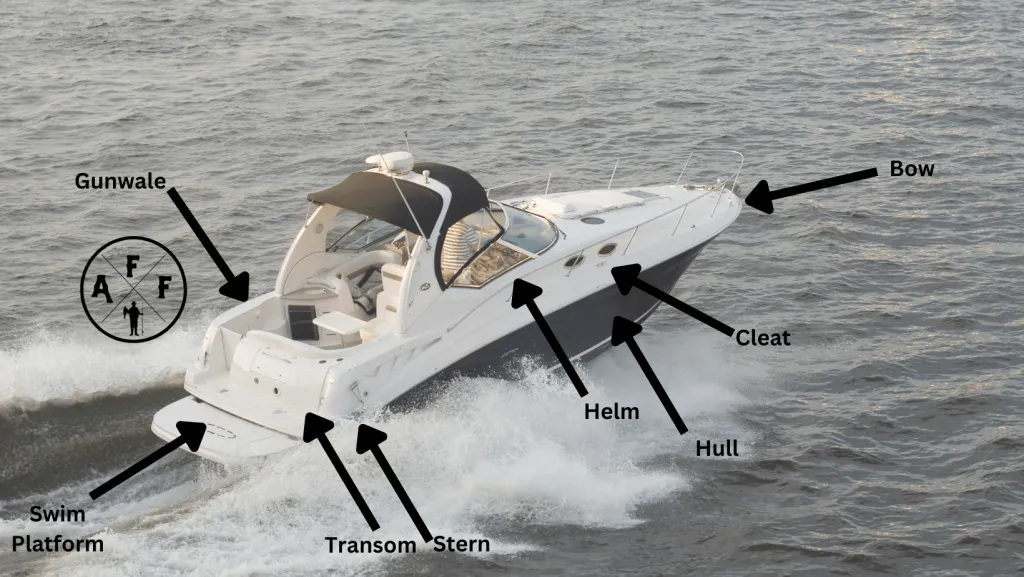
Boat enthusiasts and first-time boat buyers, this post is for you!
We’re going to break down the anatomy of a boat so that you have a better understanding of where different areas are on the vessel. This list will help you when it comes time to buy your boat or speak with a professional about maintaining your boat.
Learning about the parts of a boat is the first step on your journey to becoming an expert in all things boating!
Refer to the list to learn all the different boat parts!
Parts of a Boat Defined
- Aft – The back/stern of the boat
- Beam – The beam of a boat is its width at its widest point
- Bridge – The bridge is an elevated area on the boat where the captain steers the vessel. It’s also a great place to get a good view of everything around you.
- Bow – The bow is the front or forward part of the vessel
- Bilge – The bilge is the lowest internal part of a boat’s hull
- Bulkhead – A bulkhead is a wall that divides compartments on a boat
- Cabin – A cabin is an interior part of a boat that can be enclosed and is often used as a place to sleep while onboard a vessel
- Casting Deck/ Swim Platform – A casting deck or swim platform is the area at the bow or stern of the boat designated for casting while fishing or for entering and exiting the water while swimming.
- Cleat – A cleat is a fitting located on the gunwale of a boat or dock used to secure a rope for anchors, docking, fenders, etc.
- Deadrise – The deadrise of a boat is the angle between the hull and the keel
- Deck – The deck is the flat walking surface of a boat
- Forward – The front part of a boat
- Freeboard – Freeboard is the distance from the waterline to the deck of a vessel.
- Hatch – A hatch is an opening in the deck that provides access to parts of a boat below deck like storage compartments
- Head – The head is a room on a vessel that contains a toilet and sink
- Helm – The helm is the area of a boat where the captain or primary operator stands while driving or piloting the vessel
- Hull – The boat hull is the main body of the vessel that keeps it afloat
- Keel – The keel is a structural element located at the bottom centerline of a boat that helps with stabilization and tracking.
- Livewell – A Livewell is a tank on a fishing boat that is used to store live bait
- Port Side – Port side is the left side of a boat when looking towards the bow.
- Propeller – The propeller is a device located at the stern of a vessel that provides thrust to move the boat through the water
- Pulpit – The pulpit is a railing located at the bow of a vessel
- Running Lights – Running lights are navigation lights located at a vessel’s bow that indicate which way the vessel is moving.
- Starboard Side – Starboard side is the right side of a boat when you are looking towards the bow.
- Stern – The stern is the back or aft part of a vessel.
- Superstructure -The superstructure is the area above the deck that contains the cabin, bridge, hatches, etc. (more commonly used with larger ships compared to a personal watercraft)
- Throttle – The throttle is a lever located at the helm that controls the speed of the vessel
- Rub Rail – A rub rail is a protective trim piece located along a vessel’s gunwale that helps protect the hull from impact.
- Transom – The transom is the flat area located at the stern of the vessel where the outboard motor is mounted
- Waterline – The waterline is the line where the hull of a vessel meets the water’s surface
- Windshield – The windshield is a glass or Lexan panel located at the bow of a boat that helps to deflect wind and spray while underway
- Underside – The underside is the bottom of the hull that is below the waterline
Wrapping Up
There you have it! A complete list of the different parts that make up the anatomy of a boat. Of course, many more details and pieces make up a vessel, but these are the main components you should be familiar with. Now that you know your way around a bit, and become familiar with safe boating practices , then it’s time to get out there and enjoy boating!
Check out the following pages for guides on all the fishing gear you need to get out on the water:
- Best Fish Finders
- Best Fishing Rods
- Best Fishing Reels
- Best Fishing Line
Save 40% on fishing and outdoor gear!
We have partnered with Bass Pro Shops to offer the best deals on high-quality fishing and outdoor gear to our readers. If you click on the button below, we will take you to their exclusive discount page.

Octopus Hooks vs Circle Hooks: Unraveling the Key Differences

Fishing Sinker Weight Chart: Essential Guide for Anglers

Graphite vs Carbon Fiber Fishing Rods: A Comprehensive Comparison for Anglers

Fishing Rods Storage Ideas: Efficient Solutions for Anglers

Best Bass Boat Brands: Top Picks and Expert Insights

Fishing Reels Made in the USA: Comprehensive Guide and Top Picks

Types of Fishing Hooks: Essential Guide for Anglers

World Record Snook: Unveiling the Impressive Catch of a Lifetime
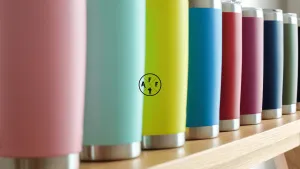
Hydroflask vs YETI Tumbler: The Ultimate Comparison Guide
Leave a comment cancel reply.
Save my name, email, and website in this browser for the next time I comment.
Parts Of a Sail Explained (Illustrated Beginners Guide)
Are you curious about sail mechanics and how they engage the wind? In this illustrated guide, we'll explain the various sail components and how they work together to propel a sailboat. From the head to the foot, the tack to the clew, we'll break down each part and give you a solid foundation to build on as you learn to trim sails and navigate the open sea.
A sail, which is a large piece of fabric that is attached to a long pole called the mast, uses the wind to pull a sailboat across the water. It has various parts, such as the head, tack, clew, luff, leech, foot, mainsail, jib, and batten. These components determine the shape and efficiency of the sail.
Let's break down all these terms and descriptions to understand how each component interacts with each other. So, whether you're a seasoned sailor or a beginner, you'll have a better grasp of sail trim and optimal performance on the water.
- The primary parts of a mainsail include the head, tack, clew, luff, leech, and foot.
- Some critical elements of the jib include the sheet, genoa, and headstay.
- Asymmetrical spinnakers are designed for off-wind sailing and have a more rounded shape, while symmetrical spinnakers are used for downwind sailing and have a more traditional, triangular shape.
- The most common fabrics used for making sails are traditional fabrics like cotton and flax, and modern fabrics such as polyester and nylon, Dacron, Mylar, and laminates.
- Be sure to learn how to properly trim, reef, clean, flake, and store your sails for durability and optimal performance.
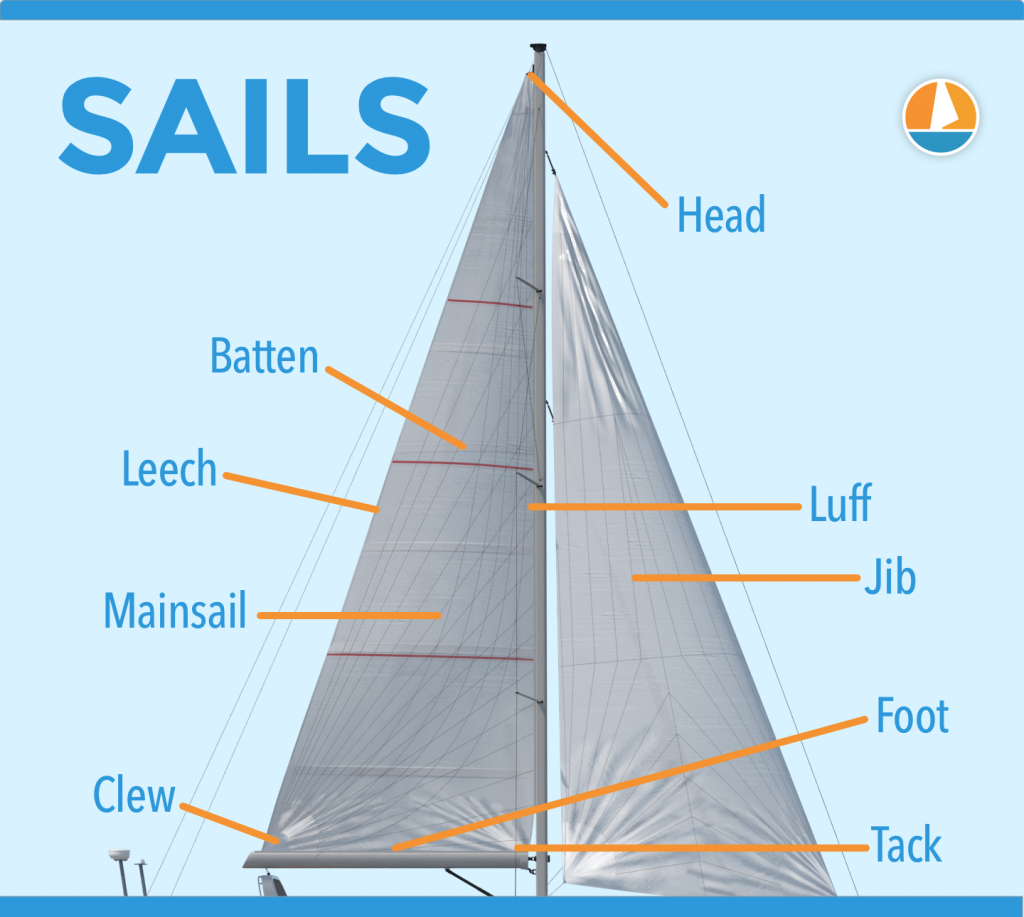
On this page:
Parts of a sail and their functions, mainsail components, jib components of a sailboat, components of spinnakers, sail controls and settings, sail care and maintenance, sail materials and construction.
In this guide, we'll focus on the three main types of sails : Mainsail, Jib, and Spinnaker.
Mainsail is the primary sail on your boat
The mainsail is the largest sail on a sailboat and is typically attached to the mast and boom. It is found aft (rear) of the mast. It's attached to the boat through a track or sail slide, which allows it to move up and down.
Jib is a triangular sail placed in front of the boat
The jib is a smaller sail that is attached to the bow of the boat and works in conjunction with the mainsail to control the direction and speed of the boat. It helps to improve the boat's handling and increase speed, working in tandem with the mainsail.
In some cases, larger jibs called genoas are used to capture more wind, thus increasing the boat's speed.
Spinnaker is designed for sailing downwind
The spinnaker is a large, colorful, and lightweight balloon-shaped sail designed for sailing downwind. It captures the wind from the rear, pushing the boat forward with added speed and stability.
In this section, you'll find a comprehensive explanation of the primary components of a sail and their functions:
Head is the uppermost corner of a sail
The head of the sail refers to the uppermost corner where it connects to the top of the mast. Knowing the location of the head is essential, as it helps you identify the top of the sail and allows you to properly hoist and secure it in place.
Tack is the lower front corner of a sail
The tack is where the lower front corner connects to the base of the mast, or the boom. This important point helps you determine the sail's orientation and affects its overall shape and efficiency. By adjusting the tension at the tack, you can control your sail's performance and handling in various wind conditions.
Clew is the lower rear corner of a saisl
The clew is where the sheets attach to control the sail's angle to the wind. Adjusting the tension on the sheets can change the sail's shape and ultimately influence the boat's speed and direction. Becoming familiar with the clew will help improve your sailing skills and ensure smooth maneuvers on the water.
Luff is the front edge of the sail
The luff is the forward edge of the sail that runs along the mast. It's crucial to maintaining a tight and efficient sail shape. When sailing upwind, pay close attention to the luff, as it can provide valuable information about your sail's trim. A properly trimmed sail will have a smooth luff, allowing the boat to move efficiently against the wind.
Leech is the rear edge of the sail
The leech is opposite the luff. It plays a critical role in controlling the overall shape and efficiency of your sail. Watch the leech carefully while sailing, as excessive tension or looseness can negatively affect your sail's performance. Adjusting your sail's trim or using a device called a "boom vang" can help control the shape and tension of the leech.
Foot is the bottom edge of the sail
The foot is running between the tack and the clew. It helps control the shape and power of the sail by adjusting the tension along the boom. Ensure the foot is properly trimmed, as this can impact your boat's performance and speed. A well-adjusted foot helps your sail maintain its proper shape and operate at optimal efficiency while out on the water.
In this section, we'll look at some critical elements of the jib: the sheet, genoa, and headstay.
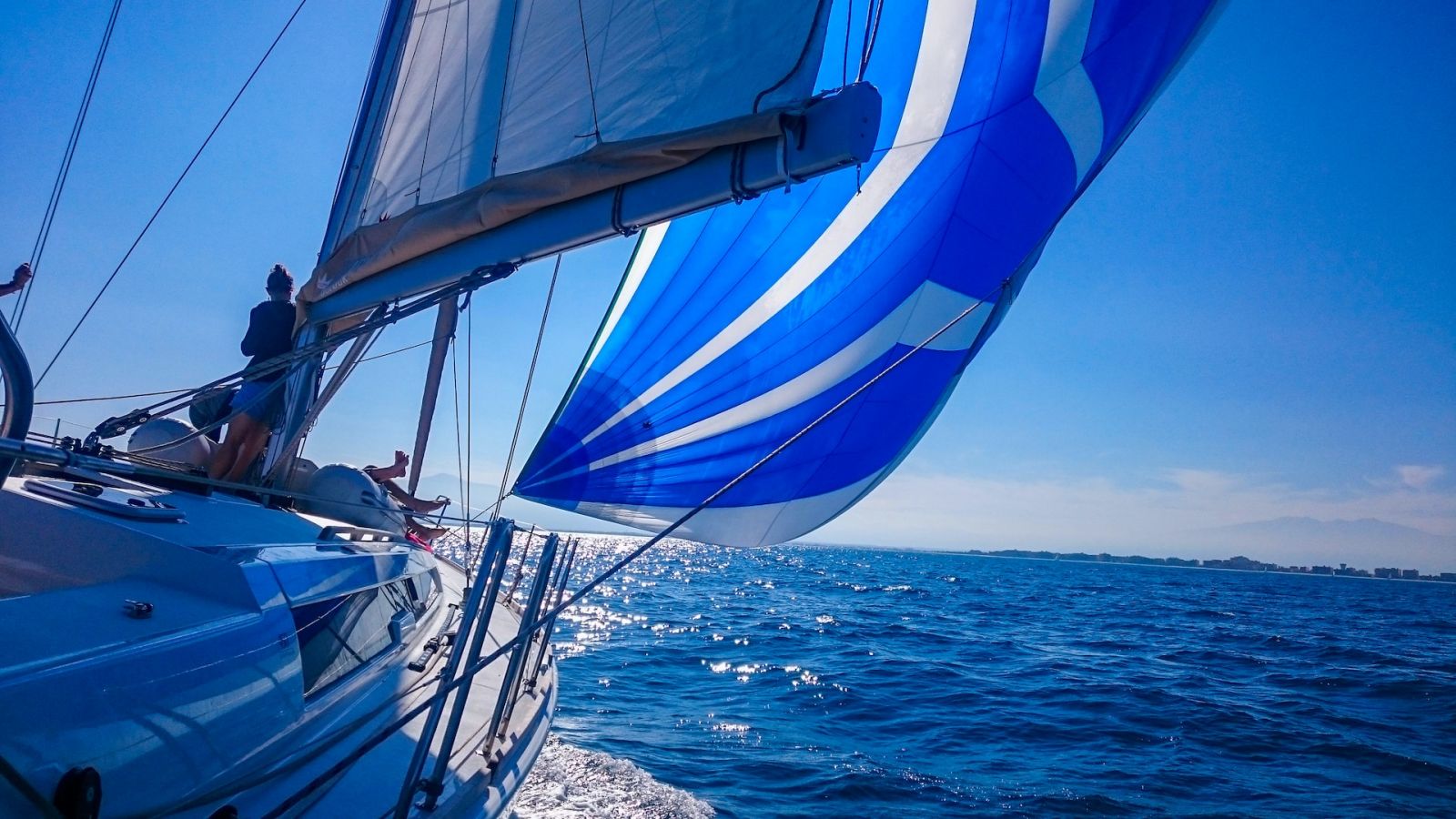
Sheet is the line used to control the position and trim of the sail
The jib sheet is the line used to control the jib's angle in relation to the wind. You adjust the sheet to get the best possible sail trim, which greatly affects your boat's performance. The jib sheet typically runs from the jib's clew (the lower rear corner of the sail) through a block on the boat's deck, and back to the cockpit, where you can easily control it.
When adjusting the jib sheet, you want to find the perfect balance between letting the sail out too far, causing it to luff (flutter), and pulling it in too tightly, which can cause heeling or poor sail shape. Make small adjustments and observe how your boat responds to find the sweet spot.
Genoa is a larger jib used to capture more wind
A genoa is a larger version of a standard jib. It overlaps the mainsail, extending further aft, and provides a greater sail area for improved upwind performance. Genoas are categorized by the percentage of overlap with the mainsail. For example, a 130% genoa means that the sail's area is 30% larger than the area of a jib that would end at the mast.
Genoas are useful in light wind conditions, as their larger surface area helps your boat move faster. However, they can become difficult to manage in strong winds. You might need to reef (reduce the size) or swap to a smaller jib to maintain control.
Headstay provides a support structure for the jib
The headstay is a crucial part of your boat's standing rigging system. It is the cable or rod that connects the top of the mast (the masthead) to the bow of the boat. The headstay helps maintain the mast's stability and provides a support structure for the jib.
The tension in your headstay plays a significant role in the jib's sail shape. Proper headstay tension will create a smooth, even curve, allowing your jib to perform optimally. If the headstay is too tight, the sail may be too flat, reducing its power, whereas a loose headstay can result in a sagging, inefficient sail shape.
A spinnaker is a sail designed specifically for sailing off the wind , on courses between a reach and downwind. They are made of lightweight fabric, often brightly colored, and help maximize your sailing speed and performance.
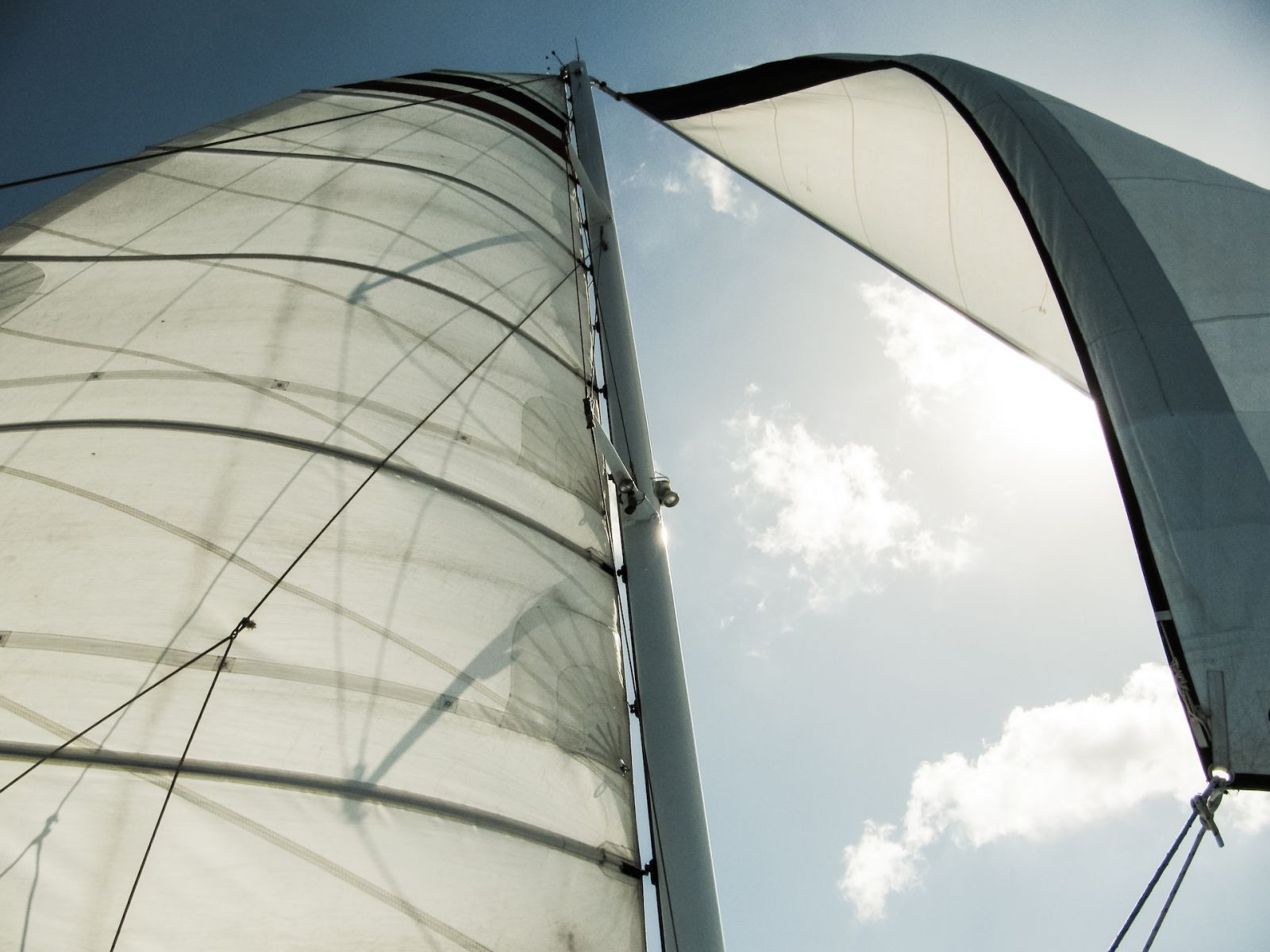
Asymmetrical spinnakers are designed for off-wind sailing
Asymmetrical spinnakers are usually found on modern cruising and racing boats. They're designed for a broader range of wind angles and have a more forgiving shape, making them easier for you to handle. Key components of an asymmetrical spinnaker include:
- Tack : This is the front, lower corner where the sail connects to the boat. A tack line is used to adjust the sail's position relative to the bow.
- Head : The top corner of the sail, where it connects to the halyard to be hoisted up the mast.
- Clew : The aft corner of the sail, connected to the sheet, allowing you to control the angle of the sail to catch the wind effectively.
You can find a step-by-step guide on how to rig and hoist an asymmetrical spinnaker here .
Symmetrical spinnakers are used for downwind sailing
Symmetrical spinnakers are more traditional and usually found on racing boats, where downwind performance is critical. These sails are shaped like a large parachute and are split into two identical halves. Key components of a symmetrical spinnaker include:
- Head : Similar to the asymmetrical spinnaker, the head is the top corner connected to the halyard.
- Clews : Unlike an asymmetrical spinnaker, a symmetrical spinnaker has two clews. Both are connected to sheets and guys, which help control the sail's shape and movement.
- Spinnaker Pole : This is a horizontal pole that extends from the mast and is used to project the windward clew outwards and hold the sail open.
Handling a symmetrical spinnaker can be more challenging, as it requires precise teamwork and coordination. If you're new to sailing with this type of sail, don't hesitate to seek guidance from experienced sailors to improve your technique.
In this section, we'll explore sail controls and settings, which are essential for beginners to understand for efficient sailing. We'll discuss trimming, and reefing, as sub-sections.
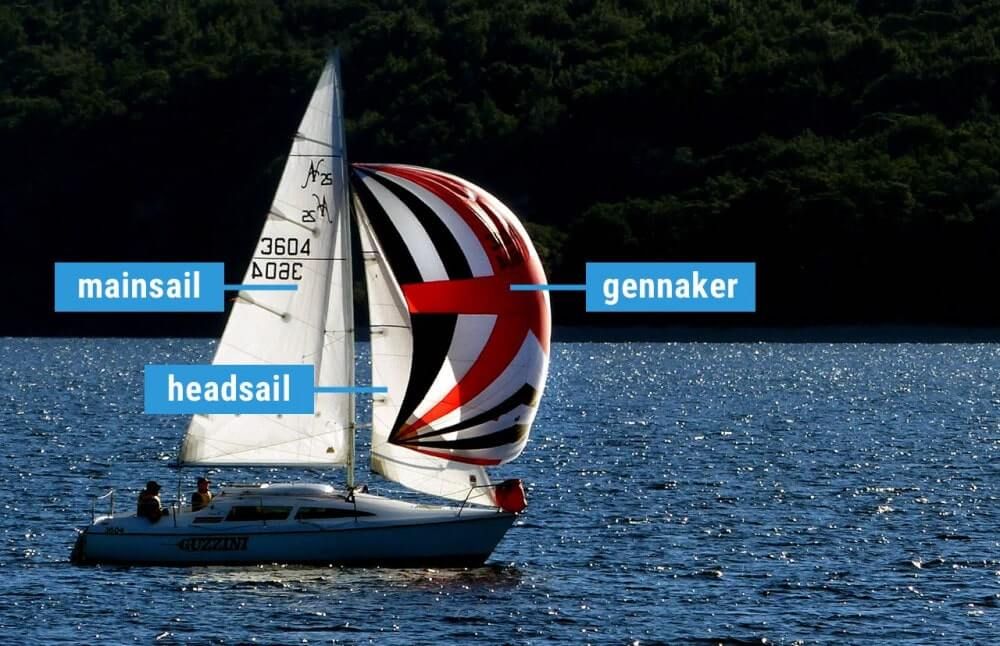
Trimming your sails for speed and stability
Trimming is the process of adjusting your sails to optimize them for the current wind conditions and desired direction. Proper sail trim is crucial for maximizing your boat's speed and stability. Here are some basic tips for sail trimming:
- Pay attention to the telltales, which are small ribbons or yarn attached to the sails. They help you understand the airflow over your sails and indicate whether they're properly trimmed.
- Use the sheets, which are lines attached to the clew of your sails, to adjust the angle of your sails relative to the wind.
- In light winds, ease the sails slightly to create a more rounded shape for better lift. In stronger winds, flatten the sails to reduce drag and prevent excessive heeling.
Reefing your sails for control and balance
Reefing is the process of reducing the sail area to help maintain control and balance in stronger wind conditions. It's an essential skill to learn for your safety and the longevity of your sails. Follow these steps to reef your sails:
- Head into the wind to reduce pressure on the sails.
- Lower the halyard (the line that raises the sail) until the sail reaches the desired reefing point.
- Attach the sail's reefing cringle (reinforced eyelet) to the reefing hook or tack line.
- Tighten the new, lower clew (bottom corner) of the sail to the boom with the reef line.
- Raise the halyard back up to tension the reduced sail.
Take proper care of your sailboat to ensure that it remains in top condition. In this section, we will discuss the key aspects of sail care and maintenance, focusing on cleaning and storage.
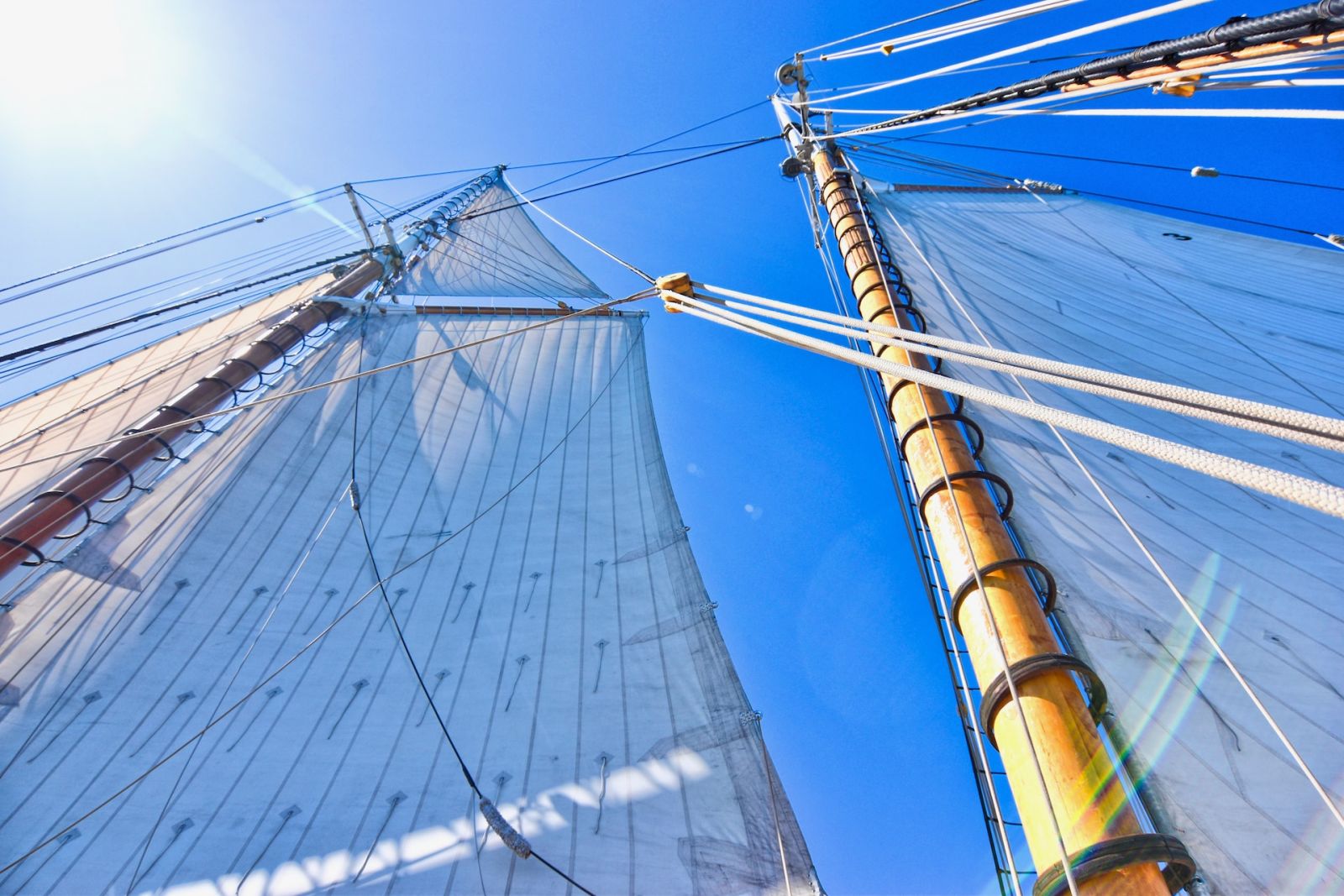
Steps to clean your sails
Keeping your sail clean is crucial for its longevity and performance. Follow these simple steps to maintain a spotless sail:
- Rinse with fresh water after each use, paying extra attention to areas affected by saltwater, debris, and bird droppings.
- Use a soft-bristled brush and a mild detergent to gently scrub away dirt and stains. Avoid harsh chemicals or abrasive materials, as they may damage the fabric.
- Rinse again thoroughly, ensuring all soap is washed away.
- Spread your sail out to air-dry, avoiding direct sunlight, which may harm the fabric's UV protection.
Ways to store your sails
Sail storage is equally important for preserving the lifespan of your sail. Here are some tips for proper sail storage:
- Fold or roll your sail : Avoid stuffing or crumpling your sail; instead, gently fold or roll it to minimize creases and wear on the fabric.
- Protect from UV rays : UV exposure can significantly reduce the life of your sail. Store it in a cool, shaded area or use a UV-resistant sail cover when not in use.
- Ventilation : Ensure your sail is stored in a well-ventilated area to prevent mildew and stale odors.
- Lay flat or hang : If space allows, store your sail laid out flat or hanging vertically to reduce the risk of creasing and fabric damage.
Flaking your sails when not in use
Flaking is the process of neatly folding your sails when they're not in use, either on the boom or deck. This helps protect your sails from damage and prolongs their lifespan. Here's how to flake your sails:
- Lower the sail slowly, using the halyard while keeping some tension on it.
- As the sail comes down, gather and fold the sail material in an accordion-like pattern on top of the boom or deck.
- Secure the flaked sail with sail ties or a sail cover to prevent it from coming undone.
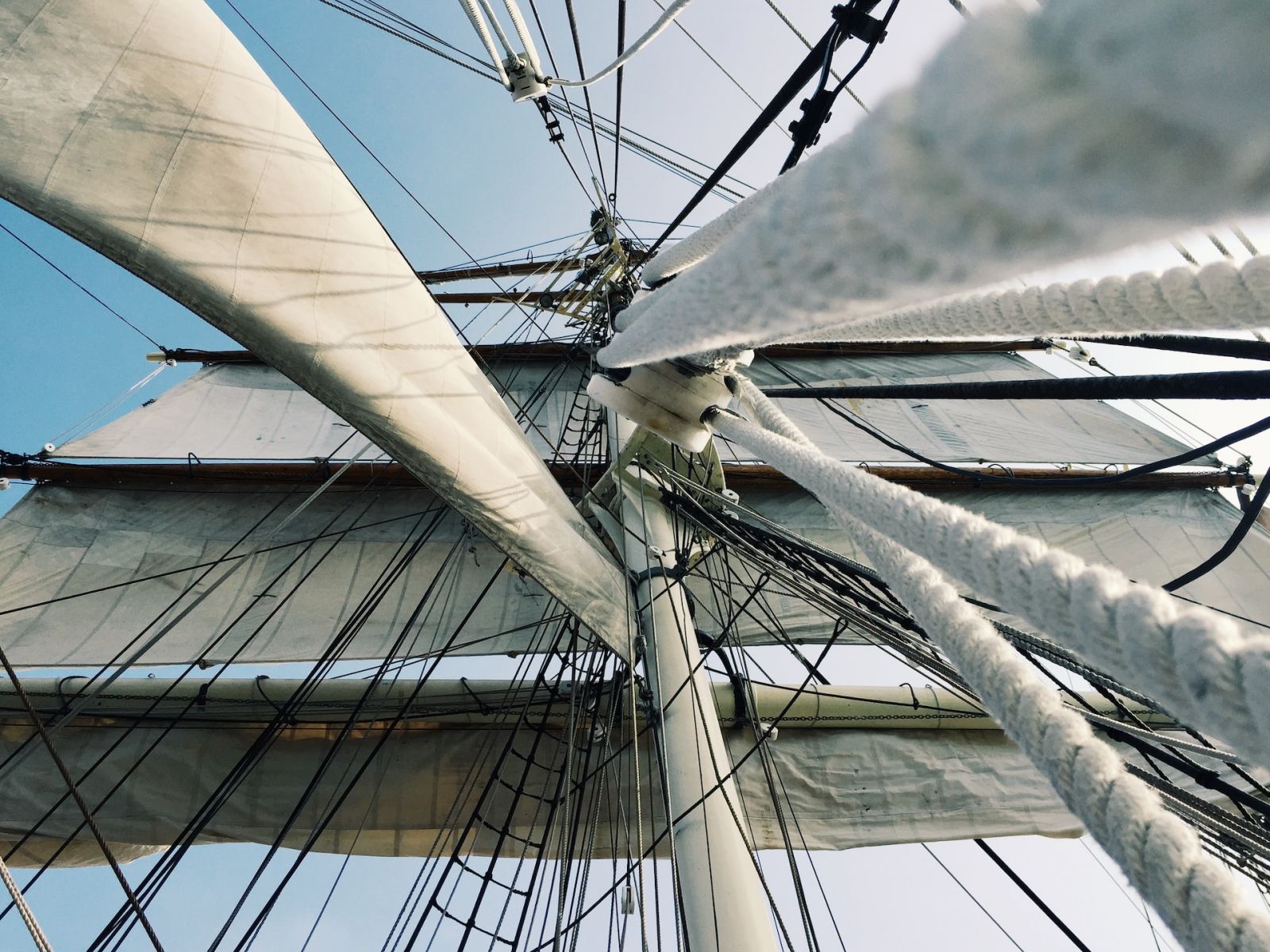
Traditional fabrics used to make sails
In the early days of sailing, natural materials like cotton and flax were used to make sails. These fabrics were durable, breathable, and held up well in various weather conditions. However, they would eventually wear out and lose their shape due to the constant exposure to UV rays and seawater.
While traditional fabrics like cotton and flax were once commonly used for sailmaking, they have largely been replaced by synthetic materials like polyester and nylon due to their superior strength, durability, and resistance to mildew and rot. However, some sailors and sailmakers still use cotton and other natural fibers for certain applications, such as traditional sailmaking or historical recreations.
Modern fabrics used to make sails
Modern sail materials, such as Dacron, Mylar, and laminates, are more resilient and longer-lasting than traditional fabrics. These materials are lightweight, strong, and resistant to UV rays and water damage.
Dacron : Dacron is a popular material for sails because of its durability, UV resistance, and ease of maintenance. It's a type of polyester fabric that is often used for making cruising sails. Dacron offers excellent shape retention and resistance to stretch, making it ideal for both beginners and experienced sailors.
Laminate materials : Laminate sails are made by bonding multiple layers of materials like Mylar, polyester, and Kevlar. These sails offer better shape and performance compared to their fabric counterparts, making them popular among racers. However, they tend to be more delicate and may not be suitable for long-term cruising.
Mylar films : Mylar films are used in laminate sails for their excellent strength-to-weight ratio and shape retention. These films are often sandwiched between other materials, such as polyester or Kevlar, to enhance the sail's resistance to stretch and load handling. However, Mylar sails can be susceptible to delamination and abrasion, requiring extra care and regular inspection.
Sail stitching for shape and durability
Sail stitching is an essential aspect of sail construction, helping to maintain the sail's shape and durability. Various stitching techniques can be used, such as zigzag, straight, and triple-step sewing. The choice of stitching type depends on the sail's purpose and expected loads. In addition, using UV-resistant thread ensures that the stitching lasts longer under harsh sun exposure.
Leave a comment
You may also like, how do sails actually work: full beginners guide.
The sails are your boat's primary driving force. Your boat is designed to sail , and with good wind it will be faster and more comfortable than using the engine. …
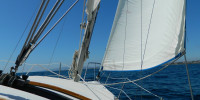
Sail Names: Explained for Beginners (With 15 Examples)
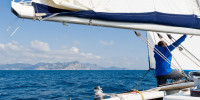
How To Trim Sails: The Ultimate Guide (with Cheat Sheet)
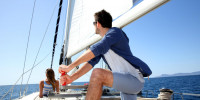
How To Reef Your Sails (Mainsail, Jib, Furling, Loose)
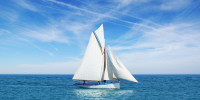
How Much Do New Sails Cost?
Own your first boat within a year on any budget.
A sailboat doesn't have to be expensive if you know what you're doing. If you want to learn how to make your sailing dream reality within a year, leave your email and I'll send you free updates . I don't like spam - I will only send helpful content.
Ready to Own Your First Boat?
Just tell us the best email address to send your tips to:
You are using an outdated browser. Please upgrade your browser to improve your experience.
- For brokers and agents
- Boat rental
- Destinations
- For beginners
The design of sailing yachts for beginners
If you are new to the world of yachting, the first thing you have to learn is the design of sailing yachts . It is a basic knowledge necessary for everyone who wants to be a yachtsman.
Ull of a sailing boat
After passing the boarding ladder, you will find yourself in a cockpit. Here stays the crew. The open cockpit is not railed off from the deck, and the closed one is isolated from the below deck rooms. The closed cockpit is usually self bailing, with the floor level higher than the water line. It is equipped with soil pipes that transport water overboard.
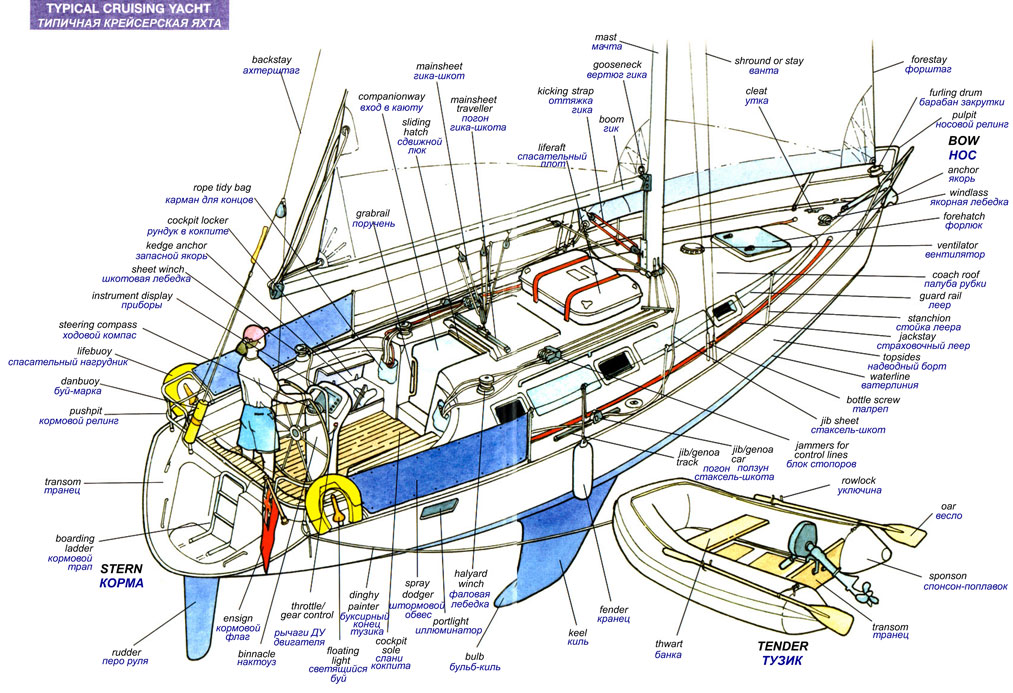
What can you see from the cockpit? You can conclude that the yacht consists of a hull and a rig. The hull is aimed for crew, guests and different equipment, and the rig includes the sails and all the devices necessary for their installation and control.
The front part of the hull is called “a bow”, and the back is called “a stern”. Overhanging parts of the hull are called “overhangs”, the side surfaces of the hull are known as boards. The lower surface of the hull is called “a bottom”. The back edge of the hull is called “a transom”.
The deck made from wood covers the hull. The bow part of the deck is called “a forecastle”, and the stern one – “an aftercastle”.
Names of the other parts of the design of sailing yachts are shown at the picture below.
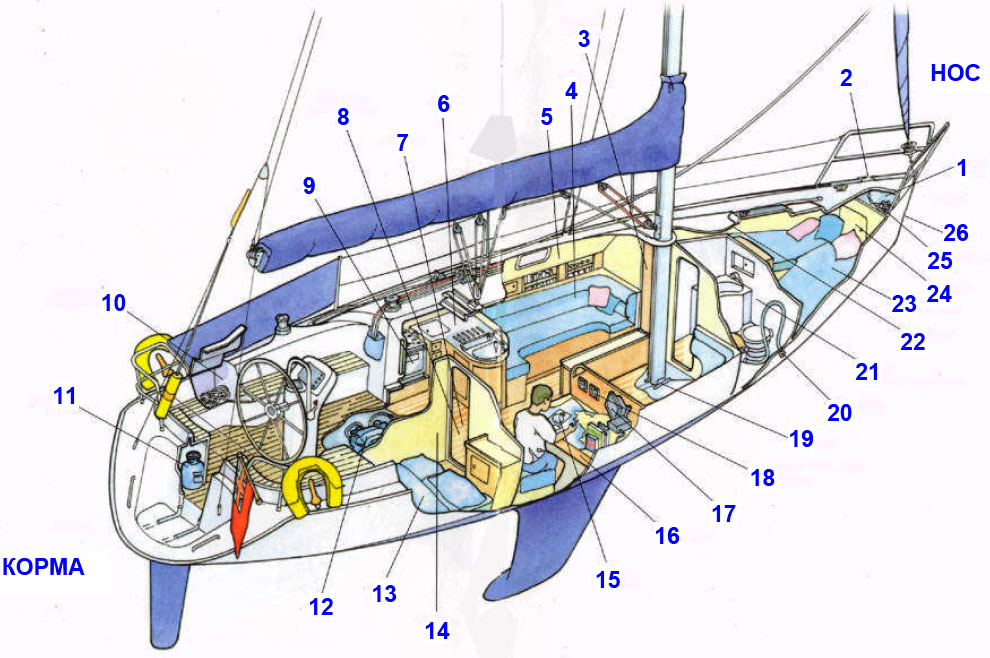
The rig of a yacht
As we have already stated, the rig consists of the sails and controlling devices.
The sails work as the main engine of a yacht. They are divided into three sets: basic, extra and storm sails. The main sails are used in normal conditions, and when the storm starts, the smaller ones replace them.
The rig also includes the mast, the boom, the spinnaker boom, the yards, the spreaders etc. The cordage consists of the tackles made of ropes. The dead ropes serve for bracing and maintaining the mast. The running ropes are necessary for setting and takedown of sails.
In the next article about the design of sailing yachts, we will give all the particulars on the rig and the ropes.
Your Personal Area
Create new account
Recover password
Registration
Already registered?

What Are the Parts of a Yacht Called? (Discover Here)

Are you curious about the parts of a yacht? From the hull to the cockpit and rigging, the construction of a yacht is a unique blend of form and function.
In this article, well explore what a yacht is, the different parts that make up a yacht, and how each plays an important role in the overall design.
So, if youre ready to explore the world of yachts, lets dive in and discover what each part of a yacht is called!.
Table of Contents
Short Answer
Yachts typically have three main parts that make up their structure: the hull, the deck, and the superstructure.
The hull is the main body of the watercraft, and is usually made of fiberglass or wood.
The deck is the top surface of the yacht, and is typically made of wood or composite materials.
Finally, the superstructure is the part of the yacht that contains all of the accommodations and amenities, such as cabins, bathrooms, and seating areas.
What is a Yacht?
A yacht is a luxurious vessel typically used for recreational activities such as fishing, cruising, and sailing.
While the design of each yacht may vary, all yachts have certain parts and components in common.
Knowing the different parts of a yacht and what they are called is essential for those looking to purchase or operate one.
In this blog post, well take a look at the parts of a yacht and discuss their purpose and function in more detail.
The hull is the main body of the yacht, providing the structure and shape of the vessel.
The deck is a flat surface that covers the hull and provides access to the cabin, cockpit, and other parts of the yacht.
The keel is a fin-shaped structure that helps the yacht stay balanced and steer in the water.
The cabin is the living area of the yacht and often contains bedrooms, a kitchen, and other amenities.
The cockpit is the part of the yacht used for steering and navigation, while the rigging consists of the wires and masts that support the sails.
All of these parts are essential for the safe and efficient operation of a yacht.
In addition to the parts mentioned above, there are also a number of accessories and equipment that can be installed on a yacht to enhance its function and performance.
These include anchors, winches, and sails.
It is important to note that the names of these accessories may vary depending on the type of yacht and its manufacturer.
By familiarizing yourself with the different parts of a yacht and what they are called, you can ensure that you have a safe and enjoyable experience when operating one.
Whether you are looking to purchase one or just curious to learn more, it is helpful to have a basic understanding of what makes a yacht tick.
Parts of a Yacht

When it comes to the parts of a yacht, the hull, deck, keel, cabin, cockpit, and rigging are the main components.
The hull is the main body of the yacht and provides the structure.
It is usually made of fiberglass, steel, or aluminum and is designed to be streamlined and watertight.
The deck is the flat, horizontal surface that covers the hull and provides access to the cabin, cockpit, and other parts of the yacht.
The cockpit is the part of the yacht used for steering and navigation and is typically located in the stern of the yacht.
Lastly, the rigging consists of the wires and masts that support the sails and is responsible for providing the power for sailing.
In addition to the main components, there are a few other parts of a yacht that are important to note.
These include the rudder, which is used to steer the yacht, and the anchor, which is used to keep the yacht in place.
Other parts include the bow and stern thrusters, which are used to help maneuver the yacht in tight spaces, and the winches, which are used to raise and lower sails.
All of these parts, along with the main components, help to make a yacht a reliable and safe vessel.
The hull is the main part of a yacht, providing the structure and support that allows the vessel to stay afloat.
The hull is usually made of fiberglass, wood, or aluminum, and is often reinforced with a steel frame to increase its strength and durability.
The hull is typically divided into two sections: the main deck, which contains the cabin, cockpit, and other amenities; and the bottom, which houses the engine, fuel tank, and other equipment.
The hull is also responsible for providing buoyancy, which allows the yacht to float in the water.
The shape of the hull depends on the type of yacht, with different designs providing different levels of performance and capabilities.
Racing yachts , for example, often have a narrower hull shape that allows them to cut through the water more efficiently, while cruising yachts typically have a wider hull shape that provides more stability.

The deck of a yacht is the flat surface that covers the hull and provides access to the cabin, cockpit, and other parts of the yacht.
It is usually made of fiberglass or wood and contains various components that are essential for the yachts operation.
The deck typically includes a helm station, navigation lights, and a mooring cleat.
It also provides a place to mount the boats instruments, such as a compass and GPS.
The deck is also home to the boats various rigging components, such as the masts, booms, and winches.
These components are essential for the boats sail operation, allowing it to be steered and navigated while under sail.
The deck also serves as the main platform for moving around the boat, providing the crew with a safe and secure place to walk and work.
Lastly, the deck provides a great vantage point for admiring the view, whether it be from the bow, stern, or sides of the boat.
The keel of a yacht is a fin-shaped structure located at the bottom of the boat.
It is designed to provide stability and improve the yachts steering performance.
The keel also helps the yacht cut through the water more efficiently and reduces drag, which can improve speed.
In addition, the keel is an important part of the yachts design and contributes to its overall shape and aesthetics.
The keel can be made from a variety of materials, such as fiberglass, steel, or wood, and can be either full or fin keels.
Full keels provide greater stability and are better for navigating rougher waters, while fin keels are lighter and more aerodynamic.

When it comes to luxury and leisure, few things can top the experience of sailing on a yacht.
Whether youre cruising the high seas or fishing in the bay, a yacht is the perfect way to get away from it all.
But before you start your nautical adventures, its important to understand the different parts of a yacht and what theyre called.
One of the most important parts of a yacht is the cabin.
The cabin is the living area of the yacht, where you can relax and enjoy the ride.
The cabin typically houses the bedrooms, kitchen, and other amenities.
Depending on the size of the yacht, the cabin can also include a lounge, wet bar, and dining area.
Its the perfect spot to unwind after a long day on the water or entertain family and friends.
When it comes to decorating the cabin, the possibilities are endless.
From traditional nautical dcor to modern, minimalist designs, you can create a space that reflects your own personal style.
The cabin is also a great place to install the latest technology, such as high-definition TVs, Wi-Fi, and sound systems.
With the right features, you can enjoy a truly luxurious experience.
The cabin is the heart of a yacht, and the perfect spot for you and your guests to relax and enjoy the journey.
With the right design and amenities, the cabin can transform your yacht into a home away from home.
Cockpit and Rigging
Cockpit and rigging are two essential parts of a yacht.
The cockpit is the part of the yacht used for steering and navigation.
It is typically located aft of the cabin and may be enclosed or open, depending on the design.
It’s the central place where the captain and crew can see all the instruments needed to control the yacht, making it the perfect spot to take in the view and enjoy the journey.
Rigging consists of the wires and masts that support the sails.
These are used to increase the yachts speed and enable it to move more efficiently through the water.
The masts are held in place by a series of stays and shrouds, while the sails are attached to the masts and held down by halyards and sheets.
Rigging is a complex system that requires regular maintenance and attention, which is why it is important to have a knowledgeable and experienced crew on board.
Together, the cockpit and rigging allow a yacht to be operated safely and efficiently.
They are essential for maneuvering the yacht and controlling its speed, making them one of the most important parts of a yacht.
It is important to understand the different parts of a yacht and how they work together to ensure a safe and enjoyable experience.
Final Thoughts
Now that you know the parts of a yacht and their purpose, you can confidently explore the waters in your own vessel.
Whether youre a seasoned sailor or just starting out, understanding the structure of a yacht is essential for a safe and enjoyable experience.
So, go ahead and plan that next adventure youve got the knowledge to make it a success!.
James Frami
At the age of 15, he and four other friends from his neighborhood constructed their first boat. He has been sailing for almost 30 years and has a wealth of knowledge that he wants to share with others.
Recent Posts
Does Your Boat License Expire? Here's What You Need to Know
Are you a boat owner looking to stay up-to-date on your license requirements? If so, youve come to the right place! In this article, well cover everything you need to know about boat license...
How to Put Skins on Your Boat in Sea of Thieves? (Complete Guide)
There is a unique sense of pride and accomplishment when you show off a boat you customized to your exact specifications. With Sea of Thieves, you can customize your boat to make it look like your...
Parts of a Boat: Essential Components Explained
Boating is an exciting activity that provides a unique blend of adventure, relaxation, and connection with nature. Learning the basic parts of a boat and understanding the terminology is vital to mastering navigation and ensuring safety on the water. Boats come in diverse shapes and sizes, from modest rowboats to luxurious yachts, each serving specific purposes and requiring different levels of knowledge.
The anatomy of a boat consists of essential components such as the hull, bow, stern, port, and starboard sides. Knowledge of these parts allows for effective communication and improved maneuverability on the water. Whether you're a novice or an experienced skipper, it's important to understand parts and terminology related to movement, boat equipment, and open deck areas, as well as specific aspects of sailboats and fishing vessels.

Key Takeaways
- Familiarity with basic boat parts and terminology enhances navigation and safety on the water.
- Boats come in various forms and sizes, each with specific purposes and features.
- Understanding the unique aspects of sailboats, fishing boats, and other vessel types ensures an enjoyable and safe boating experience.
Basic Parts of A Boat
The bow refers to the front part of the boat. It is designed to cut through water with minimal resistance, allowing the boat to move smoothly and efficiently. The shape of the bow can vary depending on the boat's intended use, but it is generally narrow and pointed.
The stern is the rear part of the boat. It can have different shapes and features, such as a flat transom or a rounded shape. The stern is where the boat's propulsion system, like an outboard motor or inboard engine, is typically located.
The hull is the primary structure of the boat , providing both support and buoyancy. It is comprised of the boat's outer shell and is designed to withstand a variety of conditions, including waves and impact from abrasion or collisions. Hulls are generally made from materials like fiberglass, aluminum, steel, or wood.
The deck is the flat surface on the boat's top, providing open spaces for passengers and crew. It is often used for recreational activities, such as sunbathing, fishing, or socializing. Decks can be made of various materials, including wood, fiberglass, or metal.
The cabin is the enclosed space within the boat that provides shelter and living accommodations for the passengers and crew. Cabins are usually found on larger boats and can include sleeping quarters, a galley (kitchen), and bathroom facilities.
The keel is the boat's backbone, running longitudinally along the bottom of the hull. It provides structural support and stability. In sailing boats, the keel also serves as a counterweight and assists with lateral resistance when sailing upwind.
The bridge is the command center of larger boats or ships, housing the navigation and control systems. It is typically located near the top of the vessel, providing a clear and unobstructed view for the captain and crew. The bridge contains essential equipment such as radar, GPS, communication devices, and steering controls.
In summary, the basic parts of a boat include the bow, stern, hull, deck, cabin, keel, and bridge. These components work together to ensure a smooth and safe experience for passengers and crew alike.

Position Indicators
The port side of a boat refers to the left side when facing the front or forward part of the boat. This is an important position indicator as it helps sailors and passengers ensure they are navigating the waters correctly. The port side is usually marked with red navigation lights to indicate its position in low visibility conditions. The term aft refers to the rear part of the boat, which is closest to the port side.
Starboard Side
On the other hand, the starboard side is the right side of the boat when facing forward. It is a crucial position indicator that allows sailors to distinguish their right side from the left side. Starboard side is typically marked with green navigation lights to differentiate it from the port side in low light or foggy situations. During navigation, a boat should ideally pass other boats on its starboard side, which means the other boat should be on its ahead and port side. The term astern refers to the rear part of the boat, which is closest to the starboard side.
Both port and starboard sides are essential for properly navigating and maneuvering the boat while sailing. Understanding the differences between these position indicators ensures safe and efficient movement at sea. Knowing the forward, aft, astern, and ahead concepts in relation to the port and starboard sides further establishes a solid foundation for any boating enthusiast.

Terms Related to Movement
The right side of a boat is referred to as the starboard side. When a boat is moving forward, this is the side on the right. The term starboard originates from the old nautical term "steorbord" which refers to the side where the steering oar was placed. Most boats today have a green navigational light on the starboard side.
The left side of a boat is called the port side. Just as with the starboard side, the port side's name has its origins in nautical terminology. The port side was originally called "larboard," but due to its similarity in pronunciation with starboard, "port" was adopted as the term. Today, boats have a red navigational light on the port side.
Back of a Boat
The back of a boat is known as the stern . This is the area where the boat's propulsion system, such as the motor or propeller, is usually located. When a boat is adrift , the stern can be a critical spot for maintaining control and making necessary adjustments to the vessel's movement.

Front of a Boat
The front part of a boat is called the bow . This is the area that cuts through the water as the boat moves forward. The waterline of a boat refers to the point where the hull meets the water's surface; this varies depending on the vessel's load and can impact its movement.
When discussing movement in nautical terms, speed is often measured in knots , which is equivalent to one nautical mile per hour. Knowing the speed of a boat is important for navigation , fuel consumption, and safety. Sailors must also be aware of the possibility of a boat running aground , which means the vessel's hull is in contact with the sea floor, often resulting in damage or being stuck in place. A grounded boat can impact vessel trajectory and movement.

Boat Equipment
A cleat is an essential piece of boat equipment used for securing lines. It is a T-shaped or Y-shaped hardware component, commonly made of metal or plastic, that allows for easy tying and untying of ropes or lines. Cleats are crucial for docking, anchoring, and tying boats to other floating devices. They can be attached to the deck, side railings, or the mast base to provide a secure point for lines.
Lines are important for various tasks on a boat, such as mooring, anchoring, or towing. They are typically made of synthetic materials like nylon or polyester, which are durable and resistant to UV radiation, saltwater, and chemicals. When selecting a line for specific tasks, it's essential to consider factors such as strength, stretch, and resistance to abrasion. Among other parts of a boat, lines are often used in conjunction with cleats and fenders to ensure secure docking.
Fenders are cushioning devices used to protect a boat's hull from damage caused by contact with docks, piers, or other boats. They are typically made of soft, flexible materials like foam or inflatable plastic and are designed to absorb impact and distribute pressure. Placed between the boat and the docking area, fenders can prevent potential damage such as scratches, dents, or chipping paint.
A gate on a boat refers to an opening in the railings or lifelines, allowing the crew and passengers more accessible entry or exit. Gates are often found on sailboats and yachts. To ensure safety, they are usually equipped with a latching mechanism or locking device, preventing accidental opening while the boat is underway.
In addition to the above-listed components, some other crucial boat parts include:
- Outboard Motor : A detachable engine unit mounted on the stern (rear) of the boat, providing propulsion. Outboard motors are typically self-contained, housing the engine, gearbox, and propeller in one unit.
- Anchor : A weighted, hook-like device that secures boats to the seabed or riverbed, preventing them from drifting due to wind or currents. It is connected to the boat by an anchor line or chain.
- Helm : The steering control area, typically consisting of a wheel or tiller, which allows the operator to maneuver the boat.
- Propeller : A rotating fan-like device connected to the boat's engine, responsible for generating thrust and propelling the boat forward or backward.
- Mast : A tall, vertical pole on a sailboat that supports the sails and rigging.
- Rudder : A flat, vertical panel, usually mounted beneath the boat's stern, which helps steer the boat when turned by the helm.
Boat equipment plays a crucial role in operating and maintaining a vessel safely and efficiently. Ensuring that these components are in good condition and used properly is essential for a successful boating experience.

Open Deck Areas
Open deck areas on a boat serve various purposes and often host different types of equipment, providing both functionality and comfort to the passengers. This section will discuss three subsections, focusing on the galley, rod holder, and throttle.
The galley is an essential part of any boat with an open deck area, similar to a kitchen found on land. It often includes facilities for cooking, refrigeration, storage, and meal preparation. A well-designed galley allows passengers to prepare meals while enjoying the outdoor surroundings. Located near the bulkhead , it provides easy access to other deck areas like the bridge and cockpit .
A rod holder is a crucial piece of equipment for recreational boating, especially for those who enjoy fishing. It securely holds fishing rods in place and allows anglers to fish hands-free, increasing safety and convenience. Rod holders are typically located near the boat's casting deck and pulpit , offering easy access while fishing. It is essential to ensure that rod holders stay clear of the boat's swim platform to minimize accidents or obstructions.
The throttle controls the boat's speed and is a vital component that falls under open deck areas. Located in the cockpit or near the boat's bridge , the throttle allows the operator to control the boat's engine power and steer it safely. A smooth and responsive throttle is essential for safe and enjoyable boating experiences.
In conclusion, open deck areas of a boat include essential facilities and equipment that provide comfort, functionality, and entertainment for passengers. Understanding the role and location of the galley, rod holder, and throttle can significantly enhance the overall boating experience.
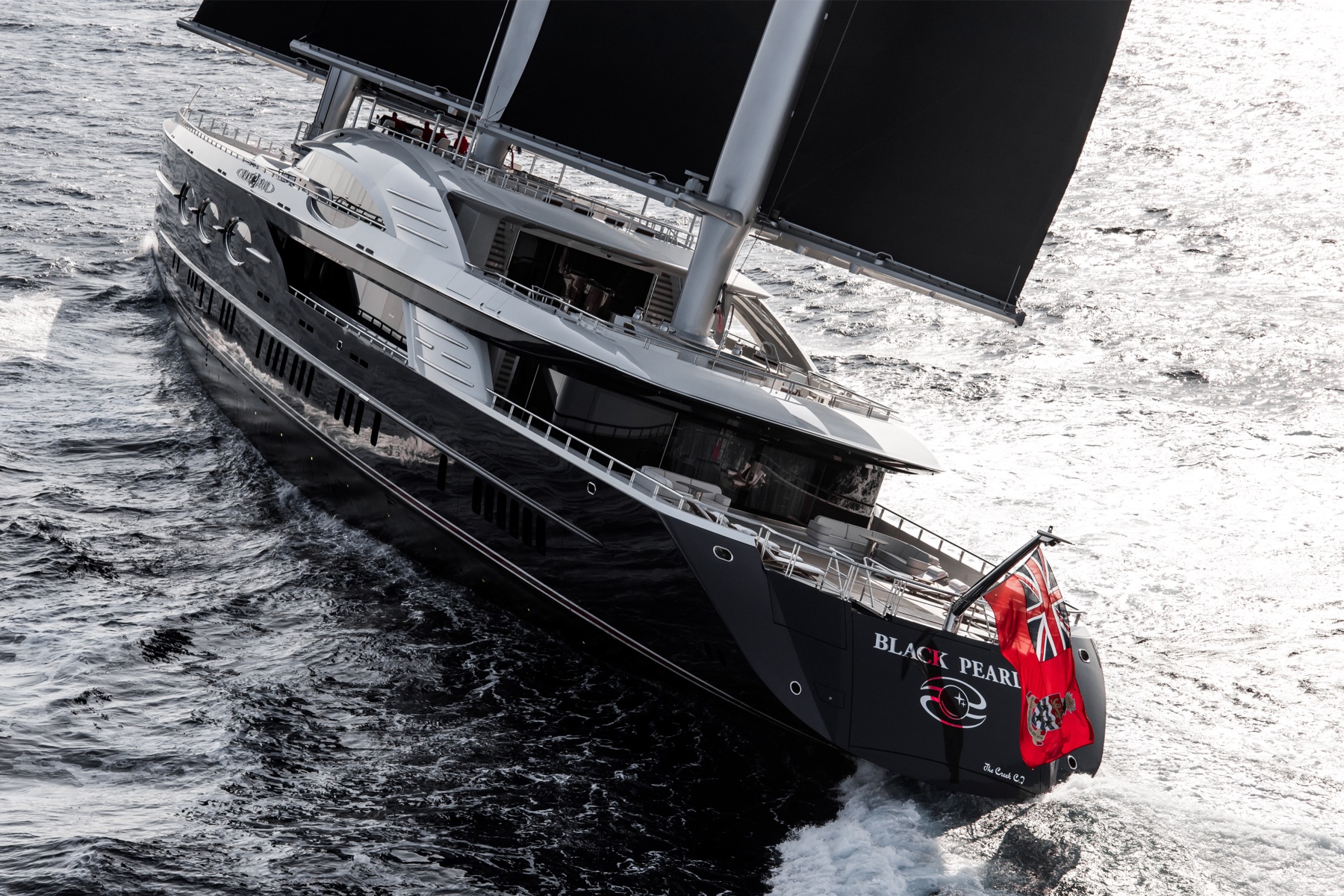
Sailboat Specifics
Sailboats are designed with various distinctive parts that contribute to their unique sailing capabilities. This section will discuss three specific components of a sailboat: the Ballast, Forestay, and Centerboard.
The ballast is an essential element in a sailboat's stability. It is typically found at the bottom of the boat and is responsible for providing a low center of gravity, counteracting the heeling force induced by the sails' wind pressure. The ballast is often made of dense materials like lead or iron and accounts for a significant portion of the boat's overall weight. A well-designed ballast ensures that the sailboat maintains its balance and returns to an upright position after being heeled by the wind.
The forestay is a vital part of the sailboat's rigging, as it secures the mast's forward end. This cable or rod connects the bow (front) of the boat to the top of the mast, providing support and tension to the mast and helping maintain its shape. The forestay is also crucial for attaching the jib, a smaller triangular sail set forward of the mainsail. The jib can improve the boat's overall performance , allowing it to point more effectively into the wind and increasing maneuverability.
Centerboard
A centerboard is a movable fin located at the sailboat's bottom middle portion, allowing the boat to change its draft (submerged depth) and optimize its performance. The primary functions of a centerboard are to combat leeway, generating lift under the boat and preventing it from being pushed sideways by the wind, and to help control the sailboat's balance.
The centerboard can be raised or lowered as needed, providing the desired level of stability and maneuverability. It can be retracted entirely to allow the sailboat to move through shallow waters or for transportation purposes. Thus, the centerboard is an essential factor in a sailboat's flexibility and adaptability.
In summary, the ballast, forestay, and centerboard are crucial components of a sailboat that contribute to its stability, rigging, and overall sailing performance. These parts work together, enabling sailboats to harness wind power effectively and provide an enjoyable sailing experience.

Boating Terminology
When it comes to boating, understanding the terminology can be crucial for a safe and enjoyable experience. This section aims to provide you with a clear and concise explanation of some essential boating terms.
The rail is an essential part of a boat, serving as a safety barrier and also adding stability. It is located along the outer edge of a boat's deck, ensuring that passengers do not accidentally fall overboard. Typically, the rail is made of durable materials such as stainless steel or aluminum, to withstand harsh marine conditions.
A hatch refers to a door or opening that provides access to different sections of a vessel. It can be found on both the exterior and interior of a boat. Hatches serve various purposes, such as ventilation, emergency escape routes, and access to storage compartments. They are typically designed with watertight seals to prevent water from seeping in and damaging the vessel's interiors or essential equipment.
In boating terminology, a bulkhead refers to a structural partition that separates different compartments within a ship. Bulkheads are vital for the vessel's stability and play a crucial role in maintaining its integrity and balance while at sea. Additionally, they also provide a degree of fire protection, as they can act as a barrier between sections of the boat in case of a fire breakout.
A livewell is a specialized compartment on a fishing boat that serves to keep bait and caught fish alive while onboard. This container is filled with water, and usually has an aeration system to maintain oxygen levels and ensure the wellbeing of the fish. Livewells are essential for anglers who participate in catch-and-release fishing or need to keep their catches fresh until they return to shore.
By understanding these essential boating terms, one can navigate vessels more effectively and safely, and fully appreciate the complexities of ships and boats.

Other Key Aspects
The bilge is a crucial part of a boat located at the lowest point of the hull, responsible for collecting any water or oil that may accumulate inside the vessel. It is important to have a functional bilge pump in place to ensure the boat remains safe and seaworthy. The beam of the boat plays a role in determining how much water the bilge can handle. A wider beam allows for more water storage capacity and makes it more stable.
The draft of a boat refers to the depth of water needed for it to float freely without touching the bottom. This measurement plays a significant role in deciding where a boat can travel, as some areas may not be navigable due to shallow waters. The draft directly relates to the boat's design, including the freeboard and hull shape. A larger draft may lead to a more stable vessel in rough waters, while a smaller draft benefits boats navigating shallow areas.
The head is the maritime term for the boat's toilet. It is an essential component on any vessel equipped for overnight trips or extended cruises. Proper maintenance of the head and its plumbing system is crucial for sanitation and ensuring a pleasant experience for passengers onboard. Some larger boats may feature more sophisticated systems, including separate shower areas or pump-out systems.
The doors on a boat differ from those found on land; they need to be watertight, designed to withstand harsh marine conditions, and must not compromise the overall integrity of the vessel. The material used for the door construction varies, often including high-quality stainless steel or aluminum. In some cases, doors may be equipped with air-tight seals and locking mechanisms to prevent water ingress during rough seas.
In conclusion, understanding key aspects such as the bilge, draft, head, and doors is essential for boat owners and enthusiasts. Considering other elements like beam, freeboard, transom, and gunwale will provide further insight into the boat's stability, navigation capabilities, and overall design.

Fishing Boat Essentials
When it comes to enjoying a day on the water, having the right essentials on your fishing boat can make all the difference. This section covers some of the must-have components for a successful fishing trip: the Tiller, Bimini, and Console.
The tiller is an essential part of any fishing boat, as it is used to steer the vessel. It is typically attached to the boat's outboard motor or rudder and allows the operator to control the direction of the boat. A tiller provides excellent maneuverability and is ideal for navigating tight spaces and shallow waters, which are often found in prime fishing spots. In addition, many fishing boats come equipped with rod holders , just behind the tiller, making it easy for anglers to keep their fishing gear within reach.
A bimini is a type of canopy that provides shade and protection from the elements while on the water. It is especially useful for anglers who spend long hours exposed to the sun and elements. A bimini can be easily installed on most fishing boats and can usually be folded down when not in use. It also adds an extra layer of comfort and protection for those on board.
For added convenience, some biminis have built-in rod holders, allowing anglers to secure their fishing rods while taking a break from casting. A good bimini can make the difference between an enjoyable day on the water and an endurance test against the elements.
The console is the control center of the fishing boat, housing essential instruments and controls needed for navigation, communication, and boat operation. Located near the steering wheel, the console should contain the necessary equipment such as a GPS system, VHF radio, and depth finder to aid anglers in their fishing expeditions.
A well-designed console also provides space for mounting additional tools and storage, such as a livewell . Livewells are valuable components for keeping bait and caught fish alive and in optimal condition until the angler is ready to return to the shore. There should also be dedicated spots for storing extra fishing equipment, such as tackle boxes and spare rods.
In summary, having a well-equipped fishing boat with essential components like the tiller, bimini, and console will make for a more enjoyable and efficient angling experience. These crucial parts ensure that the angler is ready for whatever challenges the water may bring, allowing them to focus on the main task at hand: catching fish.
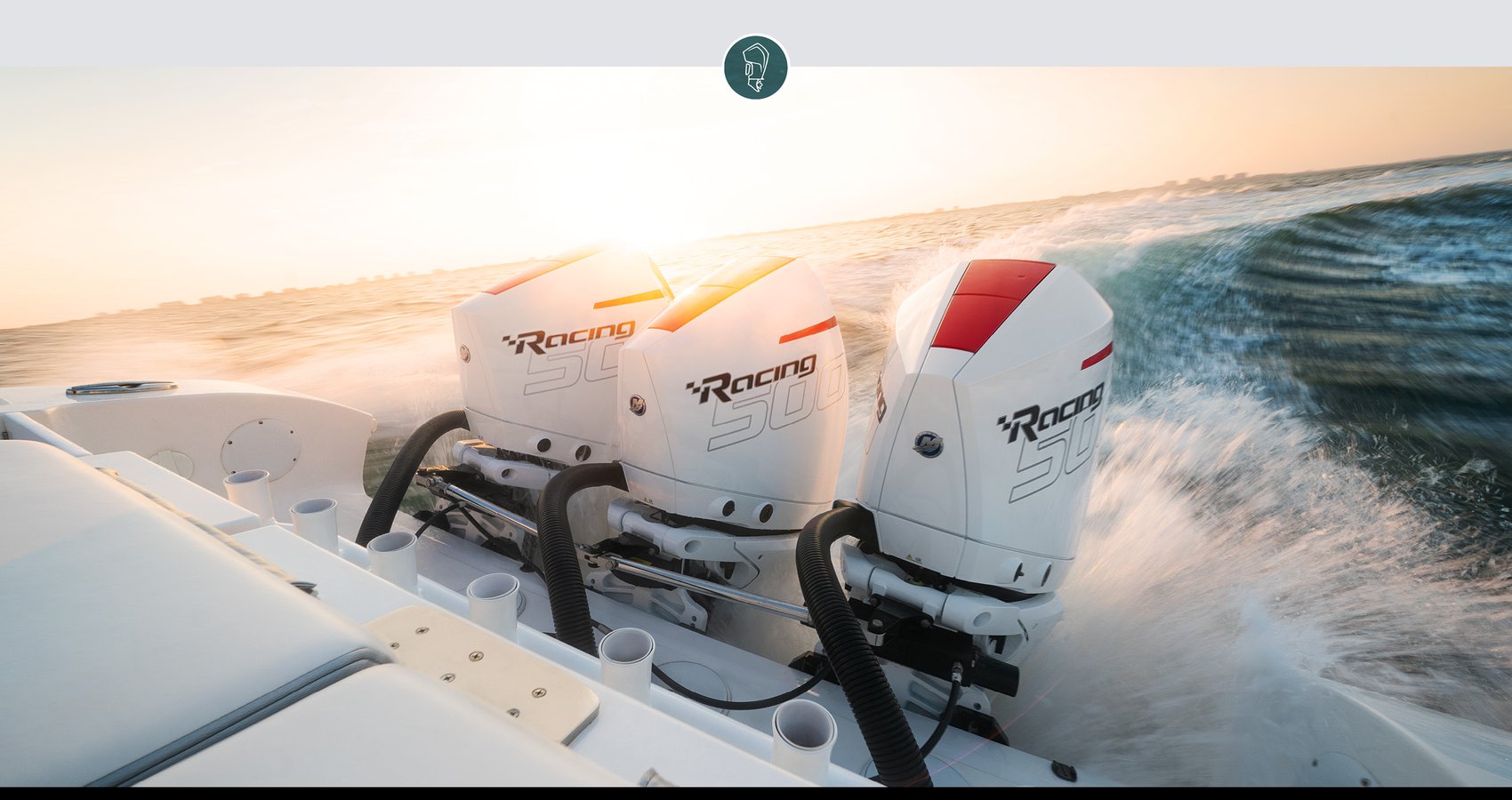
Frequently Asked Questions
What is the right side of a boat called.
The right side of a boat is called the starboard side. This term is used to refer to the right side when facing forward on a boat.
What is the back of the boat called?
The back of a boat is known as the stern . The stern is the rear section of a vessel that helps provide stability and aid in the steering process.
What are the 4 basic parts of a boat?
The four basic parts of a boat are the hull , deck , engine , and sails (in sailboats). The hull is the main body of the boat, providing buoyancy and protection from water. The deck is the flat surface that covers the hull and supports the occupants and any equipment. The engine propels the boat, and the sails are used for harnessing wind energy in sailboats.
What is the cockpit of a boat called?
The cockpit of a boat is called the helm . The helm is the part of the boat where the captain or helmsman steers and controls the vessel. This area typically includes a steering wheel, throttle, and navigation equipment.
What is the outer part of the boat?
The outer part of the boat refers to the hull and deck . The hull is the structural component that keeps the boat afloat, while the deck is the part that occupants walk on. The hull and deck together form the external shell of the boat, protecting it from water and providing stability.
What are boat parts called?
Boat parts are usually referred to by specific names such as hull, deck, mast, rudder, and keel, among others. Each part serves a unique function in the overall operation and stability of the boat, making it essential for boat owners to be familiar with these terms.
Related Articles

Ascend 10T Kayak: A Comprehensive Overview for Enthusiasts
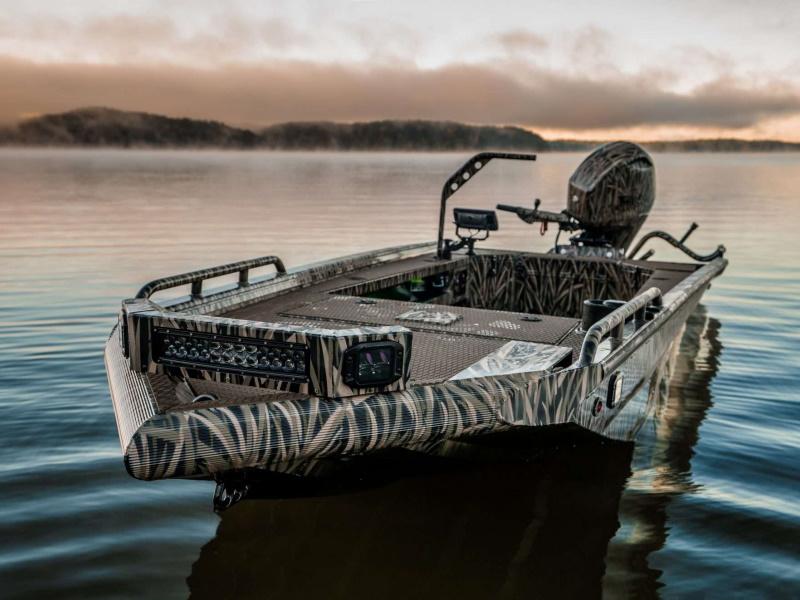
Prodigy Boats: Unveiling the Innovation in Marine Craft Design

Best Boat Shoes: A Comprehensive Guide for 2023

G3 Boats: Expert Insights and Comprehensive Guide for 2024
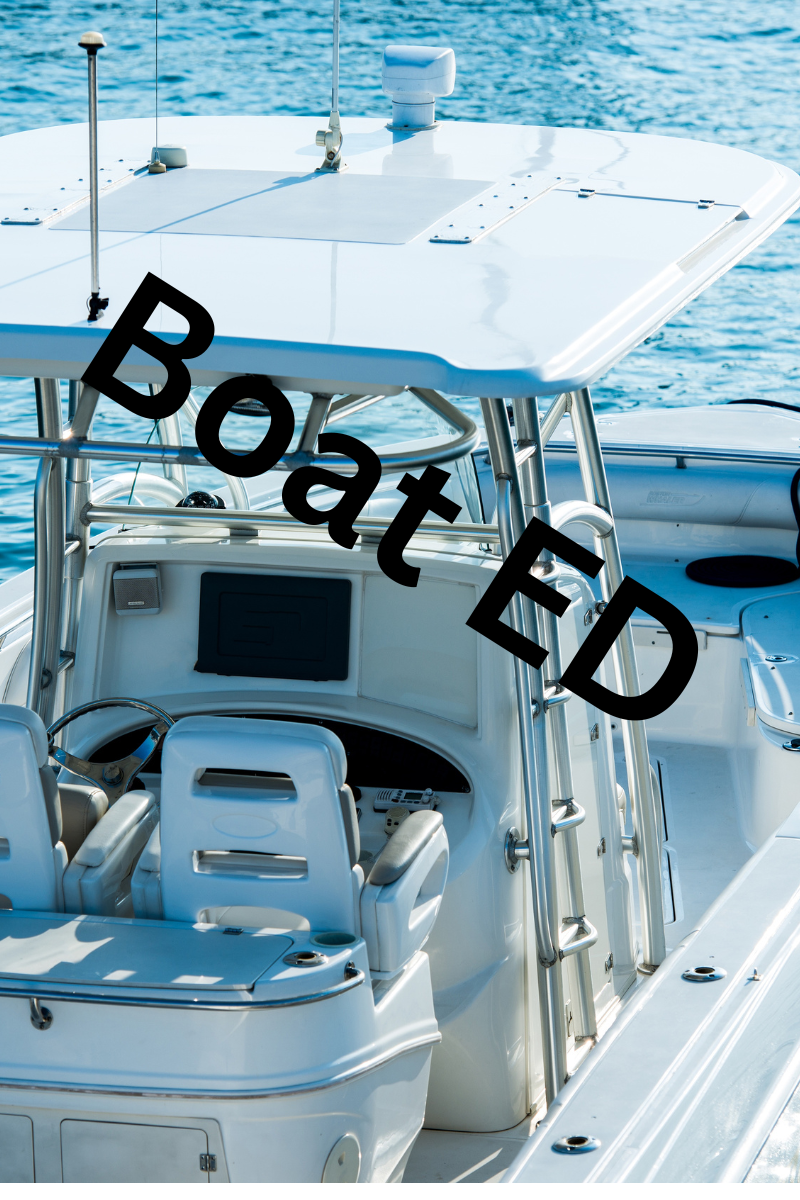
Boat ED- Ultimate Guide: Mastering Watercraft Safety and Skills

It's Not The Size of Your Antenna-It's where you put it

Bow of a Boat: Essential Guide to Understanding Its Importance

Nautical Flags: Essential Guide for Maritime Communication
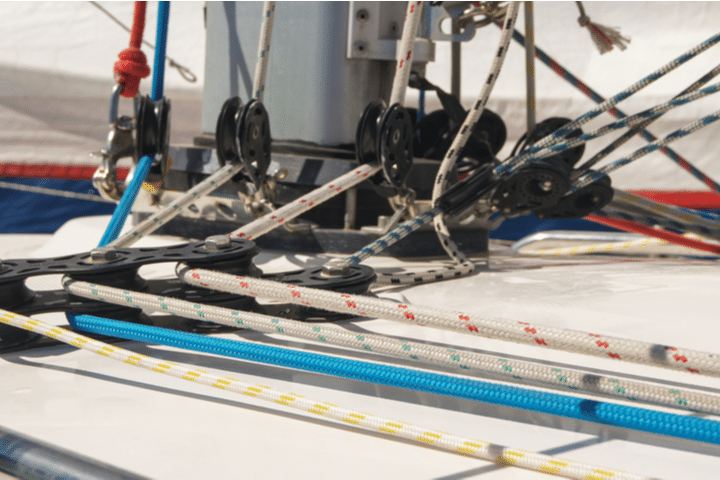
A Guide to the Different Parts of a Sailboat

Table of Contents
When you use Boatsetter, you have the opportunity to choose from a myriad of different sailboat rentals from all over the United States and beyond . A sailboat is a perfect way to relax on the water, either on a solo adventure or on an excursion with friends and family.
When you rent a sailboat with Boatsetter, you will have the option to book a captained sailboat to enjoy your day out on the water or book bareboat to hone your sailing skills. Either way, you may be interested in the intricacies of a sailboat and its different parts. If this sounds like you, you have come to the right place. In this article, we go in-depth about the different parts of a sailboat so that you can be more knowledgeable about whatever boat you may choose and come away from reading this feeling more confident about the whole sailing experience.
A basic sailboat is composed of at least 12 parts: the hull , the keel , the rudder , the mast, the mainsail, the boom, the kicking strap (boom vang), the topping lift, the jib, the spinnaker, the genoa, the backstay, and the forestay. Read all the way through for the definition of each sailboat part and to know how they work.
Explore sailboats for rent near you or wherever you want to go
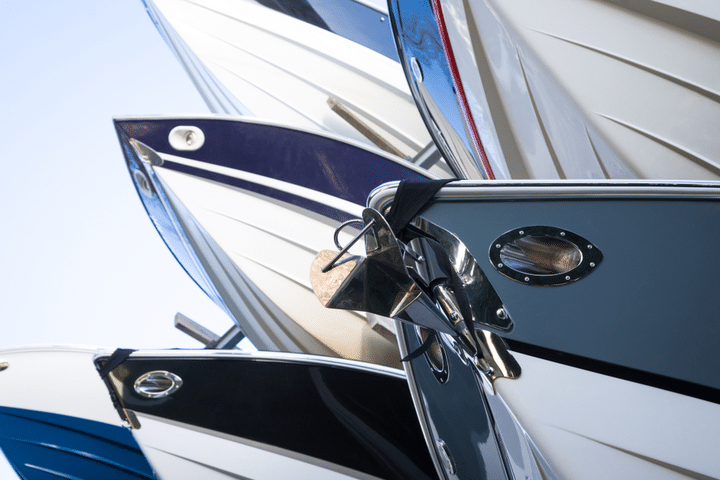
In short, the hull is the watertight body of the ship or boat. There are different types of hulls that a sailboat may have, and these different hulls will often affect the speed and stability of the boat.
Displacement Hulls
Most sailboats have displacement hulls , like round bottom hulls, which move through the water by pushing water aside and are designed to cut through the water with very little propulsion. The reason these are called displacement hulls is that if you lower the boat into the water, some of the water moves out of the way to adjust for the boat, and if you could weigh the displayed water, you would find that it equals the weight of the boat, and that weight is the boat’s displacement. One thing to know about displacement hulls is that boats with these hulls are usually limited to slower speeds.
Planing Hull
Another type of hull is a planing hull. These hulls are designed to rise and glide on top of the water when enough power is supplied. When there is not enough power behind the boat, these boats often act as displacement hulls, such as when a boat is at rest. However, they climb to the surface of the water as they begin to move faster. Unlike the round bottom displacement hulls, these planing hulls will often have flat or v-shaped bottoms. These are very common with motor-driven water vessels, such as pontoon boats, but they can also be found on smaller sailboats which allow them to glide quickly over the water.
Finally, sailboats can differ depending on the number of hulls that they have. There are three options: monohulls (one hull), catamarans (two hulls), and trimarans (three hulls).
Monohulls , which have only a single hull, will usually be the typical round bottom displacement hull or occasionally the flat bottomed or v-shaped planning hull. Catamarans have two hulls with a deck or a trampoline in between, with the extra hulls providing increased stability. Finally, trimarans have three hulls — a main hull in the middle and two side hulls used for stability. These trimarans have gained popularity because of their excellent stability and ability to go at high speeds.
When evaluating a sailboat , it is important to pay attention to the type of hull that the boat has because the type of hull a sailboat has can drastically change the sailing experience, especially when it comes to stability and speed.
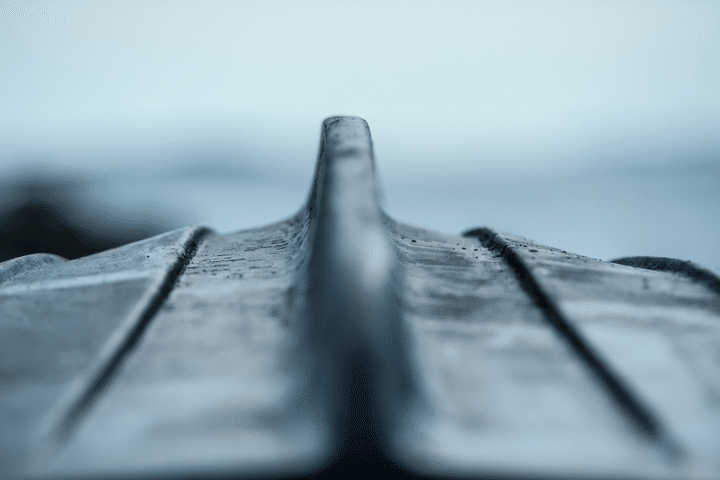
All sailboats have a keel, a flat blade sticking down into the water from the sailboat’s hull bottom. It has several functions: it provides counterbalance, life, controls sideways movement, holds the boat’s ballast , and helps prevent the boat from capsizing. When a boat leans from one side to the other, the keel and its ballast counteract the movement and prevent the boat from completely tipping over.
As with hulls, there are a number of different types of keels, though the two most common types of keels on recreational sailboats are the full keel or the fin keel. A full keel is larger than a fin keel and is much more stable. The full keel is generally half or more of the length of the sailboat. However, it is much slower than the fin keel. A fin keel, which is smaller than the full keel, offers less water resistance and therefore affords higher speeds.
A more recent feature on sailboats is the “winged keel,” which is short and shallow but carries a lot of weight in two “wings” that run sideways from the keel’s main part. Another more recent invention in sailing is the concept of the canting keels, which are designed to move the weight at the bottom of the sailboat to the upwind side. This invention allows the boat to carry more sails.
The Rudder
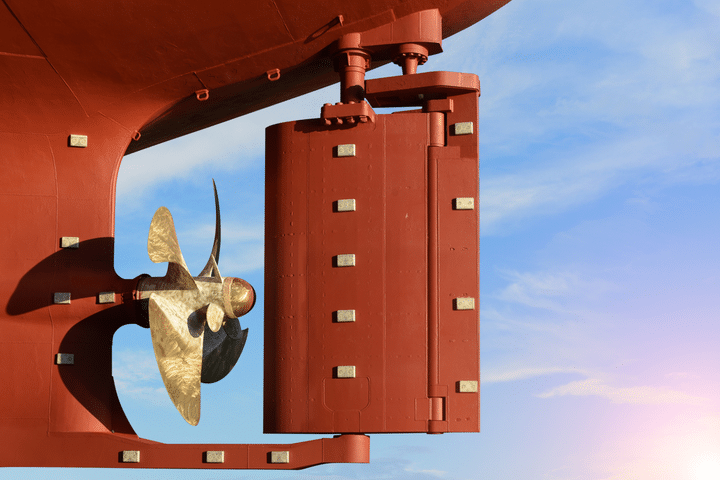
A rudder is the primary control surface used to steer a sailboat. A rudder is a vertical blade that is either attached to the flat surface of the boat’s stern (the back of the boat) or under the boat. The rudder works by deflecting water flow. When the person steering the boat turns the rudder, the water strikes it with increased force on one side and decreased force on the other, turning the boat in the direction of lower pressure.
On most smaller sailboats, the helmsman — the person steering the boat — uses a “ tiller ” to turn the rudder. The “tiller” is a stick made of wood or some type of metal attached to the top of the rudder. However, larger boats will generally use a wheel to steer the rudder since it provides greater leverage for turning the rudder, necessary for larger boats’ weight and water resistance.
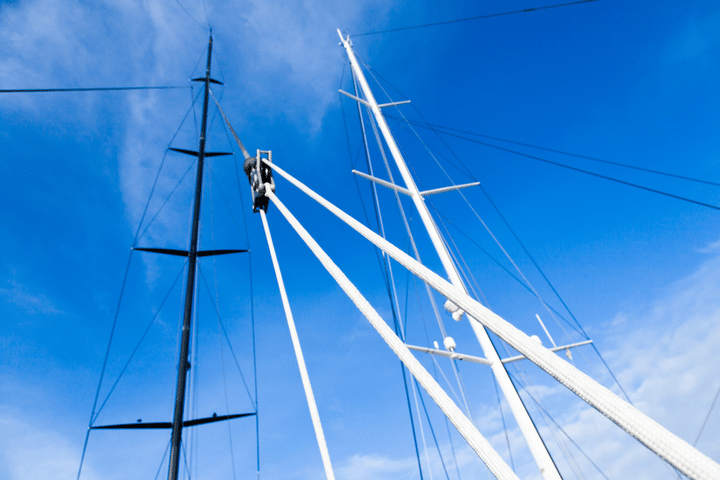
The mast of a sailboat is a tall vertical pole that supports the sails. Larger ships often have multiple masts. The different types of masts are as follows:
(1) The Foremast — This is the first mast near the bow (front) of the boat, and it is the mast that is before the mainmast.
(2) The Mainmast — This is the tallest mast, usually located near the ship’s center.
(3) The Mizzen mast — This is the third mast closest to the stern (back), immediately in the back of the mainmast. It is always shorter than the mainmast and is typically shorter than the foremast.
The Main Sail
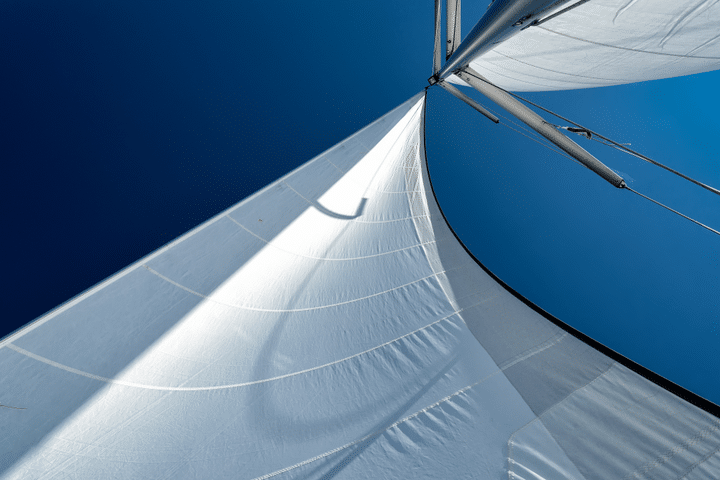
The mainsail is the principal sail on a sailboat, and it is set on the backside of the mainmast. It is the main source that propels the boat windward.
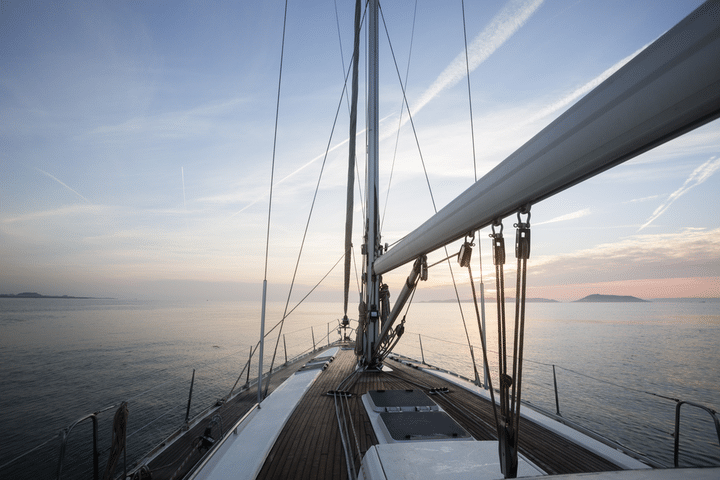
A boom is a spar (a pole made of wood or some other type of lightweight metal) along the bottom of a fore-and-aft rigged sail, which greatly improves the control of the angle and the shape of the sail, making it an indispensable tool for the navigation of the boat by controlling the sailes. The boom’s primary action is to keep the foot (bottom) of the sail flatter when the sail angle is away from the centerline of the sailboat.
The Kicking Strap (Boom Vang)
The boom vang is the line or piston system on a sailboat used to exert a downward force on the boom, enabling one to control the sail’s shape. The vang typically runs from the base of the mast to a point about a third of the way out the boom. It holds the boom down, enabling it to flatten the mainsail.
The Topping Lift
The topping lift is a line that is a part of the rigging on a sailboat, which applies an upward force on a spar (a pole) or a boom. Topping lifts are also used to hold a boom up when it’s sail is lowered. This line runs from the free end of the boom forward to the top of the mast. The line may run over a block at the top of the mast and down the deck to allow it to be adjusted.
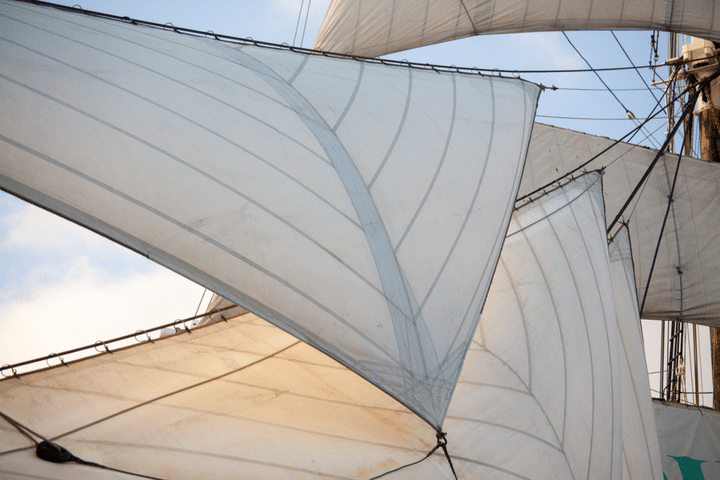
A jib is a triangular staysail set ahead of the foremost mast of a sailboat. Its tack is fixed to the bowsprit, the bow, or the deck between the bowsprit and the foremost mast. Jibs and spinnakers are the two main types of headsails on modern boats.
The Spinnaker
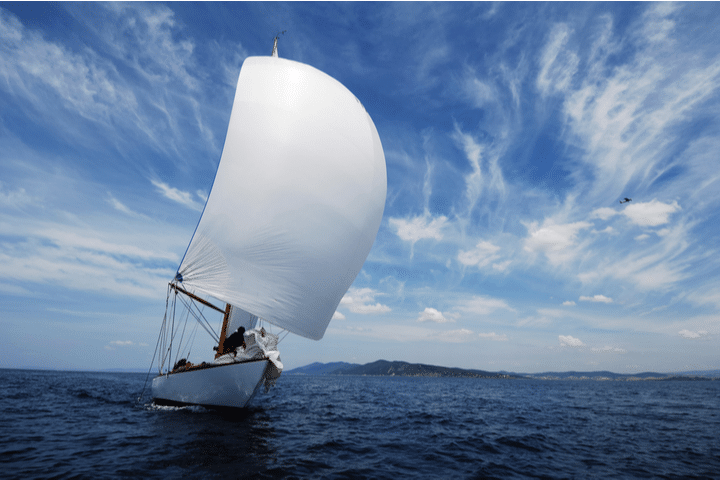
A spinnaker is a type of sail designed specifically for sailing off the wind from a reaching downwind course. The spinnaker fills up with wind and balloons out in front of the sailboat when it is deployed. This maneuver is called “flying.” The spinnaker is constructed of very lightweight material, such a nylon fabric and on many sailing vessels, it is very brightly colored.
Another name for the spinnaker is the “chute” because it often resembles a parachute, both in the material it is constructed from and its appearance when it is full of wind.
People often use the term genoa and jib as if they were the same thing, but there is a marked difference between these two types of sails. A job is no larger than a foretriangle, the triangular area formed by the mast, the deck or bowsprit, and the forestay. On the other hand, a genoa is larger than the jib, with part of the sail going past the mast and overlapping the mainsail. These two sails, however, serve very similar purposes.
The Backstay
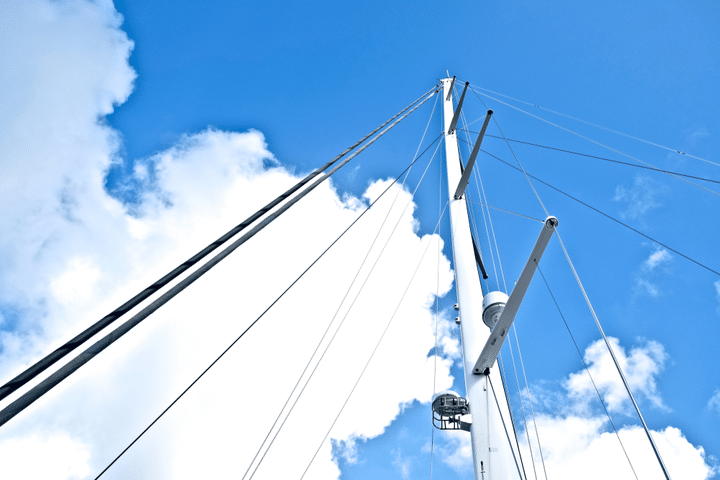
The backstay is a standing rigging that runs from the mast to the transom (the vertical section at the back of the boat), counteracting the forestay and the jib. The backstay is an important sail trip, control and directly affects the mainsail’s shape and the headsail.
There are two general categories of backstays:
1) A permanent backstay is attached to the top of the mast and may or may not be readily adjustable.
2) A running backstay is attached about two-thirds up the mast and sometimes at multiple locations along the mast. Most modern sailboats will have a permanent backstay, and some will have permanent backstays combined with a running backstay.
The Forestay
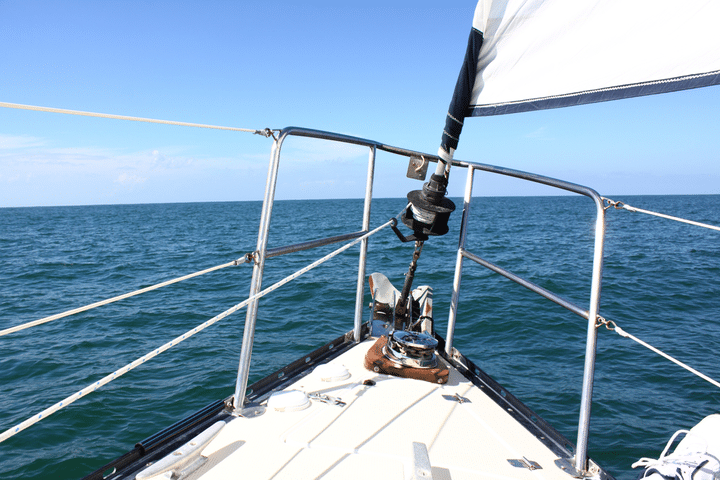
A forestay is a piece of standing rigging that keeps the mast from falling backward. It is attached at the very top of the mast, or at certain points near the top of the mast, with the other end of the forestay being attached to the bow (the front of the boat). Often a sail, such as a jib or a genoa, is attached to the forestay.
A forestay might be made from stainless steel wire, stainless steel rod or carbon rod, or galvanized wire or natural fibers.
Parts of a sail
Sails are vital for sailboats, made up of complex parts that improve performance and maneuverability. In this section, we’ll take a closer look at the different parts of that make up the sails.
Luff – The luff is a vertical sail part that maintains its shape and generates lift by interacting with the wind. It attaches securely with a bolt rope or luff tape for easy hoisting.
Leech – The leech controls air flow and reduces turbulence. Battens or leech lines are used to maintain shape and prevent fluttering.
Foot – The foot of a sail connects the luff and leech at the bottom edge. It helps define the sail’s shape and area. The outhaul is used to adjust its tension and shape.
Head – The sail’s head is where the luff and leech meet. It has a reinforced section for attaching the halyard to raise the sail.
Battens -The b attens are placed horizontally in sail pockets to maintain shape and optimize performance in varying wind conditions. They provide structural support from luff to leech.
Telltales – Sailors use telltales to adjust sail trim and ensure optimal performance.
Clew – The clew is important for shaping the sail and connecting the sheet, which regulates the angle and tension, producing energy. It’s located at the lower back corner of the sail.
Sailing is a favorite pastime for millions of Americans across the country. For some, there is nothing better than gliding across the water propelled by nothing more than the natural force of the wind alone. For both experienced and non-experienced sailors alike, Boatsetter is the perfect place to get your ideal sailboat rental from the mouthwatering Florida keys to the crystal blue waters of the Caribbean .
Smaller sailing boats are perfect for a single day out on the water, either by yourself or with friends and family. In comparison, larger sailing boats and sailing yachts can allow you days of luxury on longer excursions full of adventure and luxury.
Whatever your sailing dreams are, it is always good to know, for both the experienced sailor and the novice, all about the sailboat’s different parts. In this article, we learned all about the boat’s hull, the keel, the rudder, the mast, the mainsail, the boom, the kicking strap (boom vang), the topping lift, the jib, the spinnaker, the genoa, the backstay, and the forestay, which make up the basic parts of any sailboat you might find yourself on.
About us
Boatsetter is the go-to app for boat rentals and on-water experiences. Whatever the adventure, we’ve got a boat for that—Set sail , start the party , go yachting , make your trophy catch , and hone your watersports skills! Download the Boatsetter app ( App Store | Google Play ). Make sure to follow @boatsetter on Instagram, and tag us in all your boat day pictures for the chance to be featured.
Rent. List. Share—Only at Boatsetter

Boatsetter empowers people to explore with confidence by showing them a world of possibility on the water. Rent a boat, list your boat, or become a Boatsetter captain today.
Browse by experience

Explore articles
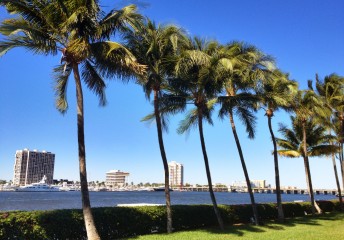
5 Ways to Boat Around West Palm Beach Like a Local
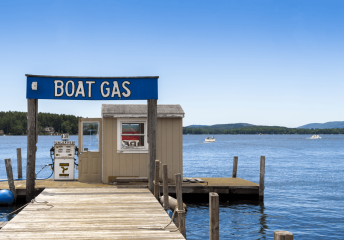
Boat Fuel Consumption: 5 Tips for Measurement, Efficiency, and Savings
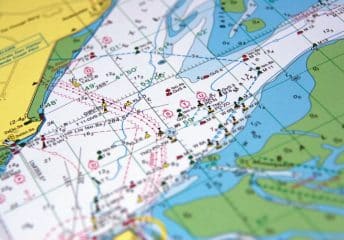
How to Read a Nautical Chart
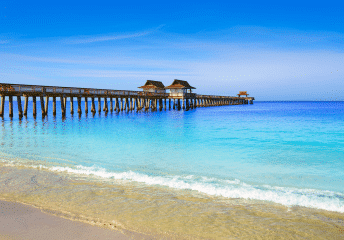
5 Best Beaches in Naples to Explore By Boat

My Cruiser Life Magazine
Illustrated Guide to Sailboat Parts [Updated 2023]
The lingo of sailing is baffling to many newcomers. While the actual sailing is pretty easy, it’s hard to wrap your mind around the bookwork when it seems like every little thing on a boat goes by its own nautical term.
Here are a few names for parts of a sailboat that you might not have thought about before. For even more nautical word play, check out our complete guide to sailing terms .

Parts of Sailboat Hulls
The boat’s hull is its main body. Most are made of fiberglass, but there are a few aluminum sailboat models out there too. Wood is more traditional but more difficult to maintain than these modern alternatives. Sailboat hulls are displacement hulls, which means they sit low in the water and move relatively slowly. The hull’s job is to displace water, so you stay afloat!
Bow The forward “pointy end” of the boat.
Stern The rear end of the boat.
Transom If the stern of a boat has a flat section, it is called the transom. (I wrote about it in detail here: What Is the Transom on a Boat )
Canoe Stern or Double-Ender Some boats lack a transom; instead, their stern comes to a point like a bow. This is a “double ender” or a canoe stern.
Port and Starboard Sides Port is the left side, and starboard is the right side.
Freeboard This is the height of the sides of the boat above the water.
Deck The upper portion of the boat that you walk on.
Sheer Sheer is the curve of the deck when viewed from the side. Some boats have none, and some boats have a lot.
Cabin Coach Roof Most sailboats have a raised coach roof on top of the cabin area.
Bottom of a Sailboat – Keels and Things
There are tons of parts on a sailboat that you only ever see if it’s out of the water. Boats are hauled out at boatyards by giant cranes, or a special machine called a travel lift .
Keel The boat’s keel is the underwater feature that counters the effects of wind pressure on the sails. It keeps the boat from tipping over, but it also keeps the boat going in a straight line as it moves through the water. If a boat has no keel, the wind will push it downwind.
A keel is heavy–it is weighted with thousands of pounds of ballast (usually lead). So when someone refers to a “keelboat,” they mean that it is a big boat with a weighted keel built for cruising. The built-in weight of a keel keeps the boat from capsizing. Also, the water flow over the curved surface of the keel helps the boat sail into the wind.
Smaller boats with centerboards or daggerboards are on the opposite end of the spectrum from keelboats. These aren’t weighted and could tip over (capsize) in the wrong conditions.
Types of Keels
Full Keel A classic and time-tested design, full keel boats are favorites among passage-making and ocean-crossing cruisers. They’re stable and comfortable at sea and very safe. However, they have a reputation for being slow compared to more modern designs.
Modified Full Keel The modification is a cut-away forefoot. That means it looks like a full keel, but there isn’t as much keel up near the bow. This reduces the underwater “wetted surface area” and makes the design a little bit faster while preserving the other good things about full keel designs.
Fin Keel The fin keel looks like a shark’s fin pointed downward. Some are narrow and very deep, while others are longer and shallow. Fin keels are bolted to the bottom of an otherwise flat-looking hull design. The fin has a foil shape that creates a lifting force as water flows over it. In addition to its ballasted weight, this opposes the sails and leeway. Most modern sailboats have some version of a fin keel.
Bulb Keel The ballast should be placed as low as possible to lower the boat’s center of gravity. The bulb keel is a fin keel with a lead bulb added to the bottom. The bulb has an efficient shape, making it more efficient than just the fin alone.
Wing Keel Like a bulb, a wing keel works by adding more weight and hydrodynamic force to the bottom of the keel. As a result, the wings look like a little airplane mounted on the bottom of a fin keel.
Swing Keel A swing keel is a fin that pivots up and into the boat, meaning that you can have a very shallow draft when you are docking or anchoring but also a very deep draft when you are sailing in open waters. This heavy keel requires a powerful and complicated electric or hydraulic-electric system.
Lifting Keel A lifting keel is similar to a swing keel, only the keel lifts up into the hull vertically.
Bilge Keels A bilge keel boat has two fin keels mounted at 45-degree angles below the hull. The advantage is that the boat can “dry out.” This makes them very popular in harbors around England, where the massive tidal range means that the harbor is only mud for half the day.
Centerboard Centerboards look like swing keels, but the “keel” part is just a board. It isn’t weighted with lead or iron, so it doesn’t change the ballast of the boat any. They are often found on smaller sailboats like sailing dinghies, but there are also large cruising boats that have full keels or long-fin keels with centerboards, too.
Daggerboard A daggerboard is like a centerboard, only it doesn’t swing. Instead, it goes straight up and down like a dagger into its sheath. They’re not only common on very small sailing dinghies but also large cruising catamarans.
Canting Keel Canting keels are some of the latest technology items in racing, so they aren’t found on cruising boats yet. They move from side to side, allowing the crew to precisely control the forces made by the keel.
Types of Rudders – What Steers a Sailboat
As with keels, you’ll see various types of rudders on sailboats. The rudder is one of the most critical parts of a sailboat’s equipment, so the differences in rudders are mostly about how protected it is from damage.
Rudder The rudder is the thing that steers the sailboat. It’s mounted on the back of the boat, sometimes looking a bit like a second keel. When the operator turns the steering wheel or tiller, it moves the rudder one way or the other. That, in turn, turns the yacht’s bow left or right.
Transom-Hung Rudder The most basic type of rudder is hung on the transom. It’s usually controlled with a tiller instead of a wheel. You can see a transom-hung rudder above the water.
Keel-Mounted Rudder On a full keel boat, the rudder will be mounted on the back edge of the keel. This protects it completely from damage since anything the boat might hit will hit the keel first.
Skeg-Mounted Rudder The rudder might be mounted to a skeg if a boat has a fin keel. A skeg is a small fixed surface that holds the rudder and supports it. In the case of a full skeg, it also protects the rudder as a full keel would.
Spade Rudder Spade rudders have no skeg, so the entire underwater surface moves when you turn the wheel. Most modern yachts have spade rudders because they are incredibly effective. They are easily damaged, however, which is why some offshore sailors still prefer skeg-hung rudders.
Bottom of Sail Boat – Running Gear
Running gear is the generic name given to all equipment under the boat that connects to the engine and moves the boat under power. It consists of the propeller, prop shaft, and supports.
Propeller Also called the prop or screw, the prop is what converts the engine power into thrust. The water flow over its blades creates a pushing force that moves the boat. Since the sailboat doesn’t use the propeller when it is sailing, sailboats often have folding or feathering props that stop moving.
Prop Shaft The metal shaft that connects the engine to the propeller is called the prop shaft.
Cutlass Bearing Where the prop shaft exits the hull, a rubber cutlass bearing keeps it centered and rotating freely.
Saildrive A saildrive is a common arrangement on modern sailboats that uses a vertical drive leg with the propeller. The saildrive installs on the back of the engine and includes the transmission. It’s like the lower unit of an outboard motor, but you cannot raise it out of the water.
Up Top – Types of Sailboat Designs
Aft Cockpit The “classic” design of the modern sailboat, if there is such a thing, is called the aft cockpit. This layout has the cockpit in the rear-most section of the hull, behind the cabin.
Center Cockpit The center cockpit sailboat has the cockpit closer to the mast. That leaves a lot of space in the rear of the hull for a huge stateroom. This design means that the cockpit will be closer to the boat’s center, making handling easier. But it is also higher, making more windage and motion at sea.
Pilot House A pilot house sailboat has a second helm inside a protected area. These are popular in colder climates, where the pilot house provides a warm place to steer the boat from. The rear cockpit is usually smaller than a typical aft cockpit, but it’s still where the sail handling occurs. A pilot house has a raised level, so the salon typically surrounds the interior helm to utilize that space and visibility when not underway.
Deck Salon Like a pilot house, a deck salon has big windows and better visibility than a typical sailboat cabin. But it lacks a true interior helm. Many, however, have nav stations with forward visibility and autopilot controls, making it a comfortable place to sit and keep watch during a passage.
Flush Deck Most sailboats have a raised coach roof where the interior cabin is. But some designers make their decks flush with the sides of the boat, making a wide open deck that is easy to move around on.
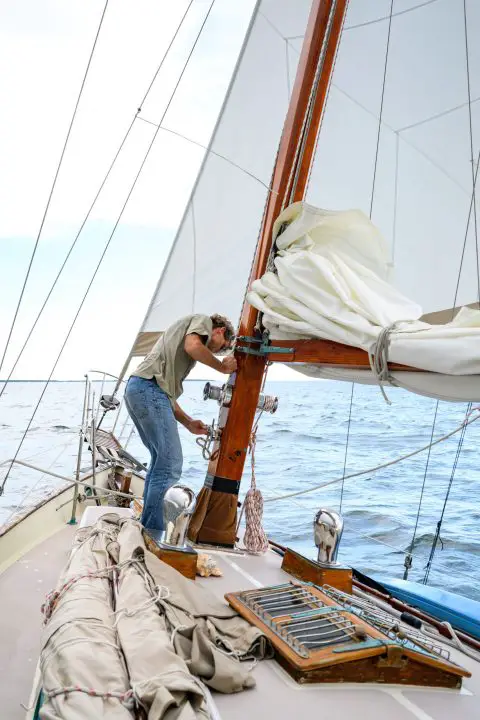
On Deck Sailboat Components – Sailboat Front
The deck of a sailboat is all about safety at sea. Most modern cruising boats are rigged such that there are few things you might need to go “out on deck” or “go forward” for. Instead, these things are rigged back to the cockpit, so you can stay safe and dry while doing your thing.
Since the wet pitching deck of a sailboat at sea is tricky, many of the things you’ll find there are safety-related.
Handholds Places to grab should be located all over the boat, so there’s never a risk of not having something to hold onto to stabilize yourself.
Lifelines Lifelines run the perimeter of the boat and provide a last-ditch safety device. You can grab them, and they should be high enough that they’ll keep you from going overboard.
Stantions The stands that lifelines attach to.
Bow Pulpit The solid rail around the front of the boat provides a safe handhold and a starting point for the lifelines.
Stern Pushpit The same, but on the stern of the boat.
Bulwarks The raised edges of the deck on the sides so that you can’t slip overboard on accident.
No-Skid Decks In areas where people will be walking, the deck is treated with a special product to make the deck “no-skid.” That way, it isn’t slippery, even when wet.
Harness Sailing harnesses are designed to clip onto the boat and keep a sailor onboard even if the boat takes a huge wave or the sailor slips. The harness is the staple of offshore safety.
Jack Lines Jack lines are temporary lines secured on the deck where sailors can attach their harnesses.
Safety Rails Many boats also have extra rails and handholds located in spots where sailors might work on deck, like around the base of the mast.
At the bow of the sailboat, you’ll find her ground tackle.
Bowsprit The bowsprit is the spar that extends from the deck forward of the bow. They’re used on sailboats to gain more sail area since getting the sail farther forward means you can fit a bigger sail. Some have just a spar, while others have a bow platform that is part of the deck.
Ground Tackle The generic word for the anchor, chain, and all the equipment needed to use it.
Anchor The anchor is “the hook” that digs into the seabed and keeps the boat in the same place. Anchors are safety devices since they allow you to stop in shallow water. But they also provide access to areas with no marinas since you can anchor offshore and go in on your dinghy.
Windlass A winch that pulls up the anchor and chain. They can be manual, with a handle, or electric, with a button.
Anchor Rode The generic name for the anchor line. It can be a chain or rope.
Snubber A short length of rope that attaches to the chain to secure it to the boat.
Cleat A horn-shaped piece of deck hardware used to secure a line or rope.
Dorade A large vent opening on the deck of a boat which is designed to let air in but not water.
Hatch Hatches are upward-facing windows that you can open to increase ventilation in the cabin.
Locker A generic term for a cabinet or compartment on a boat.
Going Aloft – Basic Boat Parts of a Sailing Rig
The rig of a boat is the mast and all of its associated parts. If you’re wondering about the many different kinds of rigs that are out there, check out our rundown on sailing terms . There you’ll find definitions for boats with just one mast or multiple masts, like sloop rig and what a boat with two sails in front might be called. It’s a cutter, if you’re wondering.
Spar A generic name for a mast, boom, or any other long pole used to hold a sail. It can be wood or metal or vertical or horizontal.
Mast A vertical spar upon which a sail is hoisted.
Boom A horizontal pole that holds a sail and gives it shape.
Standing Rigging The wires or rope that holds the mast upright.
Stay Standing rigging that goes fore to aft. The head stay runs from the masthead to the bow, and the backstay runs from the masthead to the stern.
Shroud Standing rigging that goes to the sides of the boat. From the masthead to each side runs a cap shroud. Some masts also have intermediate and lower shrouds.
Running Rigging All lines that are used for sail handling are called running rigging.
Halyard A halyard hoists a sail to the top. Each halyard is named for the sail it hoists, i.e., main halyard, jib halyard, spinnaker halyard.
Sheet The sheet controls the sail. If you ease the sheet, the sail is loosened. If you winch the sheet in, it is tightened. Like all running rigging, each sheet is named for the sail it controls, i.e., main sheet, jib sheet, etc.
Traveler If a sail has a boom, the traveler can be used to adjust it from side to side. The sheet is attached to the traveler. Most main sail travelers are located near or in the cockpit.
Gooseneck Fitting The articulating attachment that holds a boom on a mast.
Topping Lift A line that holds the rear end of a boom up. It runs from the masthead to the boom.
Vang A control line pulls the boom down and puts pressure on the sail to keep it flatter. Large boats may have hydraulic or solid vangs.
Blocks The rest of the world would call this a pulley, but sailors call it a block.
Fairleads Deck organizers that keep the lines tidy and running in the direction they should go on deck.
Furler Wraps the sail around the stay so that it doesn’t not have to be raised and lowered each time. Instead, you pull on the sheet and the sail unrolls or “unfurls.”
On Deck – Back of Sailboat
On most boats, the cockpit is located at the back.
Cockpit The main operations center and party central on a sailboat. This is where the skipper sits at the helm, and the linesmen control the sheets.
Coaming The cockpit is protected from waves and splashes by the coaming, the tall walls that enclose it. It also makes the cockpit safe since you are unlikely to get swept overboard from here.
Lazarette The main storage locker in the cockpit.
Helm The station where the skipper steers the boat from.
Tiller If a boat doesn’t have a wheel, it will have a tiller. A tiller is just a handle connected to the rudder, and the skipper pushes or pulls it to steer. Even if a boat has a wheel, it probably has an emergency tiller in case the steering system breaks.
Winch Winches provide a mechanical advantage to make it easier to haul in lines. In the cockpit, all the sheets have winches.
Rope Clutch A clutch locks a rope in place so it can be taken off a winch, even when loaded.
Jammer A jammer does the same as a clutch, but it’s a simpler device found on smaller boats.
Weathervane Steering A weathervane is used to steer the boat like an autopilot but uses wind direction and mechanical linkages. As a result, they use no power and never complain about their workload. They mount on the stern of the boat and are controlled by simple lines to the cockpit. Windvanes are often referred to by their brand name, i.e., Monitor or Hydrovane
Davits Arms on the back of the boat that lift the dinghy or tender.
Swim Platform A flat area on the transom that allows you easy access in and out of the water. A standard feature on newer boats but not on older ones that just had long swim ladders.
Catamaran Sailboat Parts Explained
For the most part, the components of a catamaran share the same terms and labels that they would on a monohull. Cats often have a few extra features with other names, however.
Hulls A catamaran is made with two hulls connected together. Each hull has an interior, just like a monohull sailboat does. The cabins and heads are usually located in the hulls, and sometimes the galley is also down below.
Owner’s Version A catamaran layout that is made for private owners. Usually, one hull will be dedicated to the owner’s stateroom with a private door, a huge head with a walk-in shower, and a large berth.
Charter Version It has more staterooms and heads than an owner’s version does. Usually, a charter cat has at least two staterooms and heads in each hull.
Bridge Deck The deck connects the two hulls, which usually has the salon and cockpit. If the design is “galley up,” the galley will be on the bridgedeck with the salon.
Cockpit Just like on a monohull, the cockpit is the operations center. But catamarans have huge cockpits, and there is usually a large outdoor dining table and entertainment area as well.
Forward Cockpit Some designs have lounge seating forward of the salon on the bridgedeck.
Flybridge Some designs have the main helm mounted on top of the salon on an upper level. It’s almost the catamaran equivalent of a center cockpit.
Trampolines Forward of the salon, the bridge deck stops, and a trampoline connects the hulls over the water. This is a great place to hang out, but it’s an integral safety feature for a catamaran. The trampolines allow any water to immediately drain away, not weighing the boat down on the bow. This prevents a pitchpole when a boat capsizes by tipping forward into the water.
Cross Beam and Dolphin Striker Since there is no center bow to mount the head stay and foresail, catamarans use a cross beam that connects the hull. A piece of rigging keeps this in place, and it’s called the dolphin striker. No dolphins were hurt in the rigging of these boats, however.
Anchor Bridle Instead of a single snubber line on the anchor, catamarans use a wide bridle that connects each hull bow to the anchor line.
Parts of a Sail Boat FAQs
What are parts of a sailboat called.
Sailing is a challenging hobby, and one reason it’s so difficult for beginners is because every part of a sailboat has its own name. From each wire and rope to every piece of deck hardware, a beginner must learn the basics before they can even start.
What is the front part of a sailboat called?
The front part of a sailboat is called the bow. Many boats also have a spar extending forward of the hull, called the bowsprit.
What are the 5 basic parts of every sailboat?
Every sailboat has at least these five parts, but most boats have many more. Hull Keel Rudder Rigging Sails
Matt has been boating around Florida for over 25 years in everything from small powerboats to large cruising catamarans. He currently lives aboard a 38-foot Cabo Rico sailboat with his wife Lucy and adventure dog Chelsea. Together, they cruise between winters in The Bahamas and summers in the Chesapeake Bay.
Leave a comment
Your email address will not be published. Required fields are marked *
Save my name, email, and website in this browser for the next time I comment.

Catamaran Parts Explained: Interactive Guide (For Beginners)
As an Amazon Associate, we earn from qualifying purchases. We may also earn commissions if you purchase products from other retailers after clicking on a link from our site.
Learning a new skill can sometimes be time-consuming, and learning to sail also means learning a new language with tons and tons of new words that, in the beginning, makes no sense at all.
Some of the words you will read about in this article stem from the early days of sailing. Some are only a decade old; in this article, I have tried to compile all the basic terminology that I believe a beginner needs if he or she wants to understand sailing and catamarans.
Feel free to use this article as a resource and come back to it when you want to look something up or just to learn more!
Table of Contents
Main sections on a catamaran
- Hulls; are what separates a cat from other sailboats, a catamaran has two hulls, a trimaran three, and a regular sailboat, aka monohull, has one. The hull is the part of the sailboat which makes it float and to where all other things are attached. The hulls are usually divided into sections, such as usable and non-usable area. An example of a usable area is the engine room.
- Cockpit ; is from where the boat is maneuvered; it is to here that all halyards, sheets, etc. go. The cockpit contains navigation and steering equipment and is from where the sails, rudder, and engine are controlled.
- Deck; is the top part(roof) of a catamaran covering the hulls and bridge deck. The deck is made hard enough to walk on. To the deck, attaches lifelines and other equipment.
- Sugarscoops ; are the aftmost part that gets their name from their scoop-shaped appearance; this is where the deck/cockpit meets that water and usually encompasses a stair or ladder for easy access depending on the size of the boat.
- Cabin; is basically any area on the inside of the boat that is protected from the weather and is made to offer the crew space to rest, eat, and hangout. Inside the cabin, you will find berths (beds), a galley (kitchen), and sometimes specialized areas for repairs or storage.
- Bridgedeck; connects the two hulls; the inside is the cabin, the top part is the deck, and the entire unit is called the bridge deck. Bridge deck clearance, the bridge deck’s height above the water, is an important factor on a catamaran since a too small clearance will create excess noise and vibrations and fatigue not only the crew but also the boat.
Main areas on a catamaran
Bow (front).
Nothing complicated here; the bow is just a nautical term for the foremost part of your boat. This is where the waves and the sea first meet the hull and depending on the type of boat, the bow(s) can be shaped differently.
Center (Middle)
The part between the bow and the stern is rarely called the center part( middle) of a boat; more common is to speak about the specific area situated within the middle part of the vessel, such as the cabin or the mast.
- Cockpit; as mentioned above, here you will (usually) find everything that you need to maneuver and navigate the boat, such as a compass, GPS, sheets, steering wheel, and throttles for the engines. Some boats may not be set up this way and require you to move around the boat to access certain controls.
Cabin (inside of the boat)
The boat’s interior is where you will find everything that is made for the crew’s enjoyment; it is a place to eat, sleep, rest up, and hide away from nasty weather.
- Berths; is a bed; sailors need to sleep too!
- Galley ; is another name for kitchen, usually set up in a very primitive way with a gas stove on a stabilized platform to ensure your food won’t get tossed around.
- Navstation; or navigation station, is a place, usually with a table, chair, and equipment for planning and logging a journey.
Stern (Back)
Stern is the name for the rearmost part of the boat; there is no clear definition as to where the stern stops and other parts begin, so it is something that the crew will have to figure out on their own through good communication.
Communicating directions on a sailboat
Not only will you have to know the different names of different areas on the boat, but it will also be essential to communicate clearly in what direction something is happening, for example, in a situation where you, the captain, want the crew to observe in a specific direction or pick up a piece of gear somewhere on the boat.
Communication on a sailboat is vital when you want to sail safely and efficiently; here, I have listed the words or phrases used to communicate a direction.
- Forward; easy as it sounds, it is the same direction as where the bows are pointing. When giving directions towards or beyond the bow, you will use the word “forward” for example; the fender is located forward of the mast.
- Aft ; is the behind the boat. When you are giving directions towards the stern, you will use the word “aft”; for example, the cockpit is located aft of the mast.
- Port ; this will be your left side. Fun fact, in the good old days, you would always dock with the port on your left side; hence port is the left side. If you ever forget which one is which, “port” has 4 letters and so has the word”left”!
- Starboard ; is your right side!
Types of sails
Sails come in very different shapes and sizes and are a science in itself; in this article, I will focus on the mainsail and three common types of staysail.
- Mainsail; is, per definition, the sail attached to the mast; its sideways movements are controlled by the boom. When the mainsail is triangular in shape, as on most modern sailboats, it is called a Bermuda rig. Most mainsail uses something called battens.
- Staysail; mainly comes in two versions, a staysail that does not overlap the mainsail is called a jib. A staysail that is larger and thus overlaps the mainsail is called a genoa.
- Spinnaker ; is a big balloon-like sail that replaces the jib when sailing downwind.
Parts of a sail
- Luff; the front part of the sail, is connected to the mast through a rail system which makes it possible to hoist or reef.
- Leech; the back part of the sail.
- Foot; the bottom part that reaches from the clew to the tack.
- Clew; back bottom corner.
- Tack; is the front bottom corner (remember “tacking”?).
- Head; is the top triangle of the sail and this is where the mainsail halyard attaches.
- Battens; are pieces of flexible material sewn into the mainsail to increase its aerodynamic shape. Battens can be full length or partial length.
Standing rigging
Everything that keeps the sails and mast upright are parts of the standing rigging; it is comprised of wires, cables, and lightweight metal structures.
- Forestay; usually a metal wire running from the top of the mast to the bow, is sometimes combined with an inner forestay that connects to the mast at a lower point. If the forestay attaches to the top of the mast, the setup is called a masthead rig; if it attaches lower, it is called a fractional rig.
- Backstay ; same as the forestay but attaches to the stern; most catamarans do not employ a backstay system but instead moves the side stays aft.
- Shroud ; much like the forestay but stabilizes the mast sideways and runs from the top to the port or starboard side. Spreaders are used to change the angle of the wire against the mast and better support the mast.
- Sidestay ; connects to the mast below the shrouds and is not pushed outwards with spreaders. On a catamaran, these attach aft of the mast to eliminate the need for a backstay; this makes it possible for a fully battened mainsail with a large roach.
- Jumpers; are used on a fractional rig with diamond shrouds to add structural integrity to the mast without adding excess weight.
- Bowsprit; is a pole amidship at the bow that allows for separation of the tacks (foremost, lower part of the sail) for increasing sail efficiency when using two headsails.
Other stabilizing parts
- Spreaders; act to lessen the angle between the shrouds and the mast; a wider angle will result in forces acting sideways (stabilizing) instead of up and down (bending). This increases stability and decreases the risk of unwanted bending of the mast.
Running rigging
The running rigging on a catamaran is any piece of equipment used to control the shape of the sails, including what is needed to raise them.
- Sheet; are the ropes (or wire, cables, etc.) that connect to the clew of a sail; on a catamaran, it connects to the staysail (genoa or jib, depending on the shape).
- Mainsheet ; is the rope that makes it possible to change the mainsail’s angle; the mainsail can only move in a port to starboard direction(right and left) and not up and down.
- Staysail sheet ; is called after whatever type of sail it is connected to, i.e., jib sheet or genoa sheet. Worth notice is that since the staysail operates on both sides of the catamaran (depending on if your tacking or gybing), it is connected with two ropes, one for the port side and one for the starboard side.
- Halyards ; are the ropes that connect to the top of a sail and make hoisting (or raising) possible. Halyards have different names depending on what sail they are raising, such as Mainsail halyard or jib halyard. Not to be confused with sheets that act upon the sail once they are already hoisted. If the staysail is using a roller furling, then “hosting” is done differently.
- Furling line; is used together with a roller furling and makes it possible to spool up the sail on the forestay instead of raising and lowering. This makes for a faster and easier way to reduce sail area.
- Reefing lines; reefing is when you lower parts of your sail to reduce the sail area and reduce the boat’s power and speed; reefing lines are put through holes in the mainsail and attach to the boom.
- Boom vang; is connected between the boom and deck; it is used to change the mainsail’s shape by pulling downward on the boom. (not very common on Catamarans)
In this category, we will look at the hulls and some of the vital parts that attach to them under the waterline.
- Hulls; differ in their shapes depending on the boat’s purpose, a racing cat would have narrower hulls to reduce drag, and a cruising cat wider hulls to encompass more storage.
- Rudder; is what changes the direction of the boat. When water passes around the rudders(two on a catamaran), it creates a “pushing force” that makes the boat turn. The rudder is connected to a steering wheel or a tiller at the cockpit through chains and linkage.
- Centerboard and daggerboards ; are sorts of keels that can be raised or lowered to attain certain sailing characteristics. When the keel is up, drag is lower, and so is the draft (how deep the boat sticks in the water). A small draft makes it possible to travel in very shallow waters. The difference between a daggerboard and a centerboard is that a centerboard swivels into place, and a daggerboard is pulled straight up.
- Mini-keel; is just what it sounds like; it is a keel but very small (a few inches deep) and has no ballast.
- Crossbeam ; is a multihull-only feature and keeps the two hulls from moving in relation to each other. If the crossbeam is damaged or nonexistent, the bridge deck is the only thing that keeps the hulls in place. This will increase wear and sooner or later lead to cracks, or even worse, separation of hull and bridge deck.
Most catamarans have two engines, one on each hull aft the stern; usually, they are internal with only the propeller in the water. The other option, which is cheaper and most often found on smaller boats, is to have one outboard engine placed amidship (middle).
- Inboard ; engines are situated in a compartment inside the boat at the stern. On an inboard engine, the propeller and the shaft are the only parts outside the hull. Sometimes the prop shaft (propeller shaft) is replaced by a sail drive.
- Outboard ; is a standalone engine usually mounted on the bridge deck amidship(if only one is used) or mounted at the sterns when used in pairs. They are linked together with pushing rods and wires so it can be manipulated from the cockpit.
- Saildrive ; is a type of gearbox that is quieter and vibrates less than a regular propeller and shaft setup.
- Propeller and shaft; are the most common and cheapest way to propel your boat. It is basically just a watertight axel that sticks out of the hull, and at the end of it, you’ll find the propeller.
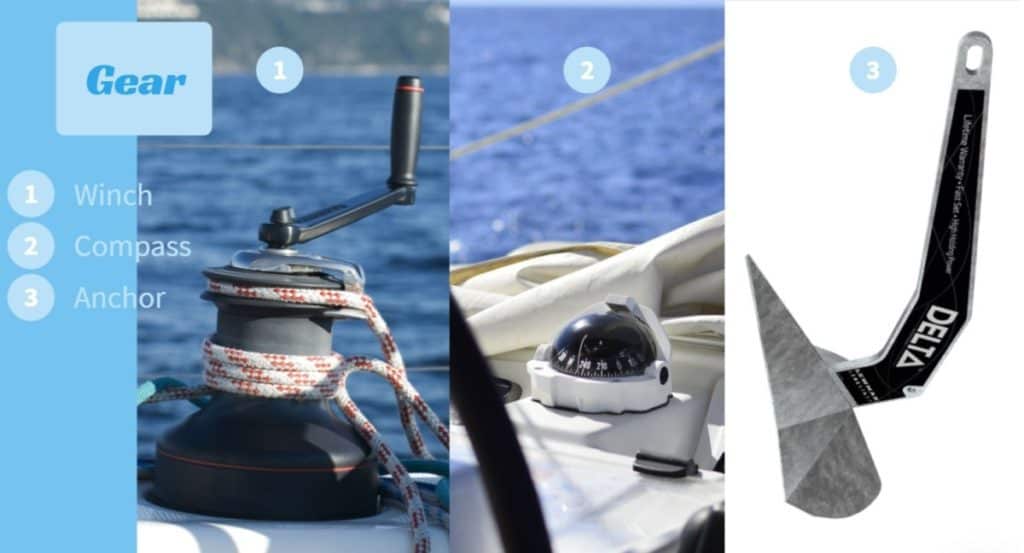
There are so many pieces of gear aboard a catamaran that an all-encompassing article would probably fill up the entire internet. Below I have listed the most common equipment that you will most likely encounter on any sailboat.
- Winches; makes handling lines and ropes much easier. Instead of pulling them with your bare hands, you loop them around your winch and use the handle to crank. Winches come in mechanical style or electrical style.
- Anchors ; is basically just a big hook made to stick to the bottom of the sea. Anchors have different shapes and weights depending not only on the seabed but also on the boat’s weight and size.
- Navigation ; compass, GPS, and maps are all vital pieces of equipment making your trip safe.
- Cleats ; is any equipment that is made to fasten a rope. Cleats come in different configurations; jam, cam, rope clutch, or the most common horn cleat.
- Block ; is a device that can be used in pairs as a pulley (to reduce the force needed to lift something) or on its own to reduce the friction of a rope when the rope can not be drawn in a straight line.
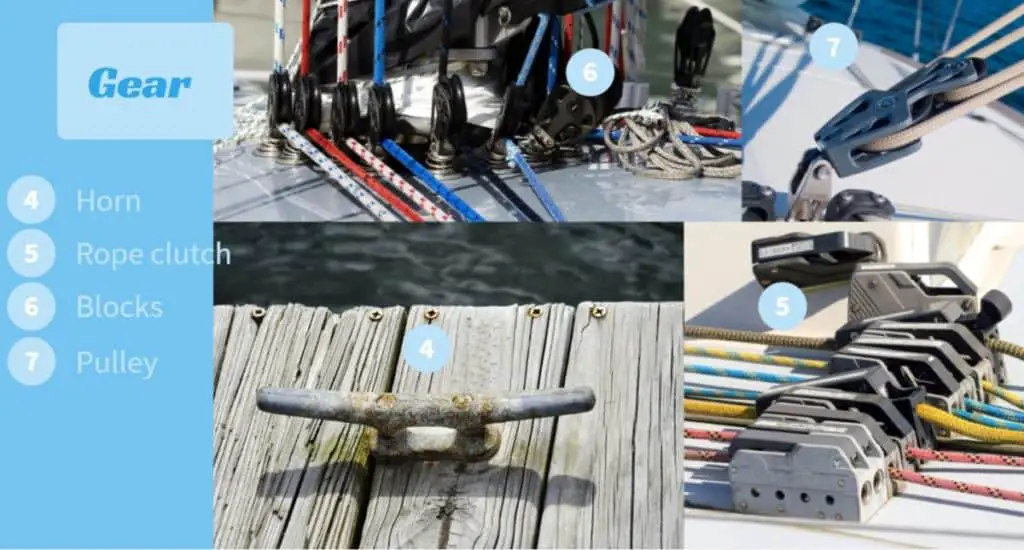
Owner of CatamaranFreedom.com. A minimalist that has lived in a caravan in Sweden, 35ft Monohull in the Bahamas, and right now in his self-built Van. He just started the next adventure, to circumnavigate the world on a Catamaran!
Leave a Reply Cancel reply
Your email address will not be published. Required fields are marked *
Save my name and email in this browser for the next time I comment.
Recent Posts
Must-Have Boat Gear for Catamaran Sailors!
Sailing is probably the most gear-intensive activity I've ever done; there are so many decisions to be made about what gear to buy now, for tomorrow, and what to definitely never buy. The gear on...
6 Best Trailerable Trimarans For Bluewater and Coastal Sailing
Having a boat costs a lot of money, even when you are not using it, marina fees, etc. And once it is in the water most sailors never go very far from their "home marina" and sailing will be somewhat...
Call Us (561) 445-5664
What Are the Different Parts of a Yacht?
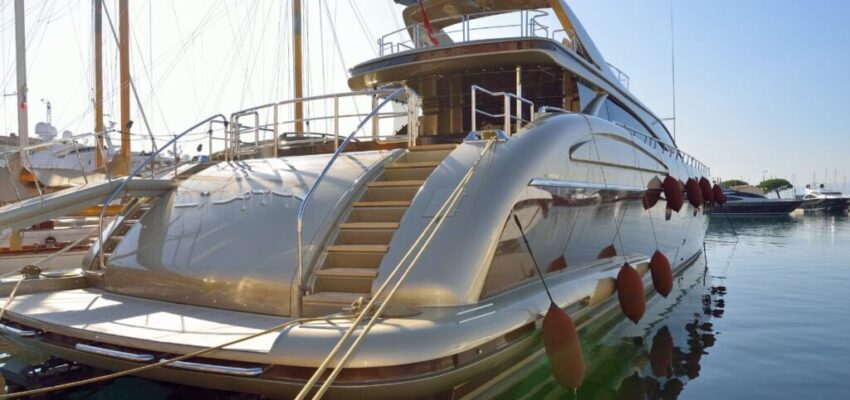
Published February 20, 2023
A yacht trip is, first and foremost, a relaxing experience. However, to individuals with a keen interest in watercraft, particularly yachts, it also serves as a valuable learning experience.
It’s a chance to learn about yachts, after all. But as always, it can be difficult to make the most out of the experience, especially if you know close to nothing about the subject matter.
So, in this article, we’ve compiled a list of the different parts of a yacht that you may come across during your trip. Keep in mind that a yacht is technically a boat , so you may notice that the yacht anatomy is fairly similar to the anatomy of a regular boat.
The hull is the main body of the yacht. It has an exterior, which is the part that you can see and touch, and an interior framework. Most of the parts of a yacht are connected to the hull.
However, the hull is usually not relevant to guests since you won’t ever have to touch or interact with it during a yacht trip.
The deck is the roof of the hull and is basically the part where you walk in. In other words, it’s technically the floor of the yacht.
The cockpit is the area located on top of the cabin. It’s where you’ll find the helmsman or driver. It typically consists of a seating area where the staff or passengers can sit.
The hardtop is the roof of the cockpit which serves to protect the driver or passengers from the sun and weather. The hardtop of some yachts may also have a storage area.
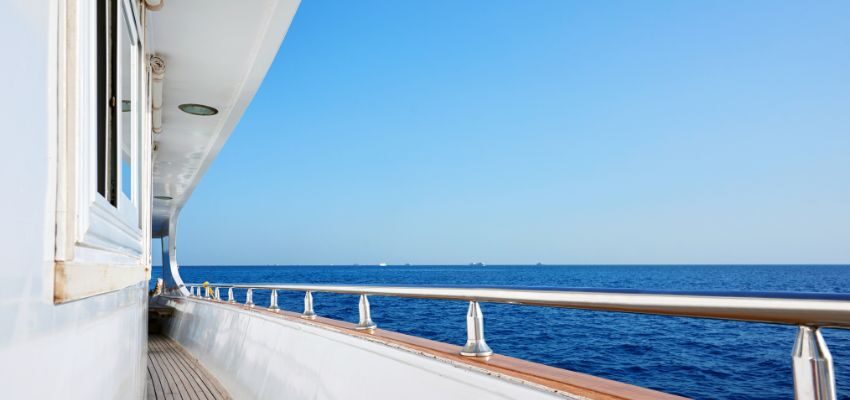
The bow is the front part of the boat. It’s also usually the best place to stay during the trip since it quite literally gives you a front-row seat of the scenery.
The cabin refers to a single room in the yacht, though people use it more common to talk about the entire interior. For example, if someone says you must go to the cabin, they’re telling you to go inside the yacht. These are where you’ll find most of the amenities.
The berth corresponds to the bunk or bed of the yacht. The keyword here is “bed,” so it’s not the bedroom itself. The term may also refer to the designated location in a harbor or port where the yacht docks in, though that’s not relevant if you’re simply renting a yacht.
The dinette is the dining area of the yacht. It consists of seats and tables. Unlike the berth, it’s not always going to be in the cabin. The dinette can also be on the exterior.
The galley is the yacht’s kitchen. It can either be at the interior or exterior of the yacht.
The saloon is the living room of the yacht and is typically in the cabin.
Casting Deck
The casting deck , also known as the casting platform, is a flat surface at the front or back of the boat. It’s designed so you can fish from the yacht without obstructions.
The casting deck would often have parts that aid with the fishing experience, such as a mount for a casting chair, rails for safety, and a livewell to store caught fish or bait.
Swim Platform
The swim platform is a flat surface at the back of the yacht. It’s the part you step in first when boarding the boat. The platform is designed to make getting on the yacht easier.
There are many other parts of a yacht that we didn’t mention, but most of them are not relevant to passengers such as yourself. With this, you should be able to navigate a yacht more easily, whether you got the yacht rental for parties or for a relaxing trip.
Experience Yacht Charters With Seafari In Boca Raton Florida
Looking for a great time on the water in Boca Raton Florida? Seafari Yacht Charters is number choice for yacht rentals in Boca Raton . Book our yachts for parties , exciting day trips to the Bahamas, romantic yacht dinner cruises , and much more. Come experience all South Florida has to offer with us.
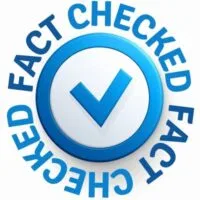
Fact Checked By Experts
Our team of internal experts has conducted rigorous fact-checking on this content. Explore the editorial standard for our website to dive deeper into our commitment to excellence.

About The Author
Lenard Arceo is passionate about the outdoors and South Florida life. He is a professional blogger for several renowned publications and also loves learning how to code in his free time.
Related Posts
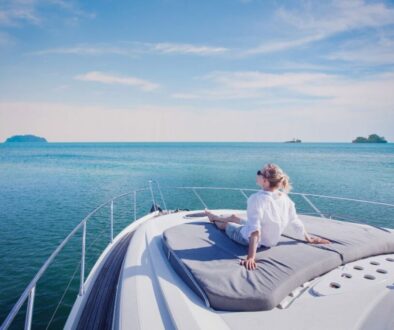
Yachting Benefits You Might Not Know
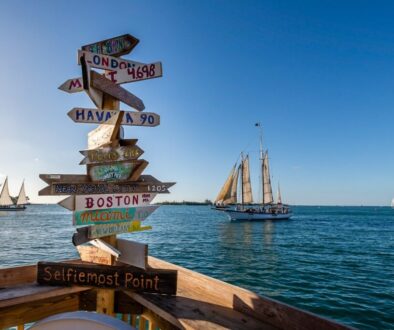
Most Popular , Yachting
How To Charter A Boat From Miami To Key West
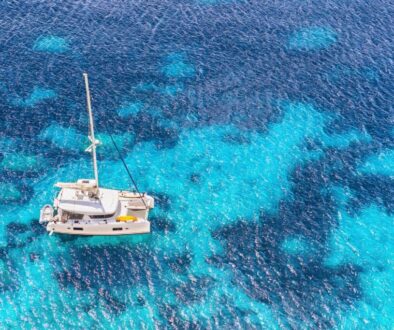
What To Know Before Renting A Catamaran Charter
Find us on social media.

© SeafariYachtCharters.com 2024
View Our Privacy Policy
Website design by Correct Digital
Watch CBS News
Who are the victims in Baltimore's Francis Scott Key Bridge collapse? What we know about those missing and presumed dead
By Adam Thompson
Updated on: March 29, 2024 / 8:06 AM EDT / CBS Baltimore
BALTIMORE - Six workers missing after the Francis Scott Key Bridge collapsed early Tuesday morning are presumed to be dead, the U.S. Coast Guard announced after a day of search and rescue efforts.
The search for the six became a recovery effort Tuesday evening. Two bodies were recovered from the site of the collapse in a red pickup truck Wednesday morning.
State Police said the search has moved to a salvage effort because officials believe the four still missing are in vehicles encased in the bridge debris. Divers are no longer able to operate around the debris.
The span was struck by a cargo ship shortly after it left the Port of Baltimore early Tuesday morning.
Officials say that eight people were working on the bridge at the time of the collapse. Two people were rescued from the water shortly after Tuesday's collapse. One of the rescued workers was unhurt, the other was treated at the University of Maryland Medical Center and has been discharged.
Who were the bridge collapse victims?
The men were working for Brawner Builders, filling potholes on the center span of the bridge at the time of the collapse. They were originally from El Salvador, Guatemala, Honduras and Mexico.
One of the missing workers from El Salvador was identified as Miguel Luna by the nonprofit organization CASA.
"He is a husband, a father of three, and has called Maryland his home for over 19 years," CASA executive director Gustavo Torres said in a statement Tuesday night, noting Luna was a "longtime member of the CASA family."

A former coworker, Moises Diaz, described Luna as a kind person who worked hard and always shared his food with other workers and friends. In an interview with CBS News, Diaz said he considered Luna like a brother.
Maryland State Police identified the two men found in the red pickup truck as Dorlian Cabrera , 26, who was originally from Guatemala and lived in Dundalk; and Alejandro Hernandez Fuentes, 35, who lived in Baltimore and was from Mexico.
The Honduran Consulate confirmed Maynor Yassir Suazo Sandoval, 34, was among the missing. His brother, Carlos Alexis, described him as a kind, big-hearted and funny family man who came to the U.S. when he was about 20. He had a teenage son and a 5-year-old daughter.
Jose Mynor Lopez, 35, was originally from Guatemala. His wife, Isabel Franco, told WJZ he moved to the U.S. 19 years ago and was a loving father to their child and three stepchildren
"He had a good heart. He was a hard worker. He was always worried about his family too. He died but he was fighting for us always," she said in Spanish.
The sixth victim, a man named Carlos whose full name has not been released, was also from Mexico.
Recovery mission paused, salvage begins
The search for bodies was paused Wednesday as attention turned to clearing debris from the deadly collapse and reopening the Port of Baltimore.
The bodies of two construction workers were recovered from a submerged truck Wednesday. Four people remain missing and are presumed dead, but divers can no longer operate around the mangled bridge debris that has encased submerged vehicles, officials said.
The span was struck by a cargo ship that had lost power shortly after it left the Port of Baltimore early Tuesday morning.
The U.S. Navy is mobilizing barges outfitted with heavy lift cranes to help clear the Patapsco River of debris.
Three cranes with varying lift capacities and support vessels are expected to begin removing submerged portions of the bridge. Two cranes arrived by Friday morning.
"This was so completely unforeseen," Jeffrey Pritzker, executive vice president of Brawner Builders, told The Associated Press. "We don't know what else to say. We take such great pride in safety, and we have cones and signs and lights and barriers and flaggers. But we never foresaw that the bridge would collapse."
- Baltimore City
I was raised in Ohio, but made stops in Virginia and North Carolina, before landing in Maryland.
Featured Local Savings
More from cbs news.
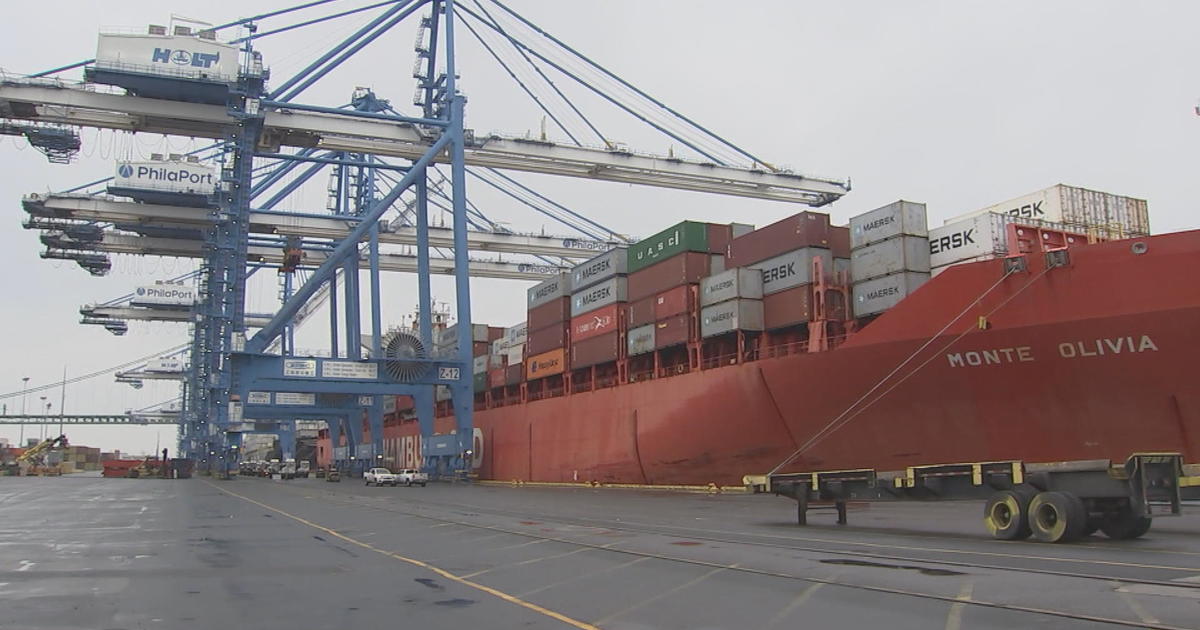
PhilaPort preparing for more cargo in wake of Francis Scott Key bridge collapse in Baltimore

Philadelphia area ports, trucking companies to see more volume after Baltimore bridge collapse
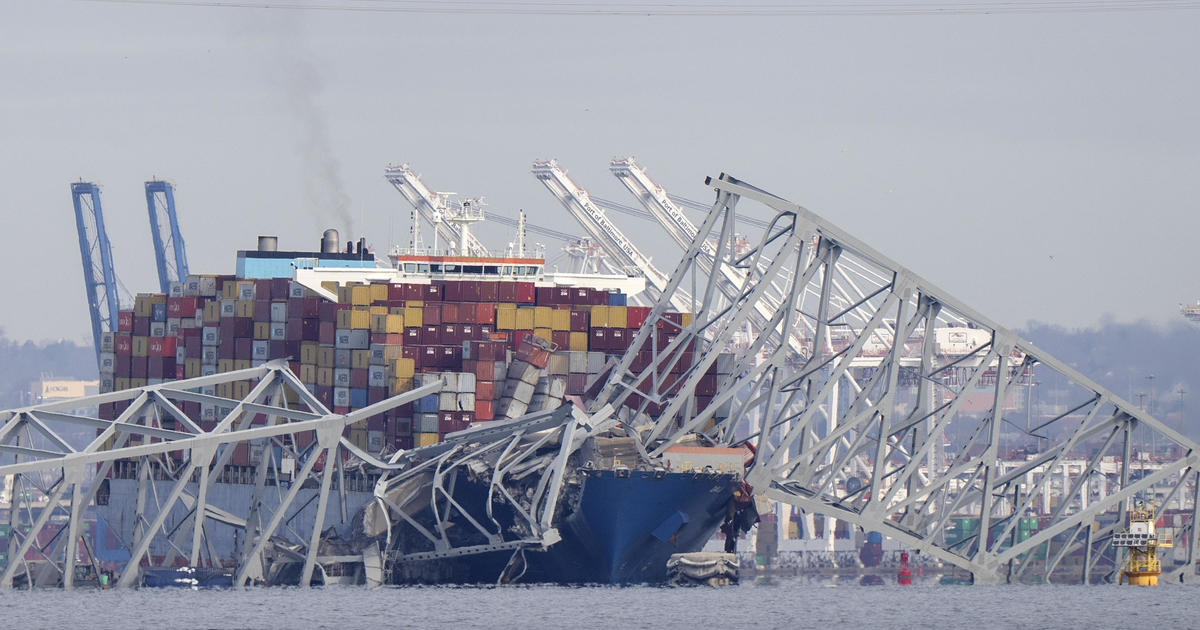
Next few weeks will be challenging for supply chains after Baltimore bridge collapse, professor says
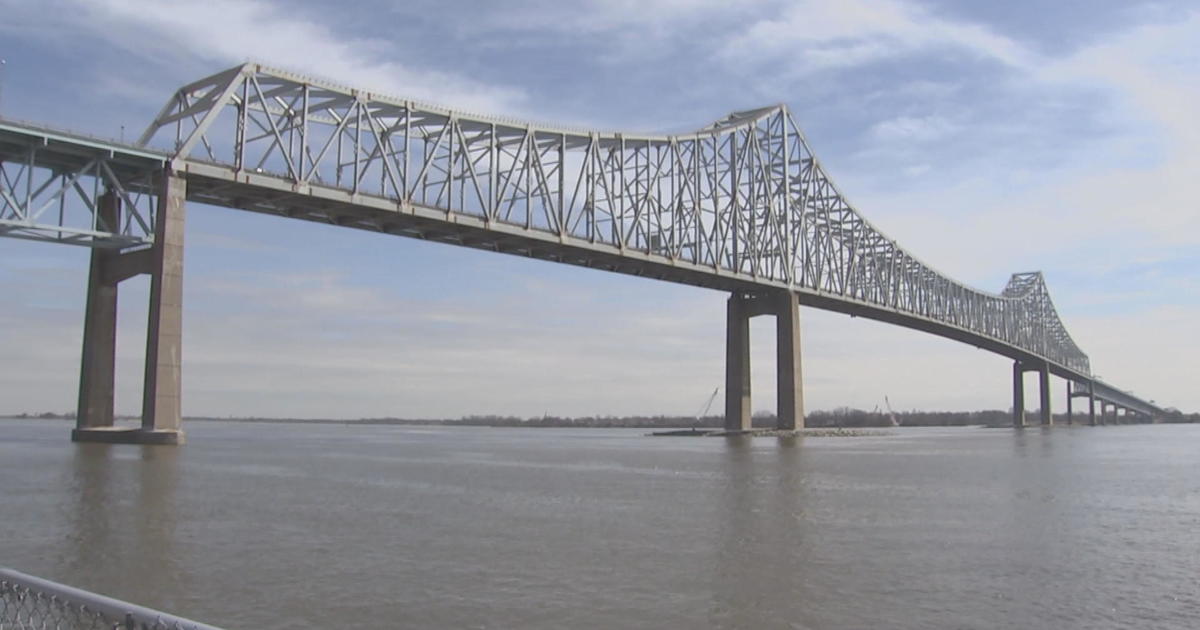
Are the Delaware River Port Authority bridges protected to prevent collapse similar to Baltimore's?
- International

Israel-Hamas war

Baltimore Key Bridge collapse
March 27, 2024 - Baltimore Key Bridge collapse
By Kathleen Magramo , Antoinette Radford, Alisha Ebrahimji , Maureen Chowdhury , Elise Hammond , Tori B. Powell and Aditi Sangal , CNN
Our live coverage of the Baltimore bridge collapse has moved here .
Here's what you should know about the Key Bridge collapse
From CNN staff

Officials recovered the bodies of two construction workers who were on Baltimore's Francis Scott Key Bridge when it collapsed early Tuesday morning after a 984-foot-long cargo ship collided into a pillar.
Maryland Gov. Wes Moore called the collapse Wednesday " a global crisis ."
"The national economy and the world's economy depends on the Port of Baltimore. The port handles more cars and more farm equipment than any other port in the country," Moore said.
Here's what you should know:
- The victims: The six people who are presumed dead were from Mexico Guatemala, El Salvador and Honduras, according to Col. Roland L. Butler Jr, the superintendent of Maryland State Police. Two bodies were recovered and have been identified as Alejandro Hernandez Fuentes from Mexico and Dorlian Ronial Castillo Cabrera from Guatemala. The two workers were filling potholes on the bridge and were later found trapped in a red pickup truck in about 25 feet of water, Butler said. The FBI is handling notifying the victims' families, Butler said.
- Recovery efforts: Authorities are pausing search efforts for the four other workers who are presumed dead, because additional vehicles are encased in concrete and other debris, making it unsafe for divers, Butler said. Once salvage operations clear the debris, divers will search for more remains, he said.
- The investigation: The National Transportation Safety Board is leading the investigation into the fatal incident, according to the agency's chair Jennifer Homendy. During a Wednesday news conference, Homendy said there were 21 crew members and two pilots on board the Dali cargo ship when it crashed into the bridge. She also said a senior NTSB hazmat investigator identified 56 containers of hazardous material, and that some containers are in the water. The agency received six hours of voyage data from the ship and the investigation could take 12 to 24 months to complete, Homendy said. She emphasized that NTSB will not analyze information collected or provide conclusions while on scene of the collapse.
- Looking forward: Department of Transportation Secretary Pete Buttigieg said rebuilding the bridge will not be "quick or easy" but that it will get done. He said there are four main focus points ahead: reopening the port, dealing with supply chain issues until its reopening, rebuilding the bridge and dealing with traffic issues until the bridge is rebuilt. Biden pledged the full support of the federal government in the response and recovery efforts. His administration has already conveyed a sense of urgency to open up federal funding to remove debris and ultimately rebuild the bridge. Maryland has submitted a request to the Biden administration for emergency relief funds "to assist in our work going forward," Moore said Wednesday.
It's almost impossible to place people on the bow of ship due to the unstable structure, fire official says
From CNN's Sarah Engel
Baltimore City Fire Chief James Wallace said Wednesday that the cargo ship's bridge structure and containers at the bow remain unstable.
"It's going to be very difficult, if not impossible, and very dangerous, to place people on the bow of that boat right now," Wallace told CNN's Kaitlan Collins.
"Naturally, we're still very cognizant of the fact that there are hazardous materials on board the vessel itself," Wallace said, alluding to the National Transportation Safety Board saying earlier that 56 containers were carrying hazardous materials.
Wallace said his team is relying heavily on aerial recognizance, including drones. "That's the only way we're able to see in," he said.
He added that the aerial surveillance has "been able to really assure us right now we have no [chemical] reactions on board."
"It's just utter devastation," NTSB chief says of the bridge collapse site
From CNN's Aditi Sangal
Jennifer Homendy, chair of the National Transportation Safety Board, called the site of the Key Bridge collapse "devastating."
"It's pretty devastating, certainly, seeing not just what's going on with the cargo containers, but just looking at what was a bridge span — three bridge spans that is pretty much gone. It's just utter devastation," she said at Wednesday evening's news briefing.
She added that she is thinking of families who lost loved ones and those who are waiting to reunite with their lived ones.
NTSB interviewed the Dali's captain and some other crew members today, agency chief says
The National Transportation Safety Board has interviewed the ship's captain, his mate, the chief engineer and one other engineer today, according to Chair Jennifer Homendy.
The two pilots on board the Dali at the time of collision will be interviewed tomorrow, she added.
Cargo ship's voyage data recorder is basic when compared to an airplane's, NTSB chair says
From CNN's Tori B. Powell
The voyage data recorder on the cargo ship Dali was a "newer model" but is considered basic when compared to that on an airplane, according to National Transportation Safety Board Chair Jennifer Homendy.
"But it is very basic compared to say, a flight data recorder, where we would have 1,000 parameters," she said at a news conference on Wednesday.
The NTSB chief investigator Marcel Muise added:
"It's not a ship-wide system recorder, so most of the sensors that are being recorded are from the bridge. So things like GPS, the audio, rudder feedback, rudder commands are recorded on there. But not engineering, the temperature of each cylinder, power distribution sensors."
There were no tug boats with Dali at the time of the collision. That's normal, NTSB chief says

There were no tugs with Dali when the cargo vessel collided with Baltimore's Key Bridge, which is normal protocol, according to National Transportation Safety Board Chair Jennifer Homendy.
Remember: At 01:26:39 on Tuesday, Dali's pilot made a general very high frequency (VHF) radio call for tugs in the vicinity to assist, the NTSB investigator Marcel Muise had said.
"The tugs help the vessel leave the dock, leave the port and get into the main ship channel. And then they leave. Once it's on its way, it's a straight shot through the channel. So there are no tugs with the vessel at the time. So they were calling for tugs," she said.
NTSB chair says she saw some containers that were carrying hazardous materials in the water
National Transportation Safety Board Chair Jennifer Homendy said she did see some of the 56 containers that were carrying hazardous materials in the water.
When asked how many
When asked how many containers of hazardous materials were in the water, Homendy said:
"I did see some containers in the water, and some breached significantly on the vessel itself," she said. "I don't have an exact number, but it's something that we can provide in an update."
Homendy said that a preliminary report should be out in two to four weeks.
This post has been updated with more quotes from Homendy.
Bridge did not have any redundancy, unlike the preferred method for building bridges today, NTSB chair says
Baltimore's Key Bridge did not have any redundancy, which is included in the preferred method of building bridges in the present day, according to National Transportation Safety Board Chair Jennifer Homendy.
"The bridge is a fracture critical," she explained. "What that means is if a member fails that would likely cause a portion of, or the entire bridge, to collapse, there's no redundancy. The preferred method for building bridges today is that there is redundancy built in, whether that's transmitting loads to another member or some sort of structural redundancy. This bridge did not have redundancy," Homendy said.
There are 17,468 fracture critical bridges in the United States out of 615,000 bridges total, she said, citing the Federal Highway Administration.
Please enable JavaScript for a better experience.
Parts of a Yacht Deck: A Comprehensive Guide
by Emma Sullivan | Aug 12, 2023 | Sailing Adventures

Short answer: Parts of a yacht deck:
The main parts of a yacht deck include the bow, stern, port and starboard sides, cockpit, foredeck, afterdeck, and swim platform. Other components may include safety railings, cleats for securing lines, hatches for access to lower compartments, and anchor wells.
Understanding the Essential Parts of a Yacht Deck: A Comprehensive Guide
When it comes to yachts, one of the most important areas to acquaint yourself with is the deck. The deck serves as the foundation for your maritime adventures and plays a crucial role in ensuring smooth sailing . In this comprehensive guide, we will provide you with an in-depth understanding of the essential parts that make up a yacht deck, equipping you with valuable knowledge for your voyages.
1. Foredeck: The foredeck represents the forwardmost part of the yacht ‘s deck. This area is typically spacious and flat, allowing for various activities such as sunbathing or hosting social gatherings. It provides easy access to the anchor and anchor windlass system , enabling smooth anchoring operations.
2. Cockpit: Moving towards the center of the yacht deck , you’ll find the cockpit—a well-designed area where navigation is carried out. Equipped with multiple instruments and controls, this section allows sailors to keep a close eye on their course and monitor various systems onboard. The cockpit also serves as a gathering spot for all passengers during navigation or when enjoying outdoor meals.
3. Helm Station: Situated within the cockpit is the helm station—often considered as the nerve center of any yacht. This is where skilled captains steer and navigate through different water conditions using a combination of traditional wheel control or modern joystick advancements found in technologically advanced vessels. The helm station embodies both power and precision required for safe maneuvering on open waters .
4. Flybridge: For those seeking sweeping views while relaxing or controlling their vessel , look no further than the flybridge located atop many larger yachts’ decks—accessible via stairs from either side near the cockpit area. The flybridge offers an elevated vantage point from which to soak in panoramic vistas and direct overall navigation activities confidently.
5. Swim Platform: Yacht decks are not limited solely to above-water areas; they often feature swim platforms extending from the stern. These platforms provide easy and safe access to the water for swimming, snorkeling, or enjoying watersports activities. With built-in ladders or steps, these platforms enhance the overall experience of your yacht adventure.
6. Aft Deck: Situated at the back of the yacht, the aft deck is an expansive space that connects the interior and exterior areas seamlessly. It is often used for dining al fresco, lounging, or entertaining guests. This area also serves as a gateway to other sections such as crew quarters, ensuring smooth operations on board.
7. Side Decks: Connecting various parts of the yacht deck are side decks—narrow walkways found on both port (left) and starboard (right) sides of the vessel. These corridors allow crew members and guests to move safely from one area to another without interfering with ongoing activities on deck.
Understanding these essential parts of a yacht deck empowers you not only to appreciate their functionality but also ensures that you make informed decisions while onboard. Whether you’re planning a leisurely cruise or embarking on an exciting charter experience, having a comprehensive understanding of your yacht’s deck will undoubtedly enhance your enjoyment and safety during each voyage.
So next time you step aboard a luxurious vessel and step onto its impressive deck, take a moment to appreciate each part’s purpose — knowing that behind every exquisite detail lies function and finesse working in harmony to create unforgettable seafaring experiences
How to Identify and Maintain the Various Components of a Yacht Deck
Owning a yacht is a dream for many, and ensuring its components are properly identified and maintained is crucial not only for optimal performance but also for maintaining its value. The deck of a yacht plays an integral role in its functionality and aesthetic appeal. Therefore, it’s essential to have a comprehensive understanding of the various components that make up the deck and how to maintain them.
1. Teak Decking: Elegant and Timeless One of the most iconic features on a yacht deck is teak decking. Renowned for its elegance, durability, and natural non-slip properties, teak decking requires regular maintenance to keep it looking pristine. Begin by cleaning the teak with fresh water to remove any salt or debris accumulated during your voyages. To maintain its golden luster, periodic scrubbing using mild soap or specialized teak cleaners is recommended. After scrubbing, rinse thoroughly to ensure no residue remains on the surface.
Additionally, consider applying protective coatings such as teak oils or sealants to safeguard against UV damage and prevent discoloration caused by exposure to sunlight over time. This will help retain the luxurious appearance of your teak decking while prolonging its lifespan.
2. Stainless Steel Hardware: Slick and Resilient Stainless steel hardware gives yacht decks a sleek look while offering exceptional strength and corrosion resistance. While stainless steel is highly durable, regular maintenance ensures it remains pristine for years to come.
Begin by inspecting all stainless steel fittings such as hinges, cleats, handrails, and stanchions for signs of rust or corrosion regularly. If any issues arise, promptly address them by removing the affected hardware and using rust removers or specialized stainless steel cleaners to restore their original shine.
To prevent future corrosion, apply protective coatings such as metal polishes or waxes specifically designed for stainless steel surfaces. These coatings create an invisible barrier that repels moisture while preserving the metal’s sleek appearance.
3. Non-Slip Surfaces: Safety First Safety should always be a top priority on a yacht deck , and non-slip surfaces play a vital role in preventing accidents. These anti-skid surfaces are often made of materials like rubber or textured paint. Keeping them well-maintained ensures optimal grip and performance .
Regularly inspect these areas for signs of wear or damage, as they can deteriorate over time due to constant foot traffic and exposure to harsh marine conditions. If you notice any uneven or worn spots, promptly address them by repainting or replacing the affected areas.
Remember to clean these surfaces regularly using mild soap or specialized non-slip cleaners. Avoid using abrasive cleaners that may degrade the texture and reduce their gripping capabilities.
4. Fiberglass Decking: Lightweight and Versatile Fiberglass decking has gained popularity in recent years due to its lightweight nature and versatility in design options. Maintaining fiberglass decks requires regular cleaning, polishing, and careful inspection for cracks or structural damages.
To clean fiberglass surfaces, use gentle soaps or purpose-made fiberglass cleaners along with soft brushes or sponges to avoid scratching the gel coat finish. Regular waxing with specialized marine wax helps protect the surface from UV damage while providing a glossy appearance that enhances the overall aesthetics.
Inspect the entire surface carefully, paying particular attention to stress points such as corners and edges where cracks may develop over time. Promptly repair any damages found using appropriate techniques such as epoxy resin application or seeking professional assistance when necessary.
Embrace the Pride of Ownership through Proper Maintenance Owning a yacht brings immense joy and satisfaction but also responsibility towards its care and maintenance. By understanding the various components of your yacht’s deck and implementing regular maintenance routines tailored to each specific material type, you’ll not only ensure its longevity but also enhance its visual appeal while cruising effortlessly across sparkling waters. Remember, investing time into maintaining your yacht’s deck is an investment in both its future and your pride of ownership.
Exploring the Step-by-Step Breakdown of Different Parts on a Yacht Deck
Title: Unveiling the Intricacies of a Yacht Deck: A Comprehensive Guide
Introduction: When it comes to luxury and style, few things can compare to a yacht. From cruising along crystal-clear waters to indulging in the sun-soaked ambiance, every moment spent on a yacht is an experience like no other. But have you ever wondered what lies beneath your feet as you embark on this lavish adventure ? Join us as we unravel the step-by-step breakdown of different parts on a yacht deck, giving you insights into the inner workings of these remarkable vessels.
1. The Bow: Let’s start our journey at the front of the yacht, known as the bow. This majestic area is where elegance and functionality intersect seamlessly. Extending forward from the vessel’s main structure, it provides ample space for sunbathing or simply relishing breathtaking views as you cut through the waves. In addition to its aesthetic appeal, the bow also serves practical purposes such as housing anchor controls and storage compartments.
2. The Foredeck: Leaving the bow behind, we move towards another essential part: the foredeck. This expansive area plays multiple roles – be it accommodating water toys or serving as a helipad for those seeking grandeur from above. With reinforced structural integrity and strategically placed fittings, this part ensures utmost safety while maximizing pleasure during outdoor activities.
3. Main Deck: As we venture further aft on our deck exploration, we reach perhaps one of the most prominent sections – the main deck. Spanning considerable length and breadth, it provides an extensive canvas for dining areas with luxurious seating arrangements, alfresco lounges adorned with plush cushions, and even infinity pools that seamlessly merge with stunning seascapes.
4. Companionways: Moving below decks but not forgetting their significance in our breakdown are companionways – staircases connecting various levels of a yacht. Designed thoughtfully to optimize accessibility without compromising aesthetics, these passageways exude opulence through the use of exquisite materials such as polished wood or gleaming metal, creating a sense of timeless elegance.
5. Upper Deck: Now let’s ascend to a higher level – the upper deck. Often associated with panoramic vistas and sophisticated entertainment options, this space offers an elevated experience for socializing and relaxation. From fully-equipped bars where mixologists craft delectable cocktails to outdoor cinemas that transform starlit nights into unforgettable movie experiences, the upper deck epitomizes refined opulence.
6. Sun Decks: Prepare to be dazzled as we explore the sun decks – premier spots on yachts customized for ultimate leisure and pleasure. Featuring everything from jacuzzis, tanning beds, and luxurious loungers to fully equipped outdoor gyms, these decks are meticulously designed to cater to guests seeking both tranquility and exhilaration under the generous embrace of the sun.
Conclusion: As our journey comes to an end, we hope you now have a deeper understanding of the various parts that make up a yacht deck. From the bow that sets sail towards endless horizons, through companionways connecting spaces with eloquence, all the way up to sun-drenched decks enticing you into moments of pure bliss – each element harmoniously blends functionality with unparalleled luxury. So next time you step foot on a yacht deck, take a moment to appreciate not only its beauty but also the intricate craftsmanship that goes into creating these floating marvels where dreams forever find solace.
Frequently Asked Questions: All You Need to Know About Parts of a Yacht Deck
Welcome to our Frequently Asked Questions section, where we aim to provide you with all the information you need to know about the various parts of a yacht deck. Whether you’re a seasoned sailor or just starting your adventure on the open seas, understanding the components of a yacht deck is crucial for your safety and enjoyment. So, let’s dive in!
1. Bow: Starting at the front of the yacht, the bow is the pointed part that cuts through water . It’s important to familiarize yourself with this area as it plays a role in anchoring and docking maneuvers.
2. Cockpit: Moving towards the middle of the vessel, we encounter the cockpit – often referred to as the heart of any yacht. This is where navigation controls are located, allowing you to steer and control your vessel efficiently.
3. Helm Station: Located within the cockpit, the helm station houses all essential instruments for steering and navigating your yacht safely . From steering wheels or joysticks to electronic displays providing vital information such as speed and depth measurements – this area ensures smooth sailing .
4. Deck Hatches: These are openings on your yacht’s deck that allow access below decks while also providing ventilation and natural lighting for cabins and other interior spaces. Be cautious when opening and closing hatches to avoid any accidents.
5. Stanchions and Lifelines: Safety should always be a top priority at sea, which is why stanchions (upright posts) with accompanying lifelines are installed around most yacht decks . These prevent accidental falls overboard , acting as a physical barrier between you and potential danger.
6. Cleats: These metal fittings are found along both sides of a yacht’s deck used for securing lines and ropes during docking or anchoring procedures. They play an essential role in keeping your vessel in place when necessary.
7. Toe Rail: Running along both sides of a yacht’s deck edge, toe rails serve multiple purposes – acting as footholds for crew members, providing additional security during maneuvers, and also preventing water from spilling onto the deck.
8. Windlass: Located at the front of your yacht near the bow, a windlass is a mechanical device used to control anchor deployment and retrieval. It makes anchoring your vessel much easier and more efficient.
9. Scuppers: Found at various points on the deck, scuppers are small drainage holes that prevent water from accumulating on the deck surface. It’s important to keep these clear to ensure proper water drainage during rough weather conditions.
10. Bimini Top: For those seeking shelter from the sun or light rain showers while on their yacht, a bimini top provides excellent protection. These fabric canopies extend over part of the cockpit or helm station area and can be folded away when not needed.
Knowing these essential parts of a yacht deck will enhance your overall sailing experience while keeping you safe onboard. We hope this comprehensive overview has provided you with valuable insights into each component’s purpose and functionality. So why wait? Set sail, explore new horizons, and enjoy your time on the open seas !
Navigating the World of Yacht Decks: Unraveling Common Queries about Different Parts
Welcome aboard the vibrant world of yacht decks! As you embark on this exhilarating journey, it’s important to navigate through the vast array of options and understand the intricacies of different parts . In this blog post, we will unravel common queries and provide detailed explanations about various components that make up a yacht deck.
1. Teak Decking: The Jewel in Yachting’s Crown Teak decking is often considered the epitome of luxury and elegance in the yachting industry. Crafted from durable teak wood, it dazzles with its warm honey-brown hue and exquisite grain patterns. Renowned for its unique non-slip properties, teak decking ensures safety while exuding timeless beauty.
2. Synthetic Teak: Embracing Innovation without Sacrificing Beauty In recent years, synthetic teak has emerged as a popular alternative to traditional teak decking. Made from high-quality PVC materials, synthetic teak mimics the appearance of real teak flawlessly while providing superior resistance to wear and weather conditions . Its low maintenance requirements and customizable design options have garnered attention among modern yacht enthusiasts.
3. Cork Decking: Nature’s Silent Co-star Cork decking offers a delightful blend of eco-friendliness and aesthetic appeal. Sourced from sustainable cork oak trees, cork decks provide excellent insulation properties while reducing noise levels aboard your yacht. With its distinct visual texture and tactile sensation underfoot, cork decking adds a touch of sophistication to any vessel.
4. EVA Foam Flooring: Comfort Meets Style If ultimate comfort is what you seek, look no further than EVA foam flooring for your yacht deck. Known for its cushioning effect, this closed-cell foam not only provides exceptional shock absorption but also reduces fatigue during long hours at sea. Available in an extensive range of colors and patterns, EVA foam allows for creative customization without compromising on durability.
5. Safety at Sea: Non-Slip Decking Solutions A primary concern for every yacht owner is the safety of all onboard. Fortunately, various non-slip decking solutions are available to address this issue. From specialized grip paint to innovative anti-slip tapes, these options ensure secure footing even in harsh weather conditions, granting peace of mind to both seasoned sailors and first-time yacht enthusiasts.
6. Maintenance Tips: Preserving the Splendor To keep your yacht deck looking pristine, regular maintenance is crucial. Regardless of the material you choose, routine cleaning and proper upkeep will protect its longevity. It’s recommended to use gentle, non-abrasive cleansers specifically designed for marine applications. Additionally, investing in protective covers or mats when necessary can prevent unnecessary wear and tear over time.
7. Beyond Yacht Decks: Exploring Additional Outdoor Spaces While the focus has been on yacht decks thus far, it’s important not to overlook other outdoor spaces onboard that contribute to an enhanced yachting experience . From stylish balconies and luxurious sunbathing areas to stunning swimming pools and expansive helipads, these additional spaces further elevate the overall opulence and functionality of a yacht.
So there you have it – a comprehensive guide through the thrilling world of yacht decks! Armed with knowledge about different parts and their unique features, you can make informed decisions when customizing your dream vessel’s deck. May your yachting adventures be filled with endless beauty, comfort, and safety as you traverse the vast seas with style!
Mastering the Anatomy of a Yacht’s Exterior: Exploring Key Features on the Deck
When it comes to yachting, understanding the intricate details of a yacht’s exterior is key to fully appreciating its luxury and functionality. While there are numerous elements that contribute to the overall design and performance of a yacht, in this article we will focus on exploring the key features found on the deck – arguably one of the most important areas where both aesthetics and practicality collide.
Firstly, let’s talk about one of the most prominent features: the bow. As a focal point that captivates attention both at sea and in port, the bow sets the tone for the entire vessel. From sleek and minimalist designs to more extravagant embellishments, yacht bows can vary greatly depending on personal preference and style. It’s not uncommon to find comfortable seating or spacious sunpads at this prime location—perfect for enjoying breathtaking views while cruising through azure waters.
Moving towards the aft section of a yacht’s deck, you’ll discover another crucial component known as the cockpit. This well-designed area serves as a central hub for outdoor activities, socializing, and entertainment. Equipped with comfortable seating arrangements, dining tables, wet bars, and even jacuzzis on larger yachts—a lively atmosphere can be created to suit any occasion.
Continuing our exploration along the deck side rails, we encounter cleverly incorporated storage spaces where various water toys such as jet skis or paddleboards can be securely stowed away. These compartments not only maintain a clean and organized appearance but also provide easy access for quick deployment when desired aquatic adventures beckon.
One cannot overlook another vital feature found throughout a yacht’s exterior: handrails. Not only do they serve as safety devices aiding in movement around the vessel but they are also meticulously designed to seamlessly blend with the overall aesthetic. Manufactured using high-quality materials like stainless steel or polished teakwood, these handrails embody elegance without compromising functionality—an essential aspect of any well-mastered yacht design.
As we venture further aft, the stern of a yacht reveals the laudable effort invested in engineering and innovation. The swim platform—a modern-day luxury on many yachts—extends beyond traditional hull design, creating an inviting space for water enthusiasts to easily access and relish in aquatic activities. Whether it’s swimming, snorkeling or simply diving into crystal-clear seas, this platform enhances the overall experience of being at sea.
Lastly, no discussion on a yacht’s exterior would be complete without mentioning its navigational equipment. From sleek radar domes to state-of-the-art GPS systems and satellite communication devices, these technological marvels ensure a safe voyage while seamlessly integrating with the yacht ‘s exterior design. Manufacturers strive to strike a balance between functional efficiency and aesthetic appeal so that these vital components never disrupt the beauty of the vessel.
In conclusion, understanding the anatomy of a yacht’s exterior is an art form that commands meticulous attention to detail. From bow to stern, every element serves both practical purposes as well as adding to the overall allure and sophistication of these floating masterpieces. So next time you find yourself aboard a yacht, take a moment to appreciate the craftmanship and clever engineering that lies beneath its stunning exterior—and let it transport you into a world where luxury meets adventure on every deck.
Recent Posts

- Sailboat Gear and Equipment
- Sailboat Lifestyle
- Sailboat Maintenance
- Sailboat Racing
- Sailboat Tips and Tricks
- Sailboat Types
- Sailing Adventures
- Sailing Destinations
- Sailing Safety
- Sailing Techniques
Advertisement
Vessels Belonging to Owner of Baltimore Ship Had Been Cited for Labor Violations
The vessels had underpaid crews and kept workers onboard for months beyond their contracts, according to an Australian regulator.
- Share full article

By Michael Forsythe , Peter Eavis and Jenny Gross
- March 26, 2024
Ships belonging to the company whose container vessel crashed into the Francis Scott Key Bridge in Baltimore on Tuesday have been cited in recent years for labor violations, which include underpaying ship crews and holding crew members onboard for months past their contracts, according to the Australian Maritime Safety Authority.
In 2021, the authority detained the Western Callao, another ship formerly owned by the company, the Singapore-based Grace Ocean Private Ltd., after it found that the management was in arrears paying 13 crew members and had kept them on the ship for more than 12 months, well beyond their nine-month contracts. In 2020, an inspection of the same ship in Australia found that eight sailors had been aboard it for more than 11 months.
Another ship owned by Grace Ocean, the Furness Southern Cross, had 10 seafarers aboard for more than 14 months. The infractions were “serious and shameful” violations of an international convention on maritime labor, Michael Drake, the executive director of operations for the authority, said at the time, in October 2021.
“This type of behavior is unethical and in complete contravention to the Maritime Labor Convention,” Mr. Drake said. “The international conventions that protect seafarers’ rights are very clear.”
Any factors about the crew of the Dali, the Grace-owned container ship that crashed into the Key Bridge, including fatigue, will likely be among the many items the National Transportation Safety Board examines as it looks for the cause or causes of the crash.
Grace Ocean owns 55 ships, according to Equasis , a public database of ship information. While global companies such as Maersk charter the vessels, the owners and the ship managers are generally responsible for managing the crew and maintaining the ships. The management company for the Dali, Synergy Marine, was not the company managing the two vessels cited by Australia.
The extremely opaque nature of global ship-owning makes finding the ultimate owners and holding them accountable for any violations difficult. According to Singapore company records, Grace Ocean is owned by the British Virgin Islands-based Grace Ocean Investment Limited. Lloyds List, which first reported Grace Ocean’s infractions in 2021, reported that Grace Ocean Investment is based in Hong Kong. But the company matching the name and address in Lloyd’s database dissolved in 2015, according to Hong Kong company records.
The Singapore company has four directors — two Filipino citizens, a Singaporean and a Japanese person — with all listing addresses in Singapore, records show.
Alexandra Wrage, the president and founder of Trace, a group focused on anti-bribery, compliance and good governance, said that ship ownership structures were designed to maximize opacity and minimize accountability.
“There are some good actors in this space, but shipping is the Wild West from a compliance and accountability perspective,” Ms. Wrage said. “And when compliance and accountability aren’t priorities, issues like environmental standards, labor practices and health and safety often aren’t either.”
The Dali had 22 crew members from India onboard, according to a statement from Grace Ocean and Synergy Marine. None were injured.
An inspection of the Dali last year at a port in Chile found that the vessel had a deficiency related to “propulsion and auxiliary machinery.” The inspection, conducted on June 27 at the port of San Antonio, specified that the problem concerned gauges and thermometers.
The Dali has had 27 inspections since 2015, according to Equasis. The only other deficiency, a damaged hull “impairing seaworthiness,” was found in 2016, at the port of Antwerp, in Belgium. The vessel hit a berth at the port that year. A spokesman representing Grace Ocean and Synergy did not immediately have a comment on the labor violations or on the deficiency reported last year.
Michael Forsythe a reporter on the investigations team at The Times, based in New York. He has written extensively about, and from, China. More about Michael Forsythe
Peter Eavis reports on business, financial markets, the economy and companies across different sectors. More about Peter Eavis
Jenny Gross is a reporter for The Times in London covering breaking news and other topics. More about Jenny Gross
- Election 2024
- Entertainment
- Newsletters
- Photography
- Personal Finance
- AP Buyline Personal Finance
- Press Releases
- Israel-Hamas War
- Russia-Ukraine War
- Global elections
- Asia Pacific
- Latin America
- Middle East
- March Madness
- AP Top 25 Poll
- Movie reviews
- Book reviews
- Personal finance
- Financial Markets
- Business Highlights
- Financial wellness
- Artificial Intelligence
- Social Media
Beyoncé’s ‘Cowboy Carter’
Oxford coach blasts Thames pollution as a national disgrace ahead of Boat Race with Cambridge
The Cambridge Men’s team during a training session on the River Thames in Putney, London, Wednesday March 27, 2024. Jumping into London’s River Thames has been the customary celebration for members of the winning crew in the annual Boat Race between storied English universities Oxford and Cambridge. Now researchers say it comes with a health warning. (Zac Goodwin/PA via AP)
FILE - Members of the Oxford University rowing team throw their cox Nicholas Brodie, centre, into the river after beating Cambridge University, at the 154th annual Boat Race on the River Thames, London, Saturday, March 29, 2008. Jumping into London’s River Thames has been the customary celebration for members of the winning crew in the annual Boat Race between storied English universities Oxford and Cambridge. Now researchers say it comes with a health warning. (AP Photo/Lefteris Pitarakis, File)
The Cambridge men’s team pass under Hammersmith Bridge during a training session on the River Thames in London, Tuesday March 26, 2024. Jumping into London’s River Thames has been the customary celebration for members of the winning crew in the annual Boat Race between storied English universities Oxford and Cambridge. Now researchers say it comes with a health warning.(John Walton/PA via AP)
FILE - The Oxford crew, right, throw their cox Colin Groshong into the Thames at the 155th Boat Race, in London, Sunday March 29, 2009. Jumping into London’s River Thames has been the customary celebration for members of the winning crew in the annual Boat Race between storied English universities Oxford and Cambridge. Now researchers say it comes with a health warning. (AP Photo/Tom Hevezi, File)
- Copy Link copied
LONDON (AP) — The coach of Oxford’s crew taking part in the Boat Race described the pollution in London’s River Thames as a “national disgrace.”
Testing by a campaign group has found high levels of E.coli along a section of the Thames in southwest London that will be used for the historic race on Saturday.
Crew members have been warned about the risks of entering the water and advised to use a “cleansing station” at the finish area. The pollution has also cast doubt on the post-race tradition of throwing the winning cox into the water.
The company responsible for the upkeep of the Thames faces mounting financial difficulties that critics say should force the company to return to state hands.
Figures released by the Environment Agency showed the level of sewage spills into England’s rivers and seas by water companies more than doubled in 2023 compared to 2022, reaching 3.6 million hours of spills in 2023 compared to 1.75 million hours in 2022.
There has been no suggestion that the annual Boat Race between storied universities Oxford and Cambridge that dates to 1829 will not go ahead. The women’s race will precede the men’s event along the same 4.2-mile (6.8-kilometer) section of the Thames.
But Oxford coach Sean Bowden lamented the state of the water.
“It’s a national disgrace, isn’t it?” Bowden posed. “It would be terrific if the Boat Race drew attention to it. We are very keen to play a part and we recognize we have a role and a responsibility to it.
“Why,” he added in British newspaper The Daily Telegraph, “would you want to put your kids out in that?”
Invariably, the focus has turned to whether the winning crew will dunk its cox into the Thames at the end of the race.
“If there’s a health and safety problem, I don’t think we’ll be throwing him in because we don’t want to risk that,” said Harry Glenister, who has rowed for Britain and will compete for Oxford.
“It’s just too much of a risk. We support whatever the Boat Race is saying about the conditions in the water. We just hope we’ll win and then we’ll decide.”
Cambridge has won four of the last five men’s races and leads the rivalry 86-81.
Cambridge has also won six straight in the women’s race.
E.coli bacteria normally live in the intestines of healthy people and animals. Most strains are harmless, cause relatively brief diarrhea and most people recover without much incident, according to the Mayo clinic . But small doses of some strains — including just a mouthful of contaminated water — can cause a range of conditions, including urinary tract infection, cystitis, intestinal infection and vomiting, with the worst cases leading to life-threatening blood poisoning.
River Action, a campaign group, said the testing locations suggested the source of pollution was from utility company Thames Water discharging sewage directly into the river and its tributaries.
Thames Water, Britain’s largest water company, is facing huge pressure to clear up the river, though it insists that the elevated levels of E.coli are not necessarily its fault.
“I would point out that E.coli has many different sources,” the company’s recently appointed chief executive Chris Weston told the BBC.
“It is not just from sewage, it is also from land run-off, it is from highway run-off, it is from animal feces. All of those things contribute to the problem and I am absolutely determined that, at Thames, we will play our part in cleaning up the problem and so the Thames is a river that people can use as they would like to everyday.”
Under a plan drawn up last summer, Thames Water was asking investors to inject close to 4 billion pounds ($5.05 billion) into the business over the next five years. However, on Thursday shareholders refused to make the first payment of 500 million pounds ($630 million) without a big increase in consumers’ water bills, a demand that the industry regulator denied.
Weston insisted it was “business as usual” at the debt-laden company as it has enough financial resources to survive into next year, by which time he hoped a new funding arrangement will have been agreed. However, the news has raised speculation that the company may have to be nationalized.
The parlous state of many of Britain’s rivers, canals and coastlines is set to feature heavily in the general election, which is expected in the next few months. The main opposition Labour Party, which is way ahead of the governing Conservatives in opinion polls, has said it will make sure “new investment comes through to fix the broken sewage system without taxpayers being left to foot the bill.”
AP sports: https://apnews.com/sports
At long last, a cruise ship designed for people who hate cruises
Maybe we should call it a ‘floatel.’ the ritz-carlton’s posh yacht is part of the first generation of hotel brands making the leap from land to sea..

GUSTAVIA, St. Barts — While admiring the sleek Ritz-Carlton Evrima sitting in Gustavia Harbor, I concluded that the vessel is a new category of cruising and should have a name that reflects as much
At its heart, the Evrima is more of a hotel or resort on water than a cruise ship, so maybe it should be called a floatel. How about a boatique hotel? Would you settle for a barge and breakfast? No matter what it’s called — the Ritz-Carlton refers to the ship as a yacht — spending a few days on the Evrima was an experience unlike any I’d previously had on a cruise ship.
Advertisement
Ritz-Carlton launched its entry into the world of cruising in 2022 after years of false starts and COVID-related delays. I read about its progress carefully because it seemed that while every other ship was getting bigger and more elaborate, Ritz-Carlton, owned by Marriott, was bucking the trend by making theirs smaller and more minimal. It’s also intent on calling its ships yachts. The definition of a yacht is fuzzy enough that the Ritz-Carlton can get away with it, but clearly, it’s about status. And if you’re paying $5,000 for a cruise (my Caribbean cruise was $5,300), telling your friends that you’re yachting seems appropriate.
During my Caribbean jaunt, there were a few times when I heard the crew slip and say “ship” before correcting themselves and saying “yacht.” I couldn’t help but chuckle. The staff of the Evrima did not know a travel writer was on board, and the Globe received no freebies or special treatment. I wanted to experience the Evrima like any other Jane Dough or Milburn Pennybags on the ship — I mean yacht.
No matter what it’s called, the Evrima is a wholly different species from other ships, beginning with the passenger count. It can hold 298 passengers (most small luxury ships carry between 700 to 2,000). My cruise was full, but the ship never felt crowded, and I often wondered if it was really sold out. I never had a problem finding a lounge chair at the pool or getting a table for dinner.

The most striking difference I found between Evrima and other ships was the onboard culture. There were no water slides, casinos, buffets, or Broadway shows. The Evrima is akin to a chic boutique hotel where you’d go to unwind without distractions. It’s designed for Ritz-Carlton loyalists, or folks who want to be in a posh hotel that happens to sail into different ports.
There’s a small infinity pool and hot tubs rather than a giant central swimming pool on the 624-foot yacht. There are even tucked-away areas on outside decks that you can seek out for a bit of privacy. Common areas, such as a main gathering called the Living Room, still felt intimate.
There are excursions off the ship, but when you’re on board, no cruise directors are dragging you to limbo contests or haranguing passengers over the PA about upcoming bingo games. It’s very much a place to escape rather than be pulled into the candy-colored machinations of a big cruise ship.
There’s a fair amount of chatter about the Evrima in online cruise forums, and the biggest complaints are from those who book expecting a full, traditional cruise experience. This will sound odd, but if you’re a regular cruiser who enjoys the flash and action of a ship, or you like your days jammed with nonstop activities planned by others, I’d say to steer clear of the Evrima. There are activities such as wine tastings, gourmet cooking challenges, and mixology classes, but no mini golf or pickleball.

What it lacks in conventional activities, it more than makes up for in an area called the Marina. When the yacht is anchored, the back deck on level three becomes a place to lay in the sun, jump into the water, snorkle, or kayak. It’s unlike any other cruise ship because you’re in relatively shallow water and you have full access to the ocean (depending on conditions). One day when the ship was in a lackluster port, I stayed onboard and hung out at the Marina. I went kayaking and snorkeling right off the back of the ship. It was the most yacht-like experience of the cruise.
I don’t mean to paint the environment on the Evrima as staid or anti-social. I was pulled into multiple birthday celebrations by complete strangers who became close friends by the end of the trip. Several of these celebrations lasted late into the night in the Observation Lounge, which was the venue on the 10th deck that stayed open past midnight. I suppose it didn’t hurt that the staff poured Moët & Chandon champagne like it was water. There’s no upcharge for alcohol (unless you have a taste for $2,500 spirits). There’s also no extra charges for internet or gratuities.

The Evrima is made up entirely of suites, all of them with balconies, that range in size from 300 square feet to 1,091 square feet. Most of the suites, aside from the entry-level Terrace suite, have bathtubs. These are cruise ship rooms that feel like hotel rooms, down to the king beds. Many of those who work in service on the ship come from the hotel world rather than other cruise ships, and their demeanor was just as friendly and professional.
Ritz-Carlton Evrima
- Small, easy-to-navigate ship
- Gourmet food
- Laidback, relaxing atmosphere
- Large suites with beautiful interiors
- Limited onboard activities
- Limited laundry facilities for guests
- Not ideal for families with small children
But people come on ships for the cuisine, and, as you may expect, the food on the Evrima is sophisticated. There are five restaurants (six if you count the bakery at the espresso bar), plus 24-hour room service. As a reporter, it was my duty to try them all. Even at the casual, all-day restaurant, the Pool House, you could get ceviche or a salmon poke bowl. They didn’t just serve burgers, there was a build-your-own-burger.
The Mediterranean-influenced restaurant Mistral offered options such as lobster linguine, several cuts of steak, and grilled octopus. Most passengers I chatted with spent the majority of their dining time at Mistral or Talaat Nam, the sushi restaurant. (I fell deeply in love with the mango sticky rice at Talaat Nam.) The all-purpose restaurant, called the Evrima Room, served breakfast and dinner. I mostly had breakfast here, and primarily for the orange juice, which was freshly squeezed.
The only restaurant on board with an extra charge is called S.E.A. It features a tasting menu and wine paring created by three-Michelin-star chef Sven Elverfeld. For an additional $289, I enjoyed eight courses (maybe it was nine, it got blurry with the wine). Most were petite portions packed with flavor, such as raw and marinated yellowfin tuna and Japanese wagyu. I felt as if I was eating art for a night.

On the last night of my Caribbean cruise, I decided to ask other passengers their take on the ship. Did they think they had gotten their money’s worth? I went to the Observation Lounge where all the evening’s revelry was taking place, but clearly I was too late for serious answers. Jane, one of the many birthday celebrants, had pulled everyone onto the dance floor. I tried asking: “Was it worth it?” The reply was a champagne-scented chorus of “You are the dancing queen, young and sweet, only 17.”
I took that as a yes.
Christopher Muther can be reached at [email protected] . Follow him @Chris_Muther and Instagram @chris_muther.

IMAGES
VIDEO
COMMENTS
Learn the difference between a yacht and a boat, and the features and terminology of a yacht. Find out the meanings of aft, anchor, beam, berth, bridge, cabin, cleat, deck, draft, galley, helm, hull, keel, knots, line, mooring, port, porthole, propellers, rig, starboard, stern, and more.
Learn the parts of a yacht, from stern to bow, hull to bridge, and more. Discover the materials, design, and features of different types of yachts and how to enjoy them with Ahoy Club.
Short answer parts of a yacht: The main parts of a yacht typically include the hull, deck, mast, boom, rigging, sails, keel or centerboard, rudder, and various onboard systems such as engine and plumbing. These components are essential for sailing and maneuvering a yacht on water. A Comprehensive Guide to Understanding the Different Parts of
The transom is the backplate of the boat's hull. It's the most aft (rear) part of the boat. Port. Port is the left side of a sailboat. Starboard. Starboard is the right side of a sailboat. Bilge. The bilges are the part where the bottom and the sides of the hull meet. On sailboats, these are typically very round, which helps with hydrodynamics.
Learn how the parts of a yacht work together to create the perfect maritime experience. Explore the intricate world of yacht components. Contact Us Today: 786-621-3010 / +1 844 262 8284 | Whatsapp 305-499-0036 | Email: [email protected]
Learn the fundamental terms and concepts of sailboat anatomy and sailing in ASA 101 Basic Keelboat Sailing. Find out the difference between keelboats and dinghies, the functions of keel, rudder, cockpit, and more.
It consists of several key components, including the engine, propellers, shafts, and rudders. Yachts may have either an inboard or outboard engine, with inboards being more common in larger vessels. The propellers, attached to the shafts, create the necessary thrust, while the rudders steer the yacht in the desired direction. 3.
The main parts of a sailboat. Hull - The main structure. Keel - The fin under the boat. Rudder - To steer the boat. Mast and Rigging - Supporting the sails. Boom - Supporting the mainsail. Sails - The canvas used to harness the energy of the wind. The starboard and port side of the boat. Windward and Leeward.
Short answer parts of aboat: A boat typically consists of several key parts. These include the hull, deck, cabin or cockpit, keel, rudder, and various mechanical components such as the engine, propeller, and steering system. Additional features may include masts, sails, winches, and navigation instruments. 1) Understanding the Basics: An Introduction to the Parts of
Short answer parts of the boat: The main parts of a boat include the hull (the bottom part that touches water), deck (top surface), bow (front end), stern (back end), and keel (the centerline running beneath). Other essential components are the rudder, propellers, mast or sail, and various navigation equipment. Understanding the Different Parts of
Learn the basic parts of a boat with this illustrated diagram and detailed description. Find out the terms and features of different types of boats, such as bow, stern, helm, flybridge, and more.
Bow - The bow is the front or forward part of the vessel. Bilge - The bilge is the lowest internal part of a boat's hull. Bulkhead - A bulkhead is a wall that divides compartments on a boat. Cabin - A cabin is an interior part of a boat that can be enclosed and is often used as a place to sleep while onboard a vessel.
The headstay is a crucial part of your boat's standing rigging system. It is the cable or rod that connects the top of the mast (the masthead) to the bow of the boat. The headstay helps maintain the mast's stability and provides a support structure for the jib. The tension in your headstay plays a significant role in the jib's sail shape.
Names of the other parts of the design of sailing yachts are shown at the picture below. On pic. 2 the internal rooms of the pitching yacht: The rig of a yacht. As we have already stated, the rig consists of the sails and controlling devices. The sails work as the main engine of a yacht. They are divided into three sets: basic, extra and storm ...
Learn what a yacht is and what each part of it is called and what it does. Discover the main components of a yacht, such as the hull, deck, keel, cabin, cockpit, and rigging, and how they contribute to the yachts design and performance.
The four basic parts of a boat are the hull , deck , engine, and sails (in sailboats). The hull is the main body of the boat, providing buoyancy and protection from water. The deck is the flat surface that covers the hull and supports the occupants and any equipment. The engine propels the boat, and the sails are used for harnessing wind energy ...
A basic sailboat is composed of at least 12 parts: the hull, the keel, the rudder, the mast, the mainsail, the boom, the kicking strap (boom vang), the topping lift, the jib, the spinnaker, the genoa, the backstay, and the forestay. Read all the way through for the definition of each sailboat part and to know how they work.
If you're a beginner sailor, you want a quick and solid overview of the different sailboat parts. In this video, I go over the four main segments of the sail...
Going Aloft - Basic Boat Parts of a Sailing Rig. The rig of a boat is the mast and all of its associated parts. If you're wondering about the many different kinds of rigs that are out there, check out our rundown on sailing terms.There you'll find definitions for boats with just one mast or multiple masts, like sloop rig and what a boat with two sails in front might be called.
The hull is the part of the sailboat which makes it float and to where all other things are attached. The hulls are usually divided into sections, such as usable and non-usable area. An example of a usable area is the engine room. Cockpit; is from where the boat is maneuvered; it is to here that all halyards, sheets, etc. go. The cockpit ...
Learn about the anatomy of a yacht, from the hull to the deck, the cockpit, the cabin, and more. Find out how to navigate a yacht and enjoy a relaxing trip with Seafari Yacht Charters in Boca Raton Florida.
Being able to identify different parts of a boat is a basic skill that every boater should master. Understanding the anatomy of a boat will help you understa...
20. Saloon: ( Parts of Boat ) A saloon is a room built or incorporated into a boat that is an inner social space utilized as a living room in a house. Likewise, it is additionally known for a yacht cabin area that is dedicated to seating relaxation, frequently combined with a dining table. 21. V-Berth: ( Parts of Boat ) V-Berth is a bed in the ...
The search for six construction workers turned to a recovery effort Tuesday night, following a collapse at Baltimore's Francis Scott Key Bridge.
The bodies of two of the construction workers who died after a 984-foot-long cargo ship hit a pillar of Baltimore's Francis Scott Key Bridge have been recovered, officials said Wednesday.
Perhaps the most obvious cause for the collapse of the Francis Scott Key Bridge in Baltimore early Tuesday is what's seen in footage captured from the scene: a massive cargo ship laden with ...
Short answer: Parts of a yacht deck: The main parts of a yacht deck include the bow, stern, port and starboard sides, cockpit, foredeck, afterdeck, and swim platform. Other components may include safety railings, cleats for securing lines, hatches for access to lower compartments, and anchor wells. Understanding the Essential Parts of a Yacht Deck:
Vessels Belonging to Owner of Baltimore Ship Had Been Cited for Labor Violations. The vessels had underpaid crews and kept workers onboard for months beyond their contracts, according to an ...
LONDON (AP) — The coach of Oxford's crew taking part in the Boat Race described the pollution in London's River Thames as a "national disgrace." Testing by a campaign group has found high levels of E.coli along a section of the Thames in southwest London that will be used for the historic race on Saturday.
The Ritz-Carlton's posh yacht is part of the first generation of hotel brands making the leap from land to sea. By Christopher Muther Globe Staff, Updated March 29, 2024, 6:00 a.m.